August 31, 2017
The Queen's Lace Handkerchief: Opera della Luna at Wilton's Music Hall
The musical memory had been jolted by the waltzing strains of Roses from the South, the arrangement which had kept an otherwise forgotten operetta alive in the minds of Strauss’s contemporaries and subsequent audiences.
Written in 1880, six years after Die Fledermaus, The Queen’s Lace Handkerchief is, at times, melodious, funny and toe-tap inducing but is ultimately hampered by the convoluted flat-footedness of its ‘plot’. At Wilton’s, where last year I enjoyed the company’s fabulous Offenbach double bill , Opera della Luna, guided by their director Jeff Clarke, worked tremendously hard to make something of the long-winded absurdities of Heinrich Bohrmann-Riegen’s and Richard Genée’s libretto, but couldn’t quite pull it off.
Though Don Quixote has - in many a dramatic, balletic and operatic embodiment - frequently pounded the boards, the ‘ingenious nobleman’s’ creator, Cervantes, is a less-frequent theatrical visitor (though Mitch Leigh had a go at bringing Cervantes to life in his 1964 musical Man of La Mancha, in which, awaiting a hearing of the Spanish Inquisition, Cervantes and his fellow prisoners perform the knight’s escapades as a play within in a play).
Strauss and his librettists place Cervantes centre-stage in an intrigue, the political and amorous complexities of which defy comprehension and elucidation. So, to essay a back-of-an-envelope summary … the young King, a womanising gourmand, is being manipulated by the Prime Minister who encourages the under-age leader’s rakishness and ferments discord between the young monarch and his 17-year-old Queen. The Minister has clashed with Cervantes whose satirical play has provoked Sancho’s wrath, and led to the writer’s arrest. Donna Irene, Cervantes’ betrothed and the Queen’s confidante, enters the conspiracy, but is wrong-footed when the Queen develops an infatuation with the writer and writes a declaration of passion on her lace handkerchief, which she places between the pages of a Cervantes’ book. Medics, matadors and maniacs all wander into the dramatic, but somehow the knots are untied, Cervantes is released, and King and Queen are reconciled.
I didn’t ‘get it’ either … but, operetta is by nature not merely farcical but also satirical, and topicality is the key: so, although the operetta is ostensibly set in 16th-century Portugal, the ‘crisis of government’ it presents certainly strikes a raw nerve.
And, sensibly, judging that 16th-century Portugal and the Viennese waltz are not familiar bed-fellows, Clarke has discerned a contemporary relevance. In a recent interview , he explained: ‘What I believe the show is actually about is the Austrian court of the 1880s, with the young King clearly representing the young Crown Prince Rudolf. Many longed for the Emperor Franz-Josef to relax his ultra-conservative views. Rudolf espoused many enlightened liberal principles but was allowed little freedom to implement them by his unyielding father. His soon-unhappy marriage to Princess Stephanie of Belgium was regrettable and the root of his many scandalous affairs with young semi-aristocratic women. No-one in 1880 could have foreseen the tragic conclusion of Rudolf’s career when in 1889 he shot his lover Mary Vetsera before killing himself, in a suicide pact at his hunting lodge at Mayerling.’
So, Elroy Ashmore (sets), Wanda D’onofrio (costumes) and Nic Holdridge (lighting) whisk us off to 1880s Vienna, the straightforward design of skew-whiff painting-frame and hanging textiles indicating exterior or interior. The simplicity did result in a tendency for the singers to come to the fore of the stage and sing to the audience, rather than to each other, although as the dramatic complexities and comic interplay intensified, this was less of a hindrance.
Clarke has done his research: this production is based on a New York production of 1882, which opened the newly built Casino Theatre where it ran for 130 performances before touring successfully for over two years. Clarke mined the archives of the University of Wisconsin at Madison, and his version is ‘based on one of the four English versions of the show in that collection’. He commissioned a new small-orchestral arrangement from Francis Griffin, ‘based on the band parts in this collection, and on the manuscript orchestral score of the show which is now held in the Library of Congress in Washington DC’.
Clarke has also re-written the English libretto, though he might have been even more brutal in excising some of the lengthy, often dull, dialogue - after all, the plot’s illogical enough already, a few more non-sequiturs wouldn’t hurt.
While all operetta needs good singing-actors, Strauss presents perhaps greater vocal challenges than Offenbach - his waltzes are very difficult to sing - and on the whole Clarke has gathered together a sterling cast, who did their utmost to wring the best from text and score. Mezzo-soprano Emily Kyte’s King - an Orlofsky prototype - had copious confidence, allure and shine, though she was a bit under the note in the first act’s melodic peaks. But, she conveyed the King’s heedless self-absorption in the ‘Trüffel-Couplet’ - an aria in praise of a pastry - and generally strutted with panache.
Charlotte Knight, as Kyte’s Queen, acted with comic nous but didn’t have all the vocal arsenal required; Elinor Jane Moran had a bit more vocal substance as Donna Irene, and Katharine Taylor-Jones was a wise and stable presence as The Marchioness.
A be-whiskered Charles Johnston blustered his way with affecting charm as the pompous Prime Minister, and offered a skilled display in the G&S patter; Nicholas Ransley used his fairly light baritone to good effect as Sanchos. Tenor William Morgan displayed a good balance of warmth and bitterness as Cervantes.
One saving grace of the operetta is the dramatic potential of its ensembles, and Clarke and his singers didn’t miss a trick. The Act 2 opening was beautifully calmed by the three blended female voices; and the men made the most of their moment in the trio in which Cervantes uses his guile to trick the Minister and Sancho. If the Act 1 finale is repetitive and dull - and rather messy in execution here, with anxious glances being thrown in Purser’s direction - then the conclusion to Act 2 is and was a real delight.
There have been some fairly recent productions of The Queen’s Lace Handkerchief: Ohio Light Opera offered it in the summer of 2006, and the following year Staatsoperette Dresden performed a German language production which triggered Clarke’s interest.
I began this review by noting that Opera della Luna’s production was promoted as the first British performance of Strauss’s operetta; but, a little pre-performance research threw up a report in the Observer from 7th February 1937 that ‘the Alan Turner Opera Company add “The Queen’s Lace Handkerchief” to its list of annual first performances in England of Johann Strauss operettas’, with the ensuing observation that the work ‘represents Strauss more nearly at his worst than his best’, and that even with a new libretto and new lyrics, ‘1001 Nights was more entertaining’.
This hyperbolic denouncement is unfair on the work, and certainly doesn’t hint at the comic flair of Opera della Luna’s undertaking. But, it’s not entirely wide of the mark. So, all the more credit to Clarke and his cast, for if the Viennese frivolity was perplexing rather than pointed, then one’s feet were certainly stirred into toe-tapping motion by the waltz sequences. Opera della Luna squeezed what they could from the barmy machinations and intermittent musical interest.
Claire Seymour
Johann Strauss II: The Queen’s Lace Handkerchief
Opera della Luna: The King (Emily Kyte), The Queen (Charlotte Knight), The Prime Minister (Charles Johnston), Don Sancho (Nicholas Ransley), Don Cervantes (William Morgan), Donna Irene (Elinor Jane Moran), The Marchioness (Katharine Taylor-Jones), The Dancing Master (John Wood), Minister of War (Richard Belshaw), Minister of Justice (Ben Newhouse-Smith), Master of Ceremonies (George Tucker); director - Jeff Clarke, conductor - Toby Purser, set designer - Elroy Ashmore, costume designer - Wando D’Onofrio, lighting designer - Nic Holdridge, choreography - Jenny Arnold, Orchestra of Opera della Luna.
Wilton’s Music Hall, London; Tuesday 29th August 2017.
image=http://www.operatoday.com/Opera-della-Lunas-The-Queens-Lace-Handkerchief-featuring-The-Company.jpg image_description= product=yes product_title=The Queen’s Lace Handkerchief, Opera della Luna at Wilton’s Music Hall product_by=A review by Claire Seymour product_id=Opera della Luna, the companyAugust 30, 2017
Véronique Gens: Visions from Grand Opéra
Here Gens presents extracts from Grand Opéra, reflecting her Tragodienne series of operatic arias. Visions is a stunner, rich and so rewarding that you want to rush out and hear each opera as a whole. This might be easier said than done, for some of the operas here aren't well known. Thus, all the more reason to get this recording because some real gems are included which you've almost certainly not heard done as well as they are done here. Véronique Gens is a great pioneer of French repertoire. So intoxicating is this recording that if you come to it as a taster, you could end up addicted.
Visions — visions of ecstasy, religious or romantic, exotic dreams and horrifying nightmares, virgins, nuns and heroines, plenty of variety, yet each piece a work of theatrical imagination Alfred Bruneau's Geneviève (1881) for example, from the cantata the young Bruneau dedicated to Massenet. The piece begins with a dizzying evocation of a storm. If this sounds Wagnerian, the scène lyrique that rises from it is decidedly French. "Seigneur ! Est-ce bien moi que vous avez choisi?", for she is just a shepherdess tending a flock. But the nation needs her, and she must put her mission above herself. From César Franck's Les Béatitudes (1879), a moment of quietude interrupted by the fierce scream that introduces the récit et air de Leonore from Louis Neidermeyer's Stradella (1837), its rhythms influenced by Rossini, enhanced by florid vocal frills. Benjamin Godard's Les Guelfes (1882) is represented by an orchestral prelude introducing a song describing Jeanne d'Arc's journey to Paris, her way lit by angelic harps.
From history to fantasy, Félicien David's Lalla Rookh (1862). French orientalism gloried in exotic images. This song is exquisite, its delicate perfumes warmed by the beauty of Gens' clear, pure expression. It also evokes the aesthetic of the Belle Époque. Thus a song from Henry Février's Gismonda (1919) a reverie with tolling bells where a solo violin shadows the voice.The protagonist is a nun, but longs, without much hope, for sensual love. Camille Saint-Saëns's arrangement of Étienne Marcel's Béatrix is altogether stronger stuff . Cello rather than violin, and mournful winds and a resolute vocal line. Béatrix knows that the love she knew will never return. "O Beaux Rêves évanouis ! Éspérances tant caressées!". This song is reasonably well known, and Gens does it beautifully.
This selection from Jules Massenet's La Vierge (1880) begins with an orchestral interlude. The Virgin Mary is about to die. The mood is subdued. But the Gates of Heaven open showing the Virgin a vision of Paradise. "Rêve infini, divine extase, l'éther scintille et s'embrase!" Gens voice glows, illuminated by rapture. After that explosive high, we return to the relative sedate Blanche from Fromental Halévy's La Magicienne (1885) who chooses the cloister, and to the prayer of Clothilde from Georges Bizet's Clovis et Clothilde (1857). Another song whose loveliness lies in its simplicity, again ideally suited to Gens's clear, pure timbre. .To conclude, L'archange from César Franck's Rédemption (1874) a vision of the End of Time. "L'homme rebelle n'obéit pas", and God, in anger chastises him. "Mais que faut-il pour son pardon? Après des siècles d'abandon , une heure de prière!" A rousing and rather cheerful end to a very good recording.
Anne Ozorio
image=http://www.operatoday.com/Visions.png
image_description=Véronique Gens : Visions
product=yes
product_title=Véronique Gens : Visions. dramatic arias from Bruneau, Franck, Nedermeyer, Godard, David, Février, Saint-Saëns, Massenet, Halévyand Bizet.
product_by=Véronique Gens, Münchener Rundfunkorchester.conducted by Hervé Nicquet.
product_id=Alpha 279 [CD]
price=$18.99
product_url=http://www.arkivmusic.com/classical/album.jsp?album_id=2252642
Glyndebourne perform La clemenza di Tito at the Proms
Robin Ticciati conducted the Glyndebourne Chorus and Orchestra of the Age of Enlightenment, with Richard Croft as Tito, Alice Coote as Vitellia, Anna Stéphany as Sesto, Joelle Harvey as Servilia, Michèle Losier as Annio and Clive Bayley as Publio. Iain Rutherford’s semi-staging was based on the production by Claus Guth, with designs by Christian Schmidt.
With the orchestra pushed well back on the platform, the opera was performed in two areas, the fore-stage and a raised area behind the orchestra. Rutherford’s blocking made very effective use o the Royal Albert Hall. The remains of Schmidt’s sets, modern arm-chairs, clumps of corn and rather plastic-looking rocks, puzzled somewhat. The costumes were stylish modern dress, though somewhat drab in colour except for that of the actor playing Berenice, Tito’s lost love.
This was very much a modern-day production with contemporary mores, there was little of the classical nobility often associated with the work. Richard Croft’s Tito was wracked throughout with extreme emotion and his clemency was hard won, with some violence done to the musical line of the recitative (granted, this is not by Mozart but he must have approved of it). Similarly Vitellia and Sesto’s relationship was very physical, we first encountered Alice Coote and Anna Stéphany in a very compromising clinch.
Anna Stéphany made a very lithe, youthful Sesto, convincing in masculinity and very much suggesting Sesto’s youth, and the gap in ages between him and Alice Coote’s maturer Vitellia. Stéphany’s performance was similarly lithe, her slim mezzo-soprano voice offering us a combination of shapely line and vibrant passion. ‘Parto; ma tu ben mio’ was taken quite slowly in the opening section with great freedom in the phrasing, but Stéphany and the clarinettist really conveyed the music’s intensity whilst Sesto’s final aria, the rondo ‘Deh, per questo istante solo’ was beautifully shaped, rising to strong emotion at the end.
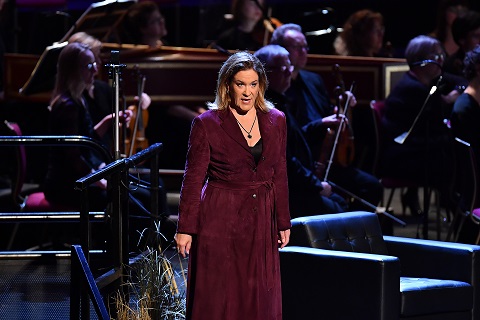 Alice Coote performs the role of Vitellia in Mozart’s La clemenza di Tito with the Orchestra of the Age of Enlightenment under conductor Robin Ticciati. Photo credit: Chris Christodoulou.
Alice Coote performs the role of Vitellia in Mozart’s La clemenza di Tito with the Orchestra of the Age of Enlightenment under conductor Robin Ticciati. Photo credit: Chris Christodoulou.
Vitellia is a role that Alice Coote seems to have been born to play, a complex character whom we don’t quite love but can understand. Coote really brought out Vitellia’s conflict of emotions, and in each utterance we could see and hear the play of emotions across her face and her voice. Some of the role lies quite high for a mezzo-soprano, but Coote never made us feel she was going outside the role the extremes of range (high and low) were representative of the extremes of emotion. But there was also much quiet, beautiful singing; this Vitellia was more than just a scheming bitch. Coote crowned the performance with a stunning final accompanied recitative, where each word was strongly coloured, leading to a tormented account of ‘Non, piu di fiori’. This had Coote’s trademark flexibility of phrasing and use of rubato, but always in the service of heightening the emotion. And she was superbly partnered by the solo basset-horn. Interestingly I had previously seen Coote as Sesto, and wondered how many mezzo-sopranos have played both roles.
The only soprano in the cast, Joelle Harvey was a demure but strong-minded Servilia. Harvey showed that pure tone and beautiful phrasing could be combined with real strength of character. Servilia is one of the few admirable characters in the opera, and Harvey made it show. She was finely partnered by Michèle Losier’s Annio. Like Anna Stephany, Losier created Annio as a believable, rather intense and serious young man. And made him count as a character, rather than just a dry run for Sesto. Michèle Losier and Joelle Harvey made Annio and Servilia’s Act One duet profoundly touching.
Tito’s arias are some of the most conventional in the opera. Richard Croft was not unstylish, but his singing was very vibrant with a great sense of drama rather than classical poise. It was very much in those recitatives that he really made the character felt. Clive Bayley was a highly characterful and easily dislikeable Publio, definitely a career politician on the make. And Bayley sang Publio’s aria with vivid vigour.
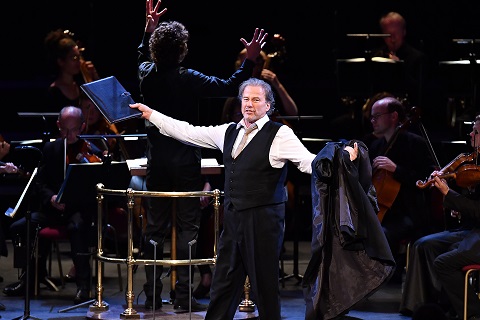 Richard Croft performs the role of Titus in Mozart’s La clemenza di Tito with the Orchestra of the Age of Enlightenment under conductor Robin Ticciati Photo credit: Chris Christodoulou.
Richard Croft performs the role of Titus in Mozart’s La clemenza di Tito with the Orchestra of the Age of Enlightenment under conductor Robin Ticciati Photo credit: Chris Christodoulou.
One of the striking features of librettist Caterino Mazzola’s adaptation of Metastasio’s libretto (done to Mozart’s instruction), is the introduction of many duets, trios and ensembles. And Mozart’s use of them make the drama really progress. It was noticeable in this performance ow the cast used the ensembles dramatically. So that both trios told a real story, and the astonishing ensemble which concludes Act One was positively gripping.
The Glyndebourne Festival Chorus was on strong form, singing Mozart’s choruses with power and style. But, in the context of a stripped back staging their use of Peter Sellers-like hand choreography was somewhat puzzling.
Robin Ticciati conducted a lithe and lively account of the score, but he was not averse to slowing down and allowing highly expressive phrasing from the singers. The Orchestra of the Age of Enlightenment was on strong form, producing a nice mix of drama and sophistication.
Mozart’s penultimate opera can still sometimes seem something of a misunderstood ugly duckling, its reversion to opera seria an aberration after the trio of operas with Lorenzo da Ponte. The opera’s message of clemency is very much an Enlightenment concept which does not always sit well with modern directors. But Glyndebourne fielded a well balance cast, and all contributed to a performance which, musically at least, took the opera seriously and conveyed intense emotions with great style.
Robert Hugill
Mozart: La clemenza di Tito
Glyndebourne Opera at the BBC Proms
Sesto: Anna Stéphany, Vitellia: Alice Coote, Tito: Richard Croft; Annio: Michèle Losier, Servilia: Joelle Harvey, Publio: Clive Bayley
Conductor: Robin Ticciati, Orchestra of the Age of Enlightenment
Royal Albert Hall, London; Monday 28 August 2017
image=http://www.operatoday.com/Anna%20Stephany%20Proms%20Glyndebourne.jpg image_description=Prom 59: La clemenza di Tito, Glyndebourne Festival Opera and the Orchestra of the Age of Enlightenment product=yes product_title=Prom 59: La clemenza di Tito, Glyndebourne Festival Opera and the Orchestra of the Age of Enlightenment product_by=A review by Robert Hugill product_id=Above: Anna Stéphany performs the role of Sextus in Mozart’s La clemenza di Tito with the Orchestra of the Age of Enlightenment under conductor Robin Ticciati at the BBC Proms.Photo credit: Chris Christodoulou
August 29, 2017
Rossini’s Torvaldo e Dorliska in Pesaro
Already before Torvaldo e Dorliska Rossini had three of his major comedies under his belt (La pietra del paragone, L’italiana in Algeri and Il turco in Italia) and two successful tragedies (Tancredi and Elisabetta).
But Torvaldo e Dorliska is a dramma semiseria — a horse of a quite different color. The genre can stretch finally into operas like maybe Don Giovanni and Rigoletto, but in Rossini’s oeuvre it did not engender any enduring Rossini masterpieces, as have comedy and tragedy — the 2015 Pesaro production of La Gazza Ladra, Rossini's only other semiseria, directed by Damiano Michieletto, definitively finished off its bid for masterpiece status.
Strict semiseria genre norms require a basso buffo, and Torvaldo and Dorliska obliges with the Duke of Ordow, played just now by none other than Nicola Alaimo, Pesaro’s recent William Tell. Mr. Alaimo is a performer of stature and of great presence, and is a powerful singer who evokes sympathy. These attributes confused this current Pesaro edition of,Torvaldo e Dorliska (a remount of its 2006 production directed by Mario Martone).
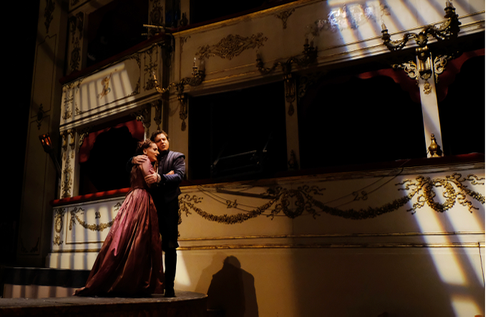 Salome Jicia as Dorliska, Dmitry Korchak as Torvaldo
Salome Jicia as Dorliska, Dmitry Korchak as Torvaldo
The Duke of Ordow is smitten by Dorliska, recently married to Torvaldo whom the Duke assumes his thugs have murdered. Not so. The wounded Torvaldo is taken into the Duke’s castle by its gatekeeper. Meanwhile Dorliska, abducted into the castle, is slapped around by the Duke to try to get her to marry him. Everyone rebels against the Duke for various reasons and he is led off to prison.
After all that we were quite confused as we had come to like Mr. Alaimo even though everyone on stage hated him.
Director Mario Martone and his designer Sergio Tramonti set this Polish tale somewhere with lots of thick foliage, all the better to mask his thugs as they came and went, and finally hide the revolutionaries as well. The setting had all the atmospheres of incipient Romanticism. But Rossini’s libretto was largely a farce of the type that plays best under bright lights.
Besides the un-Romantic brutal slapping of Dorliska Mr. Martone offered some extreme, un-Romantic schtick as well — Ormondo, the Duke’s lieutenant climbs a tree singing his aria, and falls out still singing (he was caught by his friends), and as the revolutionary movement gained momentum thousands of "Viva Rossini" leaflets rained down upon us from the auditorium's rafters.
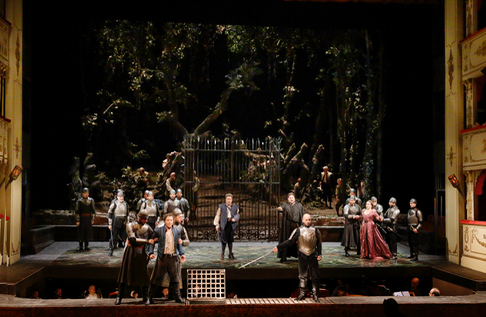 The entire cast in the Act II finale
The entire cast in the Act II finale
As usual in Pesaro there were fine singers who created this evening of pure delight. Of particular note was young Georgian soprano Salome Jicia as Dorliska who raged and spat in secure Rossinian language, and Russian tenor Dmitry Korchak who delivered Torvaldo with aplomb though missing was an innocence and charm we might have liked in this young lover. Pesaro regular, bass Carlo Lepore convinced us as the duplicitous gatekeeper (we sympathized with his employer). A former participant in the Pesaro’s Accademia Rossiniana, baritone Filippo Fontana was the soldier who fell out of the tree singing.
The greatest pleasures of the evening were being in the Teatro Rossini, a typical Italian horseshoe theater of perfect size for minor Rossini, the able orchestral playing of the Orchestra Sinfonica G. Rossini under conductor Francesco Lanzillotta who found the real Rossini, and most of all it was a lot of fun to have the opportunity to explore the ideals and the potential of opera semiseria in this production of undeniable charm.
Michael Milenski
Cast and production information:
Duca d’Ordow: Nicola Alaimo; Dorliska: Salome Jicia; Torvaldo: Dmitry Korchak; Giorgio: Carlo Lepore; Carlotta: Raffaella Lupinacci; Ormondo: Filippo Fontana. Coro del Teatro della Fortuna M. Agostini; Orchestra Sinfonica G. Rossini. Conductor: Francesco Lanzillotta; Regia: Mario Martone; Scene: Sergio Tramonti; Costumi: Ursula Patzak; Luci: Cesare Accetta. Teatro Rossini, Pesaro, August 18, 2017.
Michael Milenski
Cast and production information:
image=http://www.operatoday.com/Torvaldo_Pesaro1.png
product=yes
product_title=Torvaldo e Dorliska in Pesaro
product_by=A review by Michael Milenski
product_id=Above: Nicola Alaimo as the Duke of Orlow, Salome Jicia as Dorliska [All courtesy of the Rossini Opera Festival]
August 28, 2017
Jakub Hrůša : Bohemian Reformation Prom
Hrůša started with the Hussite hymn Ktož jsú boží bojovníci (Ye Who Are Warriors of God), the men of the BBC Singers singing without accompaniment. Though we rarely hear the hymn as hymn, its tune is familiar. Smetana used it in Má vlast, quoting it in the section Tábor which we heard here, the town of Tábor being a Hussite fortress. Thus the quiet, tense introduction, developed through brass and timpani, which grows bolder as the hymn emerges. Triumphant climaxes and the hymn theme surges. But the Hussites were annihilated. Thus Blaník depicts the even earlier legend that St Wenceslaus, patron saint of Bohemia, will return to defend the nation. Smetana, writing at a time when Bohemia was ruled by the Hapsburgs, drew connections between the tenth-century saint and the Hussites. The strong angular themes in Tábor return in even greater glory in Blaník: massive drum rolls and crashing cymbals
In 1938, Czechoslovakia was annexed by Germany, with the implicit approval of Britain in 1938. Bohuslav Martinů's Polní mše, H. 279 Field Mass (1939) was written for Czech exiles fighting with the French against the Germans. Thus the strange instrumentation, with brass and percussion employed to suggest the idea of performance in battlefield conditions. Drum rolls, marching rhythms, trumpet calls and a chorus of male voices. But also piano and harmonium and a part for baritone soloist beyond the scope of an average amateur. Fortunately, in Svatopluk Sem, we heard one of the most distinctive voices in the repertoire. Sem is a stalwart of the National Theatre in Prague, well known to British audiences for his work with Jiří Bělohlávek who transformed the way Czech music is heard in this country. Sem delivered with great authority, imbuing the words with almost biblical portent. His text is based on poetry by Jiří Mucha, who was soon to marry Vítezslava Kaprálová. Her Military Sinfonietta (1937) would have worked well in this programme, though it doesn't include a part for choir.
In Martinů's Field Mass, the choir acts as foil to the soloist, voices in hushed unison, mass (in every sense supporting the individual. Though their music is relatively straightforward Miserere, Kyrie and psalm, this simplicity enhances the idea of mutual support, reflecting the relationship between piano with harmonium, voices and soloists surrounded by atmospheric percussion and brass. The version we heard at this Prom is the new edition by Paul Wingfield.
Somewhat less spartan instrumentation for Dvořák's Hussite Overture O67 (1883) though the hymnal purity of the anthem rings through clearly. The rough hewn faith of the Hussites doesn't support exaggeration. Full crescendos and running figures, (piccolo and flutes) flying free from the fierce "hammerblows"of the hymn. A glowing finale, from the BBC SO in full flow. The pounding rhythms of the Hussite hymn come to the fore in the Song of the Hussites from the opera The Excursions of Mr. Brouček to the Moon and to the 15th Century. Here the reference to the hymn is used for satire, contrasting the morality of the Hussites with the depravity of modern life, represented by the feckless, drunken Mr Brouček. To conclude this huge, ambitious programme,
Josef Suk's Prague op 26 (1904), in a tribute to Jiří Bělohlávek who made the BBC SO one of the finest Czech orchestras outside Czechia. The same goes for the BBC Singers who sing Czech pretty well. The piece was written at a dark time in Suk's life, after the death of his wife Ottilie and father-in-law Antonin Dvořàk. It connects to Suk's Asrael Symphony (op 27, 1905) and even to The Ripening (op 34, 1912-7). All three pieces deal with death, made almost bearable by faith, despite extreme grief.In Suk's Prague, the Hussite hymn makes an appearance as a symbol of something that lives on beyond temporal restraints., Suk seems to be surveying the city he loved, contrasting its history of struggle with his present. Perhaps, as he looked out on the castle, cathedral and the Rudolfinium, he could position his sorrow in a wider context. People die, but cultures remain. That's why I feel so strongly that the BBC Marketing term "Bohemian Reformation" is a crock. There''s a lot more to heritage than simplistic nationalism. Hrůša conducted Suk's Prague with such intensity, that the performance eclipsed all else in an evening filled with high points.
Jakub Hrůša's belated Proms debut but he is one of the most exciting conductors around, full of character and individuality. Though he's young, he's extremely experienced, and at a high level. In the UK, he's conducted at Glyndebourne and with the BBC SO and the Philharmonia, where he becomes Chief Guest Conductor next season. He is a natural in Czech repertoire, and a possible successor to Bělohlávek, whose memorial he conducted in Prague, but he's also very good in other material. Definitely a conductor to follow
Anne Ozorio
image=http://www.operatoday.com/Jakub_HrOAa_c_Pavel_Hejnz_02.jpg
image_description=Prom 56: Jakub Hrůša with the BBC Symphony Orchestra
product=yes
product_title=Prom 56: Jakub Hrůša, Svatopluk Sem, BBC Symphony Orchestra, BBC Singers - Hussite Hymn, Smetana, Martinů, Dvořák, Janáček and Josef Suk. Royal Albert Hall, London, 25th August 2017
product_by=A review by Anne Ozorio
product_id=Above: Jakub Hrůša
Photo credit: Pavel Henjý
Wozzeck at the Salzburg Festival
And there’s more recent stuff, much more, mostly multi channel video and sound installations around the world that I won’t see
All of Mr. Kentridge’s disciplines come into play in his opera productions, providing this prolific artist a rich palate of expressive tools. Though basically it’s abstract black lines, and silhouettes, symbolic images, and fragmented squares (still or moving images or playing areas) on a stage face plane that is his hyperbolic canvas. It is one dimensional.
Given Mr. Kentridge’s prestige he works with only the most prestigious, i.e. rich opera companies, thus his productions are supplied with first rank artists, conductors and orchestras, and the most expert technical assistance.
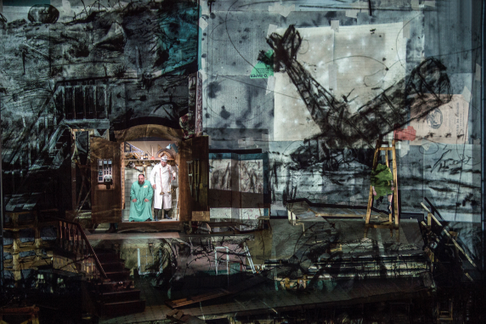 Matthias Goerne as Wozzeck, Jens Larsen as the Doktor
Matthias Goerne as Wozzeck, Jens Larsen as the Doktor
Of his operatic oeuvre, Wozzeck is his masterpiece, the precision of the opera’s focus, and the velocity of dénouement make quick and pointed use of his techniques. We had little time to tire of them, and given the subject matter they were not trite. It was an artistic success of image to music.
The program booklet informed us that Berg’s Wozzeck was born of the first world war, and composed in the shadows of its human devastation, thus the most powerful of the progression of projected images that captivated our interest (while Buchner’s tragedy unfolded below) was a huge WWI gas mask (not shown in photos).
This Wozzeck therefore did not dwell on the accumulation of the heady human tragedies of Wozzeck, Marie and the Child, but on the plethora of Kentridge images that flowed to the accompaniment of baritone Matthias Goerne’s smooth, art-song style delivery of Wozzeck’s deceptions and delirium. Mr. Goerne in fact was the surrogate William Kentridge in this production — Mr Kentridge himself is always a central feature in his stagings.
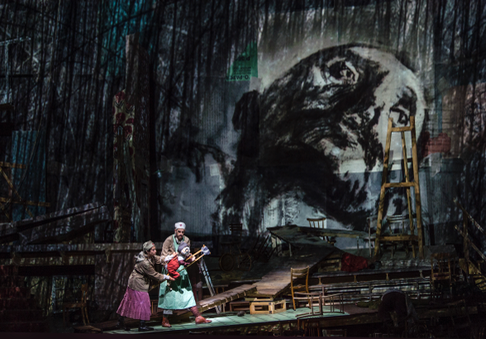 A super, the puppeteer and puppet of the child in gas mask
A super, the puppeteer and puppet of the child in gas mask
Of very great effect was the Child represented by a puppet, an image laden with metaphoric, if hackneyed possibilities. Though in addition to dehumanizing the human expressionism of Berg’s domestic tragedy the puppet troubled us greatly. Puppets don’t sing, so who was going to sing the “hop hops" of the final image?
No one did, they were played by mallets in the orchestra, the words projected on the supertitle screen.
The putrid physical and human atmospheres of Berg’s opera were smoothed over by the flow of images. This same flow obliterated the independence of scenes, the accumulation of which generally lead to the overwhelming effect of Marie’s murder, Wozzeck’s suicide and the Child’s isolation.
The Vienna Philharmonic in the pit of the medium sized Haus für Mozart theater brought an overwhelming presence to Berg’s score. But the vaunted orchestral signposts were obliterated by the incessant flow of images. Moments when you ached to sink into Berg’s abstract musico-dramatic world rushed by so quickly you only reacted to them after the fact. Was this the intention of conductor Vladimir Jurowski, or was he a victim of the production?
Michael Milenski
Cast and production information:
Matthias Goerne: Wozzeck; John Daszak: Drum Major; Mauro Peter: Andres; Gerhard Siegel: Captain; Jens Larsen: Doctor; Tobias Schabel: First Apprentice; Huw Montague Rendall: Second Apprentice; Heinz Göhrig: Madman; Asmik Grigorian: Marie ; Frances Pappas: Margret. Salzburger Festspiele und Theater Kinderchor; Concert Association of the Vienna State Opera Chorus ; Vienna Philharmonic; Angelika-Prokopp-Sommerakademie der Wiener Philharmoniker. Vladimir Jurowski: Conductor; William Kentridge: Director; Luc De Wit: Co-Director; Sabine Theunissen: Sets; Greta Goiris: Costumes; Catherine Meyburgh: Video Compositor & Editor; Urs Schönebaum: Lighting . Haus für Mozart, Salzburg, August 24, 2017.
image=http://www.operatoday.com/Wozzeck_Salzburg1.png
product=yes
product_title=Wozzeck at the Salzburg Festival
product_by=A review by Michael Milenski
product_id=Above: Matthias Goerne as Wozzeck, Asmik Grigorian as Marie, dead [All photos copyright Salzberger Festspiele / Ruth Walz]
August 27, 2017
Lear at the Salzburg Festival
There remain in my mind indelible images from the San Francisco performances. Ponnelle used a stage wide, brush-filled heath against a black void (an antique, under-stage hydraulic system was revived to vary heights of this floor). The storm raged with the bare pipes of the fly system in chaotic motion. And the rages of Mme. Dernesch’s Goneril remain a vivid memory as well. I know of no other productions of the Reimann Lear in the U.S.
In San Francisco it was sung in English, though this was before supertitles came into general use. Without a clear text in front of you the prodigious subtleties of the Reimann score were (dare-we-say) vaguely felt rather than dramatically understood.
Thus this Salzburg Festival revival of Reimann’s cold-war masterpiece, now with subtitles in both German and English, was a musical and dramatic revelation. It is a nearly precise reading of Shakespeare’s play, but in musical terms, and those chosen by composer Reimann are bleak and brutal and ugly. Like Zimmermann’s famed Die Soldaten (1965) Lear throbs with threat, fear and remorse. It is unrelenting, and there is no salvation.
Both operas respond mightily to Germany’s position as the epicenter of the cold-war, and to its enduring guilt for the two twentieth century world-wars.
Now we are in the twenty-first century, and most of us decline to bear the guilt of our fathers. Reimann’s Lear can now finally exist on purely artistic terms. It is a magnificent orchestral score that takes us on a journey into a human hell, an experience we can bear only with the protection of high art. It is not for the faint of heart, or art for that matter.
And for the Salzburg Lear there is no place more accommodating than Salzburg’s old riding school, the Felsenreitschule, its massive galleries carved into the solid cliff of granite that is the backdrop for this space now used as a theater. For Lear there is no more fitting orchestra than the magnificent forces of the Vienna Philharmonic, including a side gallery stuffed with massive additional percussion.
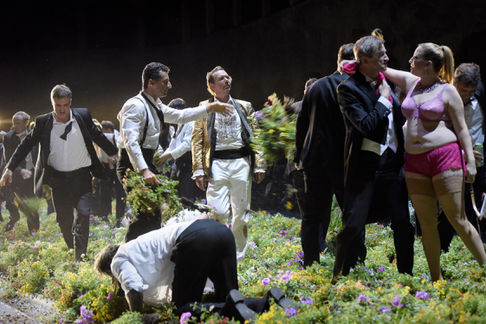
Michael Maertens as the Fool (speaking role) with Lear's knights (chorus and supers)
No longer considered a parochially German experience, it was staged by Australian theater and film director Simon Stone. Like Ponnelle in Munich the action occurred on a single platform, first it was a heath of fresh flowers, then it became a pure white slab with a pool of blood. It was staged as theater in the round, several hundred people sitting below the empty galleries behind the platform.
There followed one coup de theatre after another — the flowered heath was ruthlessly torn out by Lear’s knights; rain poured down for the duration of the storm; Mickey Mouse appeared on the stage; spectators behind the platform were torn out of their seats and thrown into the pool of blood; the hundreds of spectators sitting behind the platform, suddenly symbolic victims of war, were brutally driven out of the theater; a full-stage surround of white film cloth dropped to create a massive, heroic hospital space for Lear and Cordelia’s death.
I don’t think I’ve given too much away (and spoiled it for anyone) as it was a site specific event, surely impossible to re-produce elsewhere.
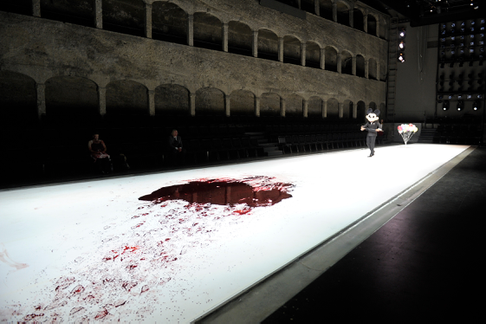
Lauri Vasar as the Duke of Glouchester in Mickey Mouse head cover
Cleveland Symphony conductor Franz Welser-Mõst urged and controlled rhythmic and harmonic contortions that flowed and over-flowed with ultimate Shakespeare’s cruelty. The stage resources equalled the pit resources in this production of massive size and daunting complexity.
Canadian born, British baritone Gerald Finley suffered willingly and mightily in a somewhat small scale, very sympathetic, human portrayal of Lear, Dresden Opera’s Evelyn Herlitzius again proved herself a singing actress of surpassing power as Goneril (she was Patrice Chéreau’s Elektra at the Aix Festival). Estonian baritone showed himself as an accomplished dancer in his vivid portrayal of the blinded Glouchester, and German counter-tenor Kai Wessel made great effect as Glouchester’s son Edgar, the tragedy’s only survivor.
The Salzburg Festival was obviously committed to making this an important theatrical and musical event. The assembled cast achieved this goal dramatically and vocally, and the production team arrived at its theatrical brilliance with amazing technical finesse.
Michael Milenski
August 22, 2017. Cast and production information above
Gerald Finley: König Lear; Evelyn Herlitzius: Goneril; Gun-Brit Barkmin: Regan; Anna Prohaska: Cordelia; Lauri Vasar: Graf von Gloster; Kai Wessel: Edgar; Charles Workman: Edmund; Michael Maertens: Narr; Matthias Klink: Graf von Kent; Derek Welton: Herzog von Albany; Michael Colvin: Herzog von Cornwall; Tilmann Rönnebeck: König von Frankreich; Franz Gruber: Bedienter; Volker Wahl: Ritter.
Konzertvereinigung Wiener Staatsopernchor, Weiner Philharmoniker.
Franz Welser-Möst: Musikalische Leitung;
Simon Stone: Regie
; Bob Cousins: Bühne
; Mel Page: Kostüme
; Nick Schlieper: Licht;
Christian Arseni: Dramaturgie. Felsenreitschule, Salzburg, August 23, 2017
image=http://www.operatoday.com/Lear_Salzburg1.png
product=yes
product_title=Lear at the Salzburg Festival
product_by=A review by Michael Milenski
product_id=Above: Gerald Finley as Lear, Anna Prohaska as the ghost of Cordelia at the death of Lear [All photos copyright by the Salzburger Festspiele / Thomas Aurin]
August 26, 2017
Ariodante at the Salzburg Festival
Handel opera productions are famously fraught with troubling decisions — which voices to use, which gender to use for which voices, which dances to use from which opera. Sometimes decisions are made for you. Like, for example, Handel had no choice but to use the Covent Garden theater back in 1735 for his Ariodante, and to use an imposed roster of singers, and to use French choreographer Marie Sallé’s troupe of dancers.
The abstract story telling of the Handel operas indeed offer stage directors rich possibility for imagining context. For example the metteur en scène, Richard Jones, of the 2014 Aix Festival production of Ariodante illuminated its dramaturgical depths by placing the action within the fundamental Christian values (and confines) of the American Midwest.
But in Salzburg German stage director, Christof Loy, took everything at absolute face value -- it was Handel's opera as it was, through post-modern lens. As givens he had a producer (general director) of impeccable taste (Cecilia Bartoli) for the casting, one of the world’s foremost artists as his Ariodante (Cecilia Bartoli), and an unlimited budget for Salzburg’s splendidly equipped Haus für Mozart theater.
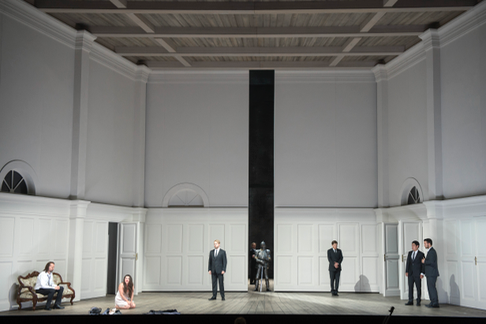 Nathan Berg (The King of Scotland), Kristofer Lundin (Odoardo), Christophe Dumaux (Polinesso), Sandrine Piau (Dalinda)
Nathan Berg (The King of Scotland), Kristofer Lundin (Odoardo), Christophe Dumaux (Polinesso), Sandrine Piau (Dalinda)
Like the 1735 production at Covent Garden, Mr. Loy’s production was not modest. It had multiple scene changes. A basic neoclassical room opened up from time to time to reveal elaborately painted Rococo scenes, and once it opened to reveal a shockingly huge room (it was elaborately forced-perspective architecture). As well there was an elaborately blank wall that descended mid-stage from time to time to obliterate all sense of physical location.
Though back in Aix Handel’s interpolated dance music became the erotic pole dancing of the U.S. prohibition era, the dances just now in Salzburg were simply highly stylized movements in mimic of the interlude ballets of French Baroque theater, the dancers dressed in French court dress of the time (including elaborate wigs).
Handel’s Ariodante was a castrato, Instead Mr. Loy’s Ariodante in Salzburg was a mezzo-soprano. He was Mme. Bartoli, and that provoked more than the usual play of gender confusion given this diva’s fame and repertory. It was a confusion easily solved by Christof Loy and Cecilia Bartoli as Ariodante reappeared after his failed suicide as partly female (see photo above), a transition that continued into the final scene where la Bartoli lost her beard as well (but she did, amusingly, maintain her exquisite trouser role imitation-male movement).
In turn, of course, Ariodante’s damsel Ginevra had donned boots and a jacket for the final scene with Ariodante to assume some genial male characteristics. The conceit quite evidently was that there was finally a union of male and female, at once completing human complexities of the two individual human psyches, and dramatically wrapping up the story in marital union. [In Aix Ginevra was last seen hitching a ride, alone, to Toronto.]
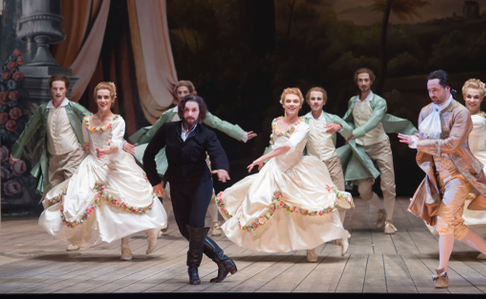 Cecilia Bartoli (Ariodante), Christophe Dumaux (Polinesso), dancers
Cecilia Bartoli (Ariodante), Christophe Dumaux (Polinesso), dancers
But finally it remained certain that the magnificent Bartoli had always been la Bartoli and never Ariodante.
Lost in the marvels of the Baroque’s psychological affects, elaborate Baroque vocal ornamentation, and the glories of the Baroque orchestral palate it did not matter where we were. And certainly it could not matter to the seven singers of the opera where they might find themselves either. Thus sometimes the actors were in simple contemporary dress, sometimes in current formal attire, sometimes in Baroque period costumes. What’s more, the Polinesso Lurcanio duel was fought in head-to-foot knightly armor. This play of costumes obliterated all sense of story and took us directly into the singers’ psyches.
Most of all stage director Loy indulged the famed indulgent smile of the Renaissance poet Lodovico Ariosto, the author of the stanzas of his epic Orlando Furioso from which the tale is taken. Like Ariosto we too, together with the evening's singers indulged these chivalric characters in their wishes and disappointments, their plotting and undoing, their anger and joy, their deceits and generosity, their weaknesses and strengths. Etcetera.
There was no place, and time stood still. This was our shared joy with the artists in this remarkable production.
Early music conductor Gianluca Capuano wrenched every possible nuance of tone from the truly splendid voices of Les Musicians du Prince, a new orchestra in the service of Albert II of Monaco founded by Cecilia Bartoli.
La Bartoli amazed us with magnificent ornamentation in Ariodante’s drunkenness and then spellbound us in his extended lament, only to amaze us even more more in her final aria of joy. American soprano Kathryn Lewec met her halfway, enthralling us in her extended laments and thrilling us in her joy. The villains of this operatic extravaganza were both French [!], Sandrine Piau made Dalinda vividly if blindly in love with Polinesso, charmingly and wittily sung — breathtaking coloratura — by countertenor Christophe Dumaux. Rolando Villazón brought huge presence to Ariodante’s brother Lurcanio, nailing his second act aria “Il tuo sangue, ed it tuo zelo” but later fought vocal distress. Canadian bass Nathan Berg suffered mightily and exulted greatly as the King of Scotland. His able leutenant was sung by Swedish tenor Kristofer Lundin.
Norwegian National Ballet choreographer Andreas Heise threw some very witty twenty-first century steps and poses into his sort of convincing facsimile of French Baroque dance. Set design by Johannes Leiacker, costume design by Ursula Renzenbring, and lighting by Roland Edrich provided the utmost in measured teutonic theatrical chic to this magnificent production.
Michael Milenski
August 22, 2017. Cast and production information above
image=http://www.operatoday.com/Ariodante_Salzburg1.png
product=yes
product_title=Ariodante at the Salzburg Festival
product_by=A review by Michael Milenski
product_id=Above: Cecilia Bartoli as Ariodante [All photos copyright by the Salzburger Festspiele / Marco Borrelli]
August 24, 2017
Cadogan Hall and soprano Nazan Fikret present Grenfell Tower Benefit Concert
BBC Radio 3’s Petroc Trelawny presents a concert in two parts on 17 September at 6pm at Cadogan Hall. The first half will include solo songs by Schubert, Schumann, Strauss and Quilter, followed by the Super Orchestra, conducted by Edward Gardner, accompanying Ailish Tynan and Christine Rice in the ‘Evening Prayer’ from Humperdinck’s Hänsel und Gretel, an extract from Wagner’s Tristan und Isolde sung by Stuart Skelton and Lee Bisset, the Quartet from Rigoletto, and the full company singing the Sanctus from Fauré’s Requiem.
Part Two will be launched with a performance of ‘I’ll Sing’ by award-winning composer Rebecca Dale, and will progress via Mozart’sCosì fan tutte, Le nozze di Figaro and Die Zauberflöte, to Puccini’s Tosca with Natalya Romaniw singing ‘Vissi d’arte’, and Keel Watson and Gweneth-Ann Rand performing ‘Bess, you is my woman now’ from Gershwin’s Porgy and Bess. The pick of today’s most promising young singers will perform Vaughan Williams’ Serenade to Music.
This is a one-off event and everyone involved has given their services for free. To ensure that the funds raised by the Grenfell Tower Benefit Concert reach those that are in most need, the concert organisers and Cadogan Hall, in consultation with London Emergencies Trust, have decided to distribute the funds equally between Rugby Portobello Trust (Charity No 11000143) and Grief Encounter (Charity No 1101277) which focus specifically on helping the affected families with rehabilitation and looking to the future.
Singers will include: sopranos Lee Bisset; Francesca Chiejina; Samantha Crawford; Nazan Fikret; Janis Kelly; Louise Kemény; Anna Patalong; Gweneth-Ann Rand; Natalya Romaniw; Kirsty Taylor-Stokes; Ailish Tynan; Jennifer Witton; Lauren Zolezzi; mezzo-sopranos Katie Grosset; Anna Huntley; Maria Jagusz; Héloïse Mas; Christine Rice; countertenor Jake Arditti; tenors Luis Gomes; Robert Lewis; Stuart Skelton; Jack Swanson; baritones Gary Griffiths; Martin Häßler; Benedict Nelson; Alan Opie; Joseph Padfield; Ricardo Panela and bass-baritone Keel Watson.
They will be accompanied by several pianists including: Eugene Asti; Dylan Perez; Michael Pugh; Linnhe Robertson and Susanna Stranders.
Conductors Edward Gardner, David Angus, Douglas Boyd, Richard Hetherington, Matthew Morgan and James Sherlock, among others, will lead the Super Orchestra composed of players from the leading London orchestras including the Philharmonia, Royal Opera House Orchestra and Royal Philharmonic Orchestra.
Further information can be found at: http://www.cadoganhall.com/event/grenfell-tower-benefit-concert-170917/
image=http://www.operatoday.com/Nazan%20Fikret.jpg
image_description=Grenfell Tower Benefit Concert, Cadogan Hall, 17 September 2017
product=yes
product_title=Grenfell Tower Benefit Concert, Cadogan Hall, 17 September 2017
product_by=
product_id=Above Nazan Fikret
Photo credit: Raphaelle Photography
August 23, 2017
Glimmerglass Being Judgmental
Justice Ruth Bader Ginsberg, one of three characters in S/G was in attendance at all four main stage productions of the weekend, and of course was on hand for Wang’s enchanting 60-minute opera about her unlikely friendship with Justice Antonin Scalia. The sold-out house repeated a scenario of most other performances she attended: When Notorious RBG was recognized a smattering of applause built in intensity until it culminated in a vociferous standing ovation for the legendary jurist.
It was basking in the afterglow of this unique preshow moment that the curtain rose on Scalia/Ginsberg. Or rather didn’t rise, since there was no curtain. With Porgy and Bess having ended barely 60-minutes prior, the setting was of utmost simplicity: a black curtain isolating the apron of the stage, two easy chairs, a table and some stacks of books on the floor. And not only was that all that was needed, it freed director Brenna Corner to be endlessly creative coaching and blocking with her talented cast.
William Burden does not have quite the right look for the swarthy Scalia, but his acting more than compensated, capably suggesting the irascible personality. And, my, what singing! Mr. Burden has one of the most engaging lyric tenors in the business and composer Wang has crafted some flights of fancy above the staff that found him in excellent form. Bill is also a master of comic delivery and his patter and one-liners (Pure applesauce among them) landed every time.
Young Artist Mary Beth Nelson was picture perfect as Ginsberg, and she sang with virtuosic abandon. Wang has given his mezzo some extremely challenging florid singing all over the range and Ms. Nelson tossed it off with joyous flair and assured beauty of tone. In more reflective moments Mary Beth displayed a lovely range of vocal coloring that ranged from teasing to touching. Too, she was occasionally asked to cross over into a pop-blues delivery that she managed with such conviction and acumen, she prompted raucous shouts of approval from the house.
Joining these two highly accomplished performers, another Young Artist, Brent Michael Smith more than held his own as The Commentator. The composer devised this role as a sort of latter day Starkeeper (Carousel) who challenges and prods the Justices, and loosely ties matters together and keeps them moving forward. Mr. Smith not only has a substantial bass-baritone of considerable accomplishment, but he has maturity of delivery and a capacity for humor that make him a distinct asset to this or any other production. Just watch Brent fidget his way around a joking delivery or moonwalk his way across the stage, and you realize you can’t take your eyes off him lest you miss whatever inspired business he might do next.
Briefly put, The Commentator challenges Scalia to account for his rulings and seals the exits, amusingly done by leaning in two American flags at the top of the stairs to the audience level stage left and right. Scalia is challenged to pass three tests of vague definition and threat. Justice Ginsberg breaks in with an amusing entrance aria. When asked how she got past the sealed doors, she quips I have broken through a ceiling before.
Ginsberg first defends, then joins Scalia in his attempt to “explain himself” to The Commentator. Derrick Wang has exhaustively researched and annotated the many quotes that comprise his libretto and he has musicalized it with heart, levity, and occasional pastiche. At times there are so many clever musical quotes from famous arias tumbling over each other that it seems Derrick has not so much “composed” as “assembled” select passages.
But when called upon to bring his own important voice to the fore, Wang proves highly adept at crafting exceedingly attractive phrases that really take wing, buoyed by a harmonic palette that progress inevitably and agreeably. His angular writing for the more contentious exchanges remains vocally grateful and pungently accented with well-used dissonances. In a wondrously calculated penultimate number, Burden and Nelson vocalize We Are Different, We Are One, intertwining their poised phrases with ravishing tone and poignant delivery.
The composer first wrote the piece when Justice Scalia was still living, and for this occasion has revised it effectively to acknowledge his passing. As The Commentator escorts Scalia to his eternal home, he and Ginsberg exchange touching farewells. As the opera closes, Ruth hangs black crepe on Nino’s easy chair, evoking the tribute on his chair in the Supreme Court chamber.
Pianist Kyle Naig provided the accomplished accompaniment while conductor Jesse Leong kept the performance taut and assured. This was a perfect little jewel with which to end my enjoyable time at Glimmerglass, and it is always a treat to discover an accomplished new work by a living composer. Mr. Wang is young, he is talented, and if Scalia/Ginsberg is any indication, he will give us many more enjoyable evenings in the opera house before he is done.
James Sohre
Cast and production information:
Justice Scalia: William Burden; The Commentator: Brent Michael Smith; Justice Ginsberg: Mary Beth Nelson
image=http://www.operatoday.com/i-CnQzts8-X3.png
image_description=The Glimmerglass Festival Alice Busch Opera Theater. Designed by Hugh Hardy, the theater features unique sliding walls that open prior to performances and at intermission. Photo: Karli Cadel/The Glimmerglass Festival.
product=yes
product_title=
product_by=A review by James Sohre
product_id=Above: The Glimmerglass Festival Alice Busch Opera Theater. Designed by Hugh Hardy, the theater features unique sliding walls that open prior to performances and at intermission.
Photo © Karli Cadel/The Glimmerglass Festival.
American Masterpiece Conquers Cooperstown
Francesca Zambello has had considerable success staging the piece for other notable companies, and as evidenced by this richly detailed production, she has honed her insights to a finely polished interpretation. Ms. Zambello occasionally likes to flavor her operas with musical comedy flair and it does not go amiss here.
When appropriate, she enlisted choreographer Eric Sean Fogel to lighten up the mood with well-considered moves that emerge organically from exuberant revelers. Mr. Fogel’s staged movement was not only entertaining in its own right, but also greatly deepened the violent, tragic moments by providing good contrast. The only false move was the series of woozy cakewalk kicks at the climax of There’s a Boat That’s Leavin’ Soon for New York. It seemed out of character to have a weakened, drugged up Bess this frolicsome as she is slimily lured against her will by the pimping Sportin’ Life.
Ms. Zambello’s Catfish Row is peopled by a bustling, believable vitality that communicated a powerful sense of community. When David Moody’s scrupulously prepared chorus launched into their many big choral numbers, the Thrill-o-Meter needle jumped off the charts. Francesca has built strong individual characterizations with each cast member, and has nurtured relationships that are marked by honesty and clarity. The sense of directorial focus and readily comprehensible storytelling that emerge out of this rich mosaic of dramatic moments is nothing short of brilliant.
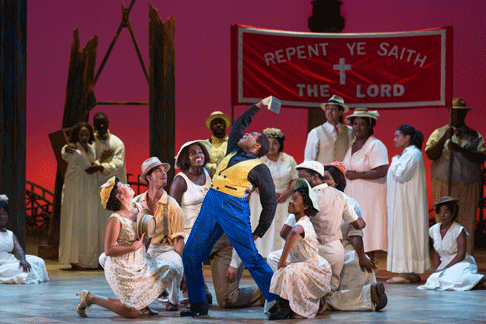 Frederick Ballentine as Sportin' Life with members of the ensemble
Frederick Ballentine as Sportin' Life with members of the ensemble
When Peter J. Davison’s imposing set is first revealed behind a front scrim, glowing hauntingly in Mark McCullough’s splendid lighting design, the audience burst into appreciative applause. Mr. Davison’s massive two story structure has rows of doors on each level, the upper balcony reached by a spiral staircase down right. This walkway extends to a large, barnlike building up left, with Porgy’s residence on ground level. A huge barn door, contained in the stage left wall, is opened and closed with import at key dramatic moments.
There is a wonderful chiaroscuro effect to the structures, the walls dotted and layered with rusting squares of sheet metal. For the storm scene, we are in a community hall with chairs and a table, defined as a huge wall flies in cutting the depth of the stage in half. Black plastic blows in the windows, augmented by Mr. McCullough’s threatening lightning. Sporadic dropping, banging and dangling of metal squares that had been “blown away” added fearful unpredictability to the chaotic effect.
The team has also “opened up” the action by flying in a partial wall and adding a bed to take us inside Porgy’s room. This allowed for a very focused private moment for both of the big duets. Another outstanding re-imagination was the conception of the Kittiwah Island setting as a neglected, gone to seed beachside amusement park. Sportin’ Life interrupts a holy roller baptism session to deliver his irreverent It Ain’t Necessarily So. To complete the dynamic look of the production, Paul Tazewell contributed the comprehensive costume design ranging from homely everyday attire, to Sunday-go-to-meetin’ finery, to splashes of garish color for Bess and Sportin’ life.
John DeMain kept things humming in the pit from the opening slashes of brass licks to the final stirring chorus. Under Maestro DeMain’s assured baton, this well-paced reading of Gershwin’s evergreen opera never sounded fresher. Having such a prodigiously talented cast sure didn’t hurt either.
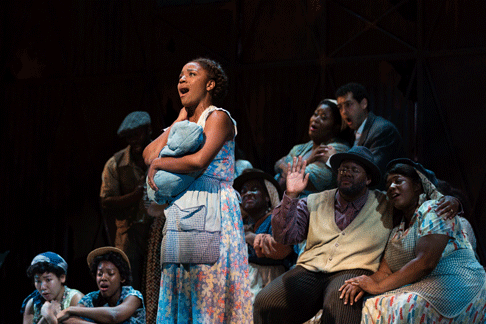 Meroë Khalia Adeeb as Clara
Meroë Khalia Adeeb as Clara
Musa Ngqungwana is such a force of nature as Porgy, with a voice of such jaw-dropping beauty, richness, and power that he just might become a household name. Practice saying Ngqungwana now, because his star is only going to go higher and higher. Musa has such a big, beaming, lovable open face that you are not quite prepared for his ferocity when he is goaded to confront evil. His painful limping gait, his superstitious negative fantasies, his loneliness, his compassion, his utter devotion to Bess; there is no aspect of this complicated role that he does not serve with uncommon distinction. If I had to comprise a short list of the show’s highlights, it would be: Whenever Musa Ngqungwana is on stage.
Talise Trevigne makes an equally strong case for Bess, bringing star power to her well-considered interpretation. Her confident, glimmering soprano beautifully encompassed some of the work’s best-known melodies. Ms. Trevigne brought committed acting to the mix, and she found all the necessary extremes to this unstable, emotionally volatile character. Her singing is pliable and expressive in all registers and volumes, and she judiciously uses her chest voice to serve the desperate lower pleas in What You Want With Bess? Talise and Musa are wonderfully paired, exuding a good chemistry. Bess, You Is My Woman Now was so heart rending to see, so ravishing to hear that I thought the show might never get going again from the prolonged, cheering ovation at its conclusion.
Norman Garrett’s incisive, booming bass and lanky, lean, mean intensity made for a knockout performance as Crown. Frederick Ballentine’s serpentine take on Sportin’ Life was relentless in his bad-ass persona. Although Mr. Ballentine’s dancing was fleet of foot and his secure tenor pleased the ear, we never forgot that beneath the cynical comic overtones in the music, there was an unrepentant, unwavering criminal. Serena has one of the most overtly “operatic” solos, and Simone Z. Paulwell’s throbbing, well-schooled soprano made My Man’s Gone Now a plangent lament marked by velvet tone and utter commitment.
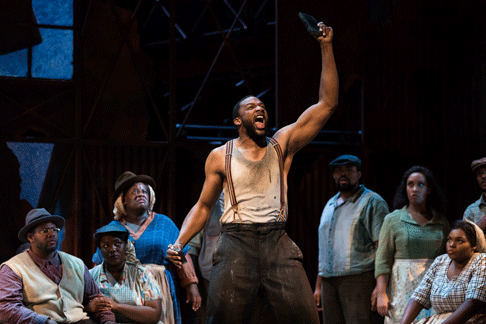 Norman Garrett as Crown
Norman Garrett as Crown
Meroe Khalia Adeeb has the most famous tune in the show, and her fresh, floated, silvery soprano made for a bewitching Summertime. Justin Austin’s honeyed baritone was well suited to the role of Jake. Chaz’men Williams-Ali has such a pleasing, vibrant tenor that it was a shame to lose him early on as the ill-fated Robbins. Happily, he snuck back in action later with a playful turn as the Crab Man. Judith Skinner struck just the right balance of brassy chest tones and cutting head voice to offer a well-rounded impersonation of Maria.
The enduring popularity of Porgy and Bess combined with the lovingly staged, magnificently performed production at hand deservedly made it a sell-out success. But I have to wonder, with all the stellar African-American talent filling the stage, where was the black audience? I wouldn’t even need to use all my fingers to count the African-Americans in the parterre seats at my performance. If opera is to sustain itself as an art form, it’s a question producers are going to have to answer. And if anyone can, my bet is on the resourceful Glimmerglass Festival.
James Sohre
Cast and production information:
Clara: Meroe Khalia Adeeb; Mingo: Steven D. Myles; Sportin’ Life: Frederick Ballentine; Jake: Justin Austin; Serena: Simone Z. Paulwell; Robbins: Chaz’men Williams-Ali; Jim: Nicholas Davis; Peter: Edward Graves; Lily: Gabriella H. Sam; Maria: Judith Skinner; Porgy: Musa Ngqungwana; Crown: Norman Garrett; Bess: Talise Trevigne; Detective: Zachary Owen; Policeman: Brent Michael Smith; Undertaker: Calvin Griffin; Annie: Briana Elyse Hunter; Nelson: Elliott Paige; Strawberry Woman: Jasmin White; Crab Man: Chaz’men Williams-Ali; Coroner: Chris Kjolhede; Scipio: Piers Shannon; Conductor: John DeMain; Director: Francesca Zambello; Choreographer: Eric Sean Fogel; Set Design: Peter J. Davison; Costume Design: Paul Tazewell; Lighting Design: Mark McCullough; Hair and Make-up Design: J. Jared Janas, Dave Bova; Chorus Master: David Moody
image=http://www.operatoday.com/KarliCadel-GGF17-Porgy-GenDress-4625.png
image_description=Talise Trevigne as Bess and Musa Ngqungwana as Porgy in The Glimmerglass Festival's 2017 production of The Gershwins' "Porgy and Bess." Photo: Karli Cadel/The Glimmerglass Festival
product=yes
product_title=American Masterpiece Conquers Cooperstown
product_by=A review by James Sohre
product_id=Above: Talise Trevigne as Bess and Musa Ngqungwana as Porgy
Photos © Karli Cadel/The Glimmerglass Festival
Glimmerglass: Too Much to Handel?
Someone seemed to have lost about thirty minutes of music.
That does not mean the production was not exceedingly enjoyable. It most certainly was. But for Handel purists this opus may have seemed more like heavy hors d’oeuvres than a hearty main course. I am far from being a Xerxes scholar but as my seat mate said at intermission, “I enjoyed the A sections, but kept waiting for the B-A to follow.” Na, ja, I will stop talking about what I “think“ wasn’t there and focus very agreeably on what was.
Tazewell Thompson has directed the proceedings with invention, dimension and great attention to detail. Mr. Thompson finds wonderful variety in the interaction of his colorful characters, and moves the cast around with purpose and motivation. He has fostered an impetuous spontaneity in crackling confrontations, and invested more introspective musing with a brooding serenity. And it must said, he coaxed Arsamenes and Romilda into some pretty uninhibited smooching. Tazewell has been well served by his design team in creating a majestic sweep, and providing engaging visual interest that enlivened what could have been a static event.
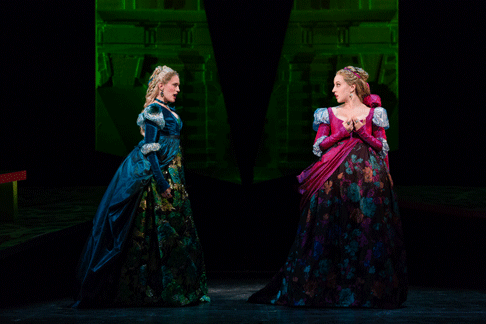 Katrina Galka as Atalanta and Emily Pogorelc as Romilda
Katrina Galka as Atalanta and Emily Pogorelc as Romilda
Set designer John Conklin has fashioned a modular concept of changeable beauty, constantly morphing configurations of floating, slightly raked platforms that are decorated with Pollock-like swirls and colors. Angled, disjointed hanging flats with architectural details in relief vie for position in Mr. Conklin’s settings, and he has anchored the whole with a floating, silver tree of life symbol. This crafty image first transforms into a piece of jealous iconography with blood red roots, then makes a cheeky commentary when it next appears, as completely upended as are Xerxes’ love relationships. The totality of his design look is underscored with popping, fire red accents of platform edges, stairs, or picture frames.
Sara Jean Tosetti has provided a truly sumptuous costume design, her lavish attire not only delighting the eye, but also tellingly defining the characters. With his accomplished lighting, Robert Wierzel was another conspicuous conspirator in the design team’s accomplishment with a sensitive, fine tuned plot of color washes and precisely calculated specials. I must also acknowledge that make-up and hair designers J. Jared Janas and Dave Bova provided another effective ‘look’ as they did for the entire Festival.
Conductor Nicole Paiement led a pulsating account of the score, brimming with inner rhythmic life and a good variety of appealing colors. Maestra Paiement found a captivating humanity in the score and inspired her accomplished soloists in turn to sensitive and propulsive vocalizing. The accommodating orchestra could not have been bettered with especial kudos reserved for the “Team Xerxes Continuo”: Katherine Kozak (Harpsichord), Ruth Berry (Baroque cello), Michael Leopold (theorbo, Baroque guitar), and Spencer F. Phillips (bassoon).
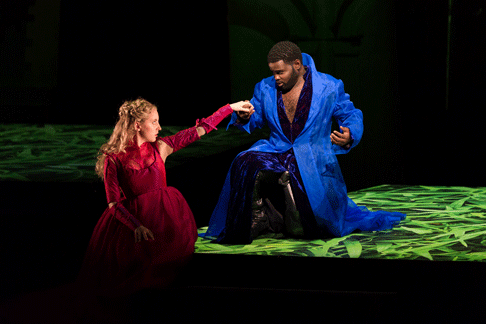 Emily Pogorelc as Romilda and John Holiday as Xerxes
Emily Pogorelc as Romilda and John Holiday as Xerxes
Counter tenor John Holiday, Jr. keeps going from strength to strength. Mr. Holiday was every bit the titular star the evening required, not only singing with haunting, piercing beauty, but also looking every inch the heroic persona. John’s handsome presence and resplendent vocalizing added up to a memorable achievement. The excitable and exciting Allegra de Vita gave him powerful chase with her fiercely sung Arsamenes. Ms. De Vita was adept at hurling out vigorous phrases replete with well-modulated coloratura, as well as possessing the skill to gently caress deeply felt legato passages.
Emily Polgorelc found a tragic nobility in Romilda and her elegant, poised vocal impersonation was an aural delight. As the sassy Atalanta, Katrina Galka regaled us with a fusillade of soprano pyrotechnics, her stylish, flexible soprano ringing out with aplomb. Bass Calvin Griffin was a sprightly Elviro possessed of charming vocal and theatrical gifts. Abigail Dock offered an empathetic, fluidly sung Amastris, her characterization enhanced by a most winning stage presence. Brent Michael Smith was the stalwart, solidly voiced Ariodates.
Maestra Paiement provided insightful program notes that informed us Handel deliberately eschewed the da capo format with some of the set pieces. Still, it often felt like something might be missing. Hey though, how often do I get to say that a Handel opera actually left me wanting more?
In the end, this exhilarating Xerxes was a summer delight so entertaining that it was over too soon.
James Sohre
Cast and production information:
Xerxes: John Holiday, Jr.; Arsamenes: Allegra de Vita; Elviro: Calvin Griffin; Romilda: Emily Polgorelc; Atalanta: Katrina Galka; Amastris: Abigail Dock; Ariodates: Brent Michael Smith; Conductor: Nicole Paiement; Director: Tazewell Thompson; Set Design: John Conklin; Costume Design: Sara Jean Tosetti; Lighting Design: Robert Wierzel; Hair and Make-up Design: J. Jared Janas, Dave Bova; Continuo: Katherine Kozak (Harpsichord), Ruth Berry (Baroque cello), Michael Leopold (theorbo, Baroque guitar), Spencer F. Phillips (bassoon)
image=http://www.operatoday.com/KarliCadel-GGF17-Xerxes-GeneralDress-1794.png
image_description=John Holiday in the title role of The Glimmerglass Festival's 2017 production of Handel's "Xerxes." Photo: Karli Cadel/The Glimmerglass Festival
product=yes
product_title=Glimmerglass: Too Much to Handel?
product_by=A review by James Sohre
product_id=Above: John Holiday as Xerxes
Photos © Karli Cadel/The Glimmerglass Festival
Glimmerglass: Well-Realized Rarity
It is a welcome discovery, chock-full of soaring melodies and surging phrases that recount the moving tale of the six burghers of Calais willing to sacrifice their lives in order to save the city and citizens they love from isolation and destruction. Rodin immortalized the burghers in his famous sculpture, of course, but Donizetti and his librettist Cammarano have also crafted a compelling work of art that is no less impressive. Perhaps its neglect is owing to the extreme interpretive demands on its trio of principal soloists, and here the company outdid itself, peopling its cast with thrilling vocalists.
Soprano Leah Crocetto stars as Eleonora, devoted wife to Aurelio, the mayor’s son missing in the swirling military action. Ms. Crocetto announced herself as a major talent in Rossini’s Maometto II at Santa Fe just a few short years ago. Since then, she has taken on Puccini and Verdi to ever-growing acclaim. With Eleonora, she returns to bel canto with riveting results.
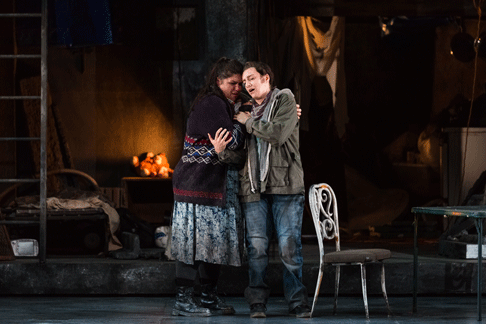 Leah Crocetto as Eleanora and Aleks Romano as Aurelio
Leah Crocetto as Eleanora and Aleks Romano as Aurelio
Not only can she sing accurate and meaningful coloratura with utmost ease, but she also has an expressive range that effectively spans from hushed whisper to raging fury and all points in between. Her generous, creamy spinto has an uncommonly fine luster and appeal, and it is wedded to a simple, sincere acting style, evoking the gifts of the great Caballe. Based on this outing, Leah Crocetto seems poised to be a major international star.
While she may be the recognizable “name” of the cast, the leading role is the activist son Aurelio, and mezzo Aleks Romano matched Crocetto note for note in virtuosity and tonal allure. First, I have never seen a woman in a trouser role look so believably manly. The petite singer is as convincing in her gender-bending as Hilary Swank in her Oscar winning turn as Brandon Teena (Boys Don’t Cry).
Ms. Romano has a searing vocal delivery, her exciting, focused tone appealingly colored by a somewhat urgent vibrato. When Aurelio is riled up (which is often), she hurls inflammatory declamations that ring thrillingly throughout the house. But when she shares loving, concerned duets with Eleonora, Aleks can hone her secure tone to a tender filigree of sound that is heart stopping in its emotional effect. There are two duets in which these two remarkable vocalists sing melting phrases in thirds that are not meant merely for human ears. As their inimitable instruments tumble over each and urge each other to ever greater emotional engagement, well, this is as good as it gets.
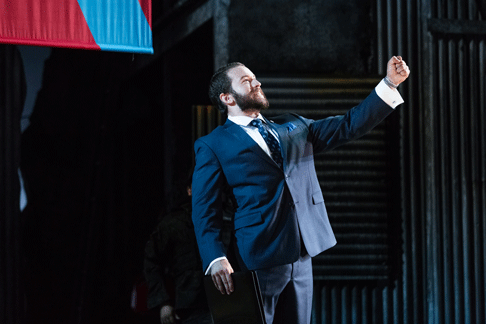 Michael Hewitt as Edoardo III
Michael Hewitt as Edoardo III
The role of mayor Eustachio de Sainte-Pierre is exceedingly well served by the imposing bass baritone, Adrian Timpau. His dark, pointed instrument served notice that a major talent has arrived on the scene. Mr. Timpau exuded vocal authority and stylistic acumen, and he mastered every trial of this difficult, lengthy assignment. Mr. Timpau joins the Met’s Lindeman program next year, and his future stardom seems all but assured. Chaz’men Williams-Ali’s ringing, plangent tenor brought much joy to the proceedings as Giovanni de Aire. His sound contributions to the extended ensembles were noteworthy.
Andres Moreno Garcia has a very pleasant, rolling baritone that made much of his brief stage time as Edmondo. Michael Hewett, a memorable Jud (Oklahoma!) the night before, successfully impersonated King Edoardo III. Mr. Hewett has a burnished baritone, which easily served up fine Donizettian style. On this occasion, his very upper register didn’t always turn over to match the ease of his upper-middle. Helena Brown’s imperious, generous soprano made a major impact as Queen Isabella. Talented young bass Zachary Owen was dramatically vested in the cameo of the English Spy, but his potent delivery sometimes pressed to veer off pitch. Joseph Leppek (Giacomo de Wisants), Carl DuPont (Armando), and Rocky Lasky (Filippo) all made solid efforts with their focused, steadfast performances.
In the pit, Joseph Colaneri whipped up a rousing interpretation of this rarity that found his orchestra responding with a vigorously theatrical, stylistically rich reading. Under Maestro Colaneri’s knowing baton, the band was a collaborative partner in the engrossing story, pairing flawlessly with the soloists and urging David Moody’s well-tutored chorus (excellent diction!) to great heights. While the entire orchestra was rightly cheered to the rafters, I have to single out the extended clarinet solo introduction to one of the major set pieces that was a thing of luminous beauty.
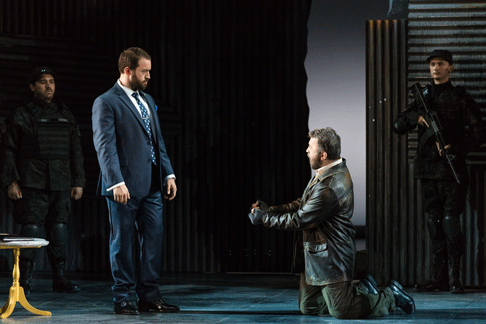 Michael Hewitt as Edoardo III and Adrian Timpau as Eustachio de Saint-Pierre
Michael Hewitt as Edoardo III and Adrian Timpau as Eustachio de Saint-Pierre
So what does this piece have to say to us in today’s context? If you are director Francesca Zambello, the answer is “plenty.” She has found great resonance in raising the plight of refugees struggling in modern day Calais, and grounding it in the ruined setting of a war torn near eastern town. The first image of James Noone’s evocative set design is seen as we take our seats: a high corrugated, jagged, barbed wire laced sheet metal barrier with “Calais” boldly graffitied onto it serves as an act curtain. A bombed out car lies in state down left.
Ms. Zambello sets her concept up effectively with a staged overture. First, soldiers patrol the fence. When the coast is clear, a desperate intruder clambers over the wall to steal food from the soldiers’ unattended knapsacks. After he is discovered and narrowly escapes, the soldiers regroup across the apron in time to sing the ringing opening chorus. The wall parts and recedes off left and right, revealing the bombed out shell of a three story building that is all too depressingly familiar a visual from the evening news.
Mr. Noone’s hulking set includes a large staircase that the director skillfully uses to create meaningful levels and stage pictures. The turntable is put to good use as it spins the structure to suggest different locales. Costume designer Jessica Jahn’s carefully selected, character specific street wear for the downtrodden, and tailored uniforms and business wear for the privileged were aptly inspired by today’s front page photos. Mark McCullough’s austere lighting design was calculated to highlight important dramatic moments, balancing well-selected specials with murky shadow effects. This was a most convincing feat of story telling, making a potent case for a forgotten 19th century opera by making it all too relevant in today’s world. By making the character relationships so intensely believable and their predicament so universally human, Francesca has even managed to gloss over the pretty big flaw in the denouement.
Edoardo has adamantly refused over and over to spare the burghers’ lives and indeed, soldiers point assault rifles menacingly at the intended targets throughout the extended penultimate ensemble. Queen Isabella has pleaded with husband Edoardo to spare them, but he unceremoniously rejects her. Musically, dramatically, the piece churns inexorably to certain tragedy. Then, in the briefest of moments that is the operatic equivalent of “honey, c’mon now. . .” Isabella gets Edoardo to say the shrugging equivalent of “Oh. . .okay.” And, basta, everyone is free. Never you mind. This talented group has such total commitment to the piece, and they believe in it so strongly, that damn if we don’t suspend our disbelief as well.
There is such a wealth of musical riches in The Siege of Calais (at least with this consummate team) that it is astonishing it has take so long to resurface. Now that the enterprising Glimmerglass Festival has emphatically demonstrated there are singers capable of handling it, and proven there are audiences ready to be thrilled by it, maybe it will find the widespread recognition it deserves.
James Sohre
Cast and production information:
Eustachio de Sainte-Pierre: Adrian Timpau; Eleonora: Leah Crocetto; Giovanni de Aire: Chaz’men Williams-Ali; Pietro de Wisants: Makoto Winkler: Aurelio: Aleks Romano; English Spy: Zachary Owen; Giacomo de Wisants: Joseph Leppek; Armando: Carl DuPont; Edmondo: Andres Moreno Garcia; Edoardo III: Harry Greenleaf; Isabella: Helena Brown; Filippo: Rocky Lasky; Conductor: Joseph Colaneri; Director: Francesca Zambello; Set Design: James Noone; Costume Design: Jessica Jahn; Lighting Design: Mark McCullough; Hair and Make-up Design: J. Jared Janas, Dave Bova; Chorus Master: David Moody
image=http://www.operatoday.com/KarliCadel-GGF17-Siege-GeneralDress-3513.png
image_description=L to R: Aleks Romano as Aurelio, Adrian Timpau as Eustachio de Saint-Pierre, Makoto Winkler as Pietro de Wisants, Leah Crocetto as Eleanora, and Chaz'men Williams-Ali as Giovanni d'Aire in The Glimmerglass Festival's 2017 production of the American premiere of Donizetti's "The Siege of Calais." Photo: Karli Cadel/The Glimmerglass Festival
product=yes
product_title=Glimmerglass: Well-Realized Rarity
product_by=A review by James Sohre
product_id=Above: L to R: Aleks Romano as Aurelio, Adrian Timpau as Eustachio de Saint-Pierre, Makoto Winkler as Pietro de Wisants, Leah Crocetto as Eleanora, and Chaz'men Williams-Ali as Giovanni d'Aire
Photos © Karli Cadel/The Glimmerglass Festival
Lady Macbeth of Mtsensk in Salzburg
Though it really was not crumbling, decaying socialist housing, it was actually a vagina shaped cavity into which thrust two phallic platforms, in and out repeatedly throughout this long, loud, gross evening.
Shostakovich’s cheeky opera meant to impress Soviet authorities with politically correct attitudes backfired at its premiere, and Shostakovich was artistically sidelined for years. Just now stage director Andreas Kriegenberg’s extreme re-imagining of the piece in monumental uber-expressionistic terms, meant as well to be politically correct and impress the sophisticated Salzburg Festival audience, backfired as well.
Without comment on current, hackneyed socio-artistic platitudes let me simply attribute the misfortune that beset Herr Kriegenberg’s production to the common cold and attendant laryngitis. Heroically voiced soprano Nina Stemme, indisposed, sang but the first two of five performances. She was replaced for the remaining performances by the sweetly voiced rape victim of the opera's second scene, Russian mezzo soprano Evgenia Muraveva.
Make no mistake. Mlle. Muraveva is already a first-class Katerina Ismailowa. She is young and pretty and has a beautiful lyric voice, ideal for a straight forward take on life in czarist Russia by a young, sympathetic and erotically motivated Soviet composer.
But with cast concrete sets soaring 20 meters (60 ft) into the loft of the Grosses Festspielhaus, with two suspended phallic appendages charging in and out, with high powered character singers in all other roles, and with the super-charged Vienna Philharmonic in the pit this fine young artist was out of her depth.
Thus the production failed.
My suspicion is that Nina Stemme was the key to Herr Kriegenberg’s production. Mme. Stemme is not a simple woman. She is both Brünnhilde and Elektra, and she is well able to scale the heights of Herr Kriegenberg’s socialist Valhalla in all its putrid glory.
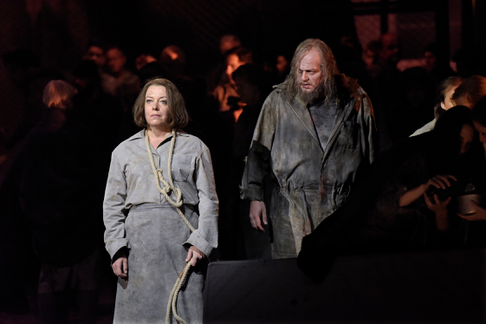 Nina Stemme as Katerina, Stanislav Trofimov as the Pope
Nina Stemme as Katerina, Stanislav Trofimov as the Pope
And it was indeed putrid. Shostakovich’s opera is famously pornographic. Mr. Kriegenberg, abetted by conductor Mariss Jansons made sex as ugly as it could possibly be in scenes of anal penetration, colossal, collective humping. Not that there were not some light, kitsch touches. The arrested atheist who proclaims that frogs have souls was a Shostakovich look alike, the policemen effeminately cooked, wove and crocheted, the priest was dead drunk, etc.
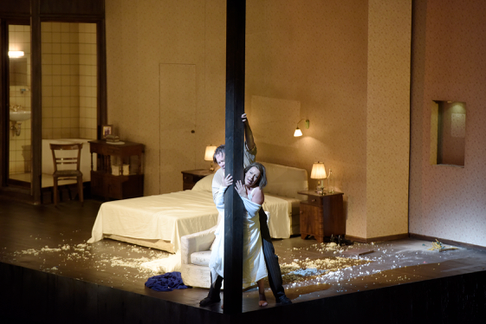 Nina Stemme as Katerina, Brandon Jovanovich as Sergey
Nina Stemme as Katerina, Brandon Jovanovich as Sergey
And further kitsch — there was sperm everywhere — flying feathers of pillows ripped apart, hundreds of little phallus sized cans of aerosol spewing thousands of tiny bubbles, bottles dispelling liquid through narrow necks. And so on.
I would have loved to have been offended and amused by such grossness. Overheard comments at the intermission noted that it was indeed an “extreme” production. And finally Mlle. Muraveva’s Lady Macbeth was greatly appreciated by audiences. But as it was I was disappointed that the Salzburg Festival did not respect Herr Kriegenberg’s production enough to find an appropriate replacement for Mme. Stemme.
Michael Milenski
Cast and production information:
Evgenia Muraveva: Katerina Lvovna Izmaylova; Dmitry Ulyanov: Boris Timofeyevich Izmaylov; Maxim Paster: Zinowy Borisovich Izmaylov; Brandon Jovanovich: Sergey;
Tatiana Kravtsova: Aksinya / Woman Convict; Andrei Popov: Shabby Peasant; Oleg Budaratskiy: Porter / Sentry; Igor Onishchenko; Millhand Vasily Efimov: Coachman / Teacher; Stanislav Trofimov: Pope; Alexey Shishlyaev: Chief of Police; Valentin Anikin: Policeman / Officer; Ksenia Dudnikova: Sonyetka; Andrii Goniukov: Old Convict; Gleb Peryazev: Manager; Martin Müller: First Worker; Oleg Zalytskiy: Second Worker / Drunken Guest; Ilya Kutyukin: Third Worker. Chorus of the Vienna Statsoper; Vienna Philharmonic. Mariss Jansons: Conductor; Andreas Kriegenburg: Director; Harald B. Thor: Sets; Tanja Hofmann: Costumes; Stefan Bolliger: Lighting; Christian Arseni: Dramaturgy. Grosses Festspielhaus, Salzburg Festival, Salzburg, August 21, 2017.
image=http://www.operatoday.com/Mtsensk_Salzburg1.png
product=yes
product_title=Lady Macbeth von Mzensk at the Salzburg Festival
product_by=A review by Michael Milenski
product_id=Above: Eugenia Muraveva as Katerina, Brandon Jovanovich as Sergej [All photos copyright by the Salzburger Festspiele / Thomas Aurin]
August 22, 2017
Cooperstown and the Hood
As one of opera’s most important contemporary leaders and contributors, Artistic and General Director Francesca Zambello has directed in the world’s most prestigious opera houses. That she personally brings her same considerable gifts and artistry to bear with Robin Hood in the rustic Cooperstown Theatre Barn speaks volumes of her belief in, and commitment to this important outreach and developmental program. Ms. Zambello has motivated her large, talented cast of teens, tweens, and Young Artists to a consistently engaging performance level, and has melded them into an enviably focused, energetic, seamless ensemble. She is ably abetted in this pursuit by inventive choreographer Eric Sean Fogel.
Composer Ben Moore and librettist Kelley Rourke have provided a wealth of witty material. Mr. Moore’s score is eclectic and accessible, a pastiche of secco recitative, bel canto arioso, Rossinian choruses, and even an occasional dash of classy Disney. Ms. Rourke’s tongue in cheek script, while clearly advocating environmental protection and a moral high ground, never lectures or scolds, but rather makes its point with heart and humor.
Two exceptional Young Artists anchored the show and inspired their young cast mates to the same high level of execution. Zachary Owen’s flexible, rich bass was a fine fit for the comically nefarious Sheriff of Nottingham. His charismatic stage presence made him a physically appealing, merrily melodious, musically satisfying villain you love to hate. As Robin Hood’s avian adviser Scarlett, Kayleigh Decker was given some of the loveliest passages in the piece, and she responded by lavishing them with an alluring, warmly scintillating soprano. Ms. Decker is the “conscience” of the plot and her consistently poised presence and polished singing were eminently enjoyable.
Young Henry Wager was the captivating title character, with all the appeal of a young Michael J. Fox. Mr. Wager has a secure, pleasantly reedy voice and his assured singing, especially of some tricky harmonies, was a real asset in the afternoon’s success. His Maid Marion, Catie LeCours was a tomboyish delight, but when she modulated her secure belt voice and went into the upper ranges, Ms. LeCours showed off a floating, flutey soprano. These two leading players are too young to have a “love duet,” so let’s call it a “like duet,” a very pleasant, tuneful exchange which the pair made into one of show’s highlights, right down to the tender, unembarrassed hug at the selection’s finish.
Morgan Hill-Edgar’s accurate singing as King Richard revealed a serious, focused performer of real promise. Jackie the Janitor and Ronnie the Riveter were impersonated with infectious gusto by Andrew Pulver and Shane Bray, respectively. Maria Noto played the Scout with determined intent; Rachel Powles “played well with others” as Sam the Scribe; and Molly Bello was a willing accomplice as Jo the Jailor.
David Moody conducted with relaxed enjoyment, as Aurelia Andrews accompanied at the keyboard with flair and color. The Youth Chorus was well prepared by Tracy Allen. Although not on the Festival main stage, all the technical elements were of the same high caliber, with Ryan McGettigan’s eye-catching scenery leading the way. The cut out trees were cleverly covered with newspaper collages, and the leaves were artistically hung squares of green material. A forest “floor” of gradated platforms facilitated a good selection of levels for varied stage pictures, as did a ruin of a tower stage right.
Peter W. Mitchell has devised a most effective lighting design, one that is especially ambitious and satisfying. His rich use of colors and well-timed cross fades and specials added considerably to the achievement. Last but not least, Sophie S. Schneider’s spot on, imaginative costumes were a riotous blend of hip-rustic chic, and rowdy, villainous audacity. The Sheriff’s electric blue suit with the shockingly contrasted accoutrements was a knockout.
That the audience responded well to this “world premiere” creative outreach concept is evidenced by the fact that performances of Robin Hood are regularly selling out. What a meaningful way to engage young people in opera. What a hopeful program to provide students and parents alike a gateway experience to becoming lifelong operagoers. If the art form is to sustain, much less thrive, Glimmerglass Festival is providing a potent Survival Guide, along with a jolly good show.
James Sohre
Cast and production information:
Sheriff: Zachary Owen; Robin Hood: Henry Wager; Scarlet: Kayleigh Decker; Marion: Catie LeCours; Scout: Maria Noto; Jackie the Janitor: Andrew Pulver; Ronnie the Riveter: Shane Bray; Sam the Scribe: Rachel Powles; Jo the Jailor: Molly Bello; King Richard: Morgan Hill-Edgar; Conductor: David Moody; Director: Francesca Zambello; Choreographer: Eric Sean Fogel; Set Design: Ryan McGettigan; Costume Design: Sophie S. Schneider; Lighting Design: Peter W. Mitchell; Youth Chorus Master: Tracy Allen; Pianist: Aurelia Andrews
image=http://www.operatoday.com/FrancescaZambello-CMcAdams-066.png
image_description=Francesca Zambello, Glimmerglass Festival Artistic & General Director
Photo: Claire McAdams/Glimmerglass Festival.
product=yes
product_title=Cooperstown and the Hood
product_by=A review by James Sohre
product_id=Above: Francesca Zambello, Glimmerglass Festival Artistic & General Director
Photo: Claire McAdams/Glimmerglass Festival.
Glimmerglass Oklahoma: Yeow!
Stay out of its way.
That’s not quite fair since Ms. Smith brought a number of fresh pieces of business into play. This was hardly a dusty “homage.” But mostly, she honored the timeless appeal and superb craftsmanship of the masters, and facilitated a fast-paced, hugely entertaining dose of vintage Rogers and Hammerstein that could hardly have been better sung.
Jarrett Ott is arguably the best Curly ever, even allowing for the fact that his hair is not as obviously curly as referenced in the script. Lanky and handsome, Mr. Ott preens and prances all over the stage, a thoroughly winning bantam rooster who, it turns out, is an amiable puppy dog at his core. Jarrett’s buzzy, virile baritone smoothly encompasses his every song, and his is an evenly produced instrument of power and beauty.
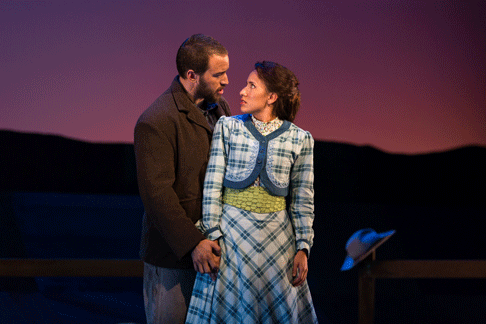 Michael Hewitt as Jud Fry and Vanessa Becerra as Laurey
Michael Hewitt as Jud Fry and Vanessa Becerra as Laurey
As Laurey, lovely Vanessa Becerra was a worthy sparring partner for Ott. The feigned toughness and independence of her characterization was sassy without being distancing. When Ms. Becarra finally gave way to an impetuously confessed love for her longtime faux-antagonist Curly, it was both humorous and awwww-inspiring. Vanessa’s silken soprano fleshed out Laurey’s famous solos with a vibrant presence, and her vocal work embodied a lilting radiance.
Judith Skinner offered an especially irascible, larger than life take on Aunt Eller. Ms. Skinner was vibrant and consistent, however if she modulated her angry persona a bit, she might discover even more punch and variety. Michael Roach was a stellar Will Parker, his well-focused tenor and sparkling delivery nailing both his big musical moments. Moreover, his athletic, committed dancing was as virtuosic as it was exuberant. Mr. Roach is a dynamic Triple Threat. And his goldfish-inspired kissy face schtick with Ado Annie was good silly fun.
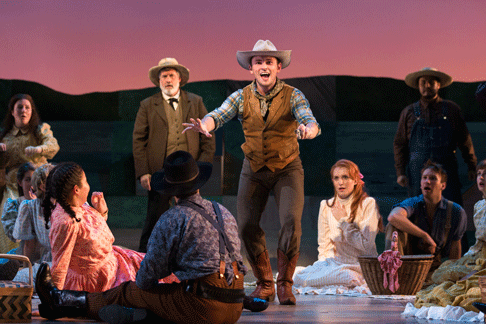 Michael Roach as Will Parker (center) with members of the company
Michael Roach as Will Parker (center) with members of the company
Speaking of Annie (and I was), Emma Roos was all gangly, sexed up indecision and she managed to make the role her own. Ms. Roos has a far more polished, legit voice than most interpreters and she too, dances with accomplished. As the sleazy weasel salesman Ali Hakim, Dylan Morrongiello affected a maddeningly ingratiating “Persian” accent that was so meticulously articulated that his teeth must hurt. His solid presence and sound comic timing were wedded to a singing voice so pleasant that it was a shame he didn’t have more music in his only solo.
I was very engaged by Michael Hewett’s well-considered take on Jud Fry, which explored the personal contradictions that inform the show’s most interesting and varied personality. Mr. Hewett’s Jud is a handsome man, and a reliable worker, seeming nothing like the odious threat some productions offer. Instead, he becomes more and more interesting as the layers of his tragic character peel away. His participation in Pore Jud reveals real humanity, and by the time Michael takes on Lonely Room, the pathos and urgent desperation in his beautifully produced, bronzed baritone draw us into his emotional paralysis. This was a memorable role assumption.
I have long been an admirer of William Burden, having first encountered his artistry in a Santa Fe production of La belle Helene, as notable for his assured singing as for his revealing his buff young frame by stripping to his tighty whities. Over the years, I have written before that it seems like Mr. Burden is such a fine musician that he can sing any role in any style and be utterly successful. Here, he vocalizes the small part of Andrew Carnes with ease, and I was particularly impressed with Bill’s wholly believable acting and cranky paternal presence, a star turn regardless of the size of the part.
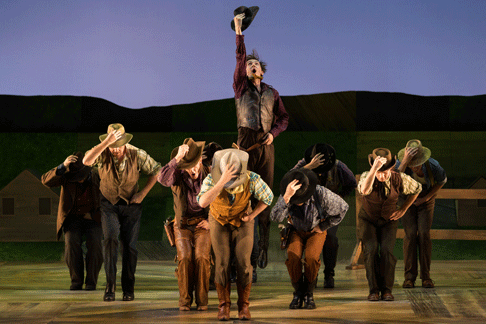 Tucker Reed Breder as Mike (center) and members of the company
Tucker Reed Breder as Mike (center) and members of the company
Kayleigh Decker was an assured and suitably annoying Gertie, and Conor McDonald gave Ike Skidmore a lively dimension. Ezekiel Edmonds and Olivia Barbieri made a lovely pair as Dream Curly and Laurey; whether dancing solo or in tandem, they displayed a sound technique and soulful passion. Parker Esse’s inventive choreography often threatened to out-Stroman the great Susan. The Dream Ballet was every bit the Big Moment it needed to be, and Mr. Esse succeeded at creating definitive visual characters all the while responding to the shifting musical styles with aplomb. Arguably, Kansas City was Parker’s piece de resistance with its vitality and inexorable build-up to a breathless climax that stopped the show cold.
Conductor James Lowe kept things bubbling along in the pit, and what a joy it is to hear masterful orchestrations that allow performers to work unamplified. That said, with the realities of the placement of the Busch pit, Maestro Lowe’s band on occasion might have considered a bit more restraint during the vocals.
Eugene Lee’s set design is simple, elegant, atmospheric and highly functional. A sort of low-rising ground row “pueblo” of neutral building blocks lines the back wall, with wooden planked, rustic house and shed units that can be rolled around and placed to suggest various locales. A row of fences, a windmill, a crate here, a hay bale there were all that was needed to created the rural settings.
Lighting designer Robert Wierzel has a field day (no pun intended) suggesting the gradations of prairie illumination and his warm hued plot provided a sun soaked glow. The star curtain that starts the show rises to reveal some excellent cyc effects, and the nightmarish descent in the dream allows for some appropriately surreal splashes of color. Ilona Somogyi’s effective costume design perfectly captures the hominess of the Oklahoma Territory, but she lets herself go with sensual and provocative attire in the dream’s bordello.
Back to director Molly Smith: No matter the time-tested perfection of the material nor the consummate talent of the participants, it takes a vision and steady hand to forge such a successful revival of a thrice familiar musical. Molly has injected freshness, imposed order, and energized an hugely gifted group of operatic practitioners into a superlative rendition of Rodgers and Hammerstein’s masterpiece.
James Sohre
Cast and production information:
Curly: Jarrett Ott; Aunt Eller: Judith Skinner; Laurey: Vanessa Becerra; Ike Skidmore: Conor McDonald; Fred: Edward Graves; Slim: Andres Marino Garcia; Will Parker: Michael Roach; Mike: Tucker Reed Breder; Jud Fry: Michael Hewett; Ado Annie Carnes: Emma Roos; Ali Hakim: Dylan Morrongiello; Gertie: Kayleigh Decker; Dorcas: Abigail Dock; Andrew Carnes: William Burden; Vivian: Alyssa Martin; Ellen: Mary Evelyn Hangley; Kate: Katrina Galka; Virginia: Mary Beth Nelson; Dream Laurey/Sylvie: Olivia Barbieri; Dream Curly/Jess: Ezekiel Edmonds; Cord Elam: Harry Greenleaf; Sam: Jarrett Porter; George: Jonathan DeVries; Joe: Joseph Leppek; Aggie: Shanel Bailey; Minnie: Anju Cloud; Wes: Aidan Kahl; Edward: Makoto Winkler; Conductor: James Lowe; Director Molly Smith; Choreographer: Parker Esse; Set Design: Eugene Lee; Costume Design: Ilona Somogyi; Lighting Design: Robert Wierzel; Hair and Make-up Design: J. Jared Janas, Dave Bova; Chorus Master: David Moody
image=http://www.operatoday.com/KarliCadel-GGF17-Oklahoma-GenDress-5586.png
image_description=Jarrett Ott as Curly and Vancessa Becerra as Laurey in The Glimmerglass Festival's 2017 production of Rodgers and Hammerstein's "Oklahoma!" Photo: Karli Cadel/The Glimmerglass Festival
product=yes
product_title=Glimmerglass Oklahoma: Yeow!
product_by=A review by James Sohre
product_id=Above: Jarrett Ott as Curly and Vancessa Becerra as LaureyPhotos © Karli Cadel/The Glimmerglass Festival
La pietra del paragone in Pesaro
The comedy's huge success in Milan won a military draft exemption for the 20 year-old Rossini, and thus assured the world of its most impressive catalog of operas.
La pietra del paragone is a bit like Cenerentola — which of the rich count's pursuers should he marry? There are two who care about his money and position, and one who cares about him. It’s a thin story, more of a simple farce than than the richly human comedies yet to come.
Count Asdrubale devises a test (the “stone of comparison”) — he pretends to be ruined, and thereby will find his true friends. And so the antics continue, musical and physical, for another couple of hours.
From the beginning Pier Luigi Pizzi never lets up, discovering new ways to animate the cubby holes of his set, including a swimming pool on the patio of his two story Malibu spread (it is very California). The scene-stealing count is into physical culture, and plays it to the hilt, illustrating the role's narcissism with absolutely splendid fioratura.
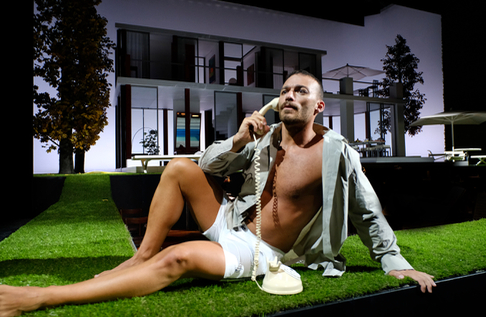 Gianluca Margheri as Conte Asdrubale
Gianluca Margheri as Conte Asdrubale
Each of the gold diggers has a champion, one a pretentious poet, the other a pretentious journalist. And the count’s true love has a champion as well — a real poet and a true friend who loves the heroine, but is left standing there.
Duets are sung as tennis matches (lobbing the ball back and forth across the pit), lovers’ duets are sung by telephone across the stage, machinations are devised on the diving board, false starts end up in the pool (you can be sure this very real pool was heated). A hunting party ends up in a duel, the heroine concocts a trick of her own to seal the deal with the count.
And the antics never stopped. It was slapstick humor and physical humor that somehow never became tiresome (well, there were those who nodded off in our row) and that sometimes motivated involuntary guffaws. This Pizzi production has indeed become a classic.
Not to be outdone Rossini proved himself unstoppable in musical antics, from patter arias, to patter duets and trios, not to forget a quintet with tons of patter. Vocal ornamentation flew around the stage and into the house via the much-used walkway fronting the pit. And the young composer from Pesaro gave his true lovers spectacular arias to cap the show — and that brought huge applause from the excited house (those who were still awake).
Milanese wunderkind maestro Daniele Rustioni, now the principle conductor of the Opéra de Lyon, recognized the high-tailed nature of the young Rossini. With the Orchestra Sinfonica Nazionale of the RAI the maestro balanced the fever pitch of the musical and stage antics with workable tempos and measured energy, even finding elusive hints of the great Rossini from time to time.
The three amazing buffos were Florentine bass baritone Gianluca Margheri as the super cool count, Benevento (near Naples) baritone David Luciano as the slimy journalist and Melzo-born (near Milan) bass baritone Paola Bordogna, a Pesaro mainstay, as the truly terrible poet. All three are splendid singers as well as real performers who epitomize a new generation, or re-birth of buffo.
Needless to say the tenor left out in the cold, Cavalier Giocondo, was not an Italian, but a Russian, Maxim Mironov who earned the evening’s biggest ovation for his spectacular aria “Quell’alme pupille.”
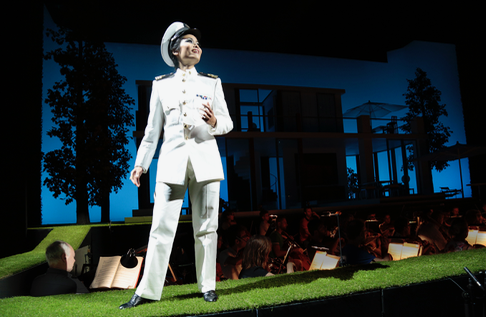 Aya Wakozono as Clarice (disguised as her "brother")
Aya Wakozono as Clarice (disguised as her "brother")
The count’s true love, Clarice was well portrayed by Japanese mezzo Aya Wakizono, an alumna of the festival’s Accademia Rossiniana. The ingenue diva, a charming performer, boasts splendid high notes. Spanish soprano Marina Monzó sang Donna Fulvia’s “Pubblico fu l’oltraggio” with appropriate gusto, and Bolzano soprano well executed the paces of Baronessa Aspasia.
Michael Milenski
Cast and production information:
Marchesa Clarice: Aya Wakizono; Baronessa Aspasia: Aurora Faggioli; Donna Fulvia: Marina Monzó; Conte Asdrubale: Gianluca Margheri; Cavalier Giocondo: Maxim Mironov; Macrobiotic: David's Luciano; Pacuvio: Paulo Bordogna; Fabrizio: William Corrò. Coro del Teatro Ventidio Bassi; Orchestra Sinfonica Nazionale Della RAI. Conductor: Daniele Rustioni; Stage director, sets abs costumes: Pier Luigi Pizzi; lights: Vincenzo Raponi. Adriatico Arena, Pesaro, August 17, 2017.
image=http://www.operatoday.com/Pietra_Pesaro1.png
product=yes
product_title=La pieta del paragon at Pesaro's Rossini Opera Festival
product_by=A review by Michael Milenski
product_id=Above: Paolo Bordogna as Pacuvio, Aurora Faggioli as Aspasia [All photos courtesy of the Rossini Opera Festival, Pesaro]
An Invitation to Travel: Christiane Karg and Malcolm Martineau at the Proms
This was Karg’s Proms debut, and many of the songs performed - by Reynaldo Hahn, Charles Koechlin, Maurice Ravel and Francis Poulenc - were receiving their first performance at the Proms, although Karg’s programme is itself quite well-travelled: she’s performed similar programmes at the Wigmore Hall (with Wolfram Rieger in 2014) and in the US in 2016 with her Proms accompanist on this occasion, Malcolm Martineau.
Nothing wrong with that, of course, and familiarity with the repertoire no doubt contributed to the assurance and ease that she displayed, and to the precision and appropriateness of Karg’s interpretative nuances. As she tracked Hahn and Ravel in Greece, Koechlin in Persia and Poulenc in London, Karg offered authentic local flavour without mannerism or cliché, expertly and impressively maintaining a balance between imitation and integrity.
Henri Duparc’s Baudelaire setting, ‘L’invitation au voyage’ (1870), was a beguiling opener. Tempted by Martineau’s palpable lapping waves, Karg’s anticipation of the leisured land of her dreams, clothed by the sun in hyacinth and gold, was both tender and sensuous. She conveyed the submerged passion which adds a frisson to even the song’s quietest phrases, adding a flash of brightness to the image of tear-bright eyes and swelling almost imperceptibly when beckoned by ‘Luxe, calme et volupté’ (luxury, peace and sensuality). Martineau’s left-hand counter-melodies sang enticingly but it was a pity that the delicious diminuendo of the close was spoiled by some disruptive banging from outside the Hall, though this was fortunately short-lived.
Karg never slipped too deeply into languorous waters, using the flinty edge of her soprano to bring immediacy and life to her interpretation of the Seis Canciones Castellanas by Basque composer Jesús Guridi. Guridi studied in Paris, Brussels and Cologne and by the time of his death in Madrid in 1961, at the age of 74, he had composed a wide variety of music much of it derived from Basque themes; these six songs, dating from 1941, are based on Castilian folk melodies. Karg’s Spanish was idiomatic, her ornamentation judicious, and she and Martineau were wonderfully responsive to the wide range of seductive sights, sounds and scents that Gurudi depicts.
‘Allá arriba, en aquella montaña’ (Up there on the mountain) opened dreamily, but ‘¡Sereno!’ (Watchman!) burst into life, the piano’s slithery syncopations evoking the threat posed by the man, fast asleep under his cloak, clutching a silver dagger. The wide distance between low accompaniment and high voice suggested the woman’s over-wrought reaction to the intruder, which Martineau mocked with an abrupt, emphatic final chord which raised a chuckle. The pianist proved a master of Spanish gesture: in ‘Llámale con el pañuelo’ (Call him with your handkerchief), his sparse staccatos punctuated the melismatic coquettishness of Karg’s flirtatious cries to the toreador. In contrast, a cool simplicity characterised ‘No quiero tus avellanas’ (I don’t want your hazelnuts), in which the protagonist rejects her lover’s empty peace offerings. Best of the sequence was the final song, ‘Mañanita de San Juan’ (Early on St John’s Day), in which Karg’s soprano floated dreamily above Martineau’s evocation of the echoing depths of the sea.
Ravel’s Cinq mélodies populaires grecques had plentiful charm. ‘Chanson de la mariée’ (Song of the bride-to-be) was infectiously eager and optimistic, while in ‘Là-bas, vers l’église’ (Down there by the church) the initial tone of mystery was imbued with reverence at the sight of the ‘infinite numbers’ of the ‘bravest people in the world’ buried beside the Church of St Constantine. The rhetoric of ‘Quel galant m’est comparable?’ (What gallant can compare with me?) swaggered conceitedly, Martineau offering a cocky, mischievous play-out which looked ahead to the ‘nonsense’ of the perky ‘Tout gai!’ (So merry), but it was the lovely vocal enrichment of the opening and close of ‘Chanson des cueilleuses de lentisques’ which was most alluring.
A similar inner richness and elegance of phrasing characterised the three songs selected from Reynaldo Hahn’s Études latines in which Karg’s beautifully even legato swept us through Hahn’s settings of poems by Charles-Marie-René Leconte de Lisle, emphasising their delicacy and grace. Inspired by Horace, the poet offers an aesthetic vision of Ancient Greece. Both Karg and Martineau offered detailed nuance: after the clean purity of ‘Lydé’, the lightness of ‘Vile potabis’ blossomed with the pain and pleasure of reminiscence in the concluding vision of the golden vines of the Formian hillside. A pastoral ease infused ‘Tyndaris’, as Martineau’s melody sang seamlessly over harp-like strumming and Karg captured the freshness and sunniness of youthful hopes.
Koechlin set thirteen poems from Tristan Klingsor’s Shéhérazadei, in two sets, and Karg prefaced two of the second Op.84 group (1922-23) with ‘Chanson d’Engaddi’ from the first Op.56 volume (1914-16). In the latter, the vocal ascents sparkled magically. However, the soprano lured us with a range of intoxicating vocal fragrances, and exhibited an impressive ability to glide effortlessly across the song’s wide tessitura, both here and in ‘Le voyage’.
After the headiness of these mélodies, the air was cleared by the playfulness of Poulenc. The composer suggested that his gravestone should announce, ‘Here lies Francis Poulenc, the musician of Apollinaire and Éluard’, and Karg and Martineau ended their recital with four settings of Apollinaire. They whisked us briskly back to the melodic charms of the Parisian musical hall after a sojourn in the dreary countryside (in ‘Voyage à Paris’ from Banalités), then charted the composer’s arrival in his adored ‘Montparnasse’ (the first of the Deux poèmes de Guillaume Apollinaire), before dashing off to ‘Hyde Park’ with its soap-box orators and self-absorbed courting couples, and arriving finally in a smoky hotel room, where Martineau’s harmonies suggested a decadent sleaziness as Karg sang with lazy languor, ‘Je ne veux pas travailler je veux fumer’.
Karg seemed absolutely ‘at home’ in the Cadogan Hall and she related these French composer’s adventures ‘abroad’ with polished artistry. As Martineau whispered at the end of one sequence of songs, bravo!
Claire Seymour
Proms Chamber Music 6: Christiane Karg (soprano), Malcolm Martineau (piano)
Henri Duparc - L’invitation au voyage; Jesús Guridi -Seis canciones castellanas; Maurice Ravel -Cinq melodies populaires grecques; Reynaldo Hahn - Études latines (‘Lydé’, ‘Vile potabis’, ‘Tyndaris’); Charles Koechlin - Shéhérazade (‘Chanson d'Engaddi’, ‘La chanson d’Ishak de Moussoul’, ‘Le voyage’), Francis Poulenc - Banalités (Voyage à Paris), Deux mélodies de Guillaume Apollinaire (‘Montparnasse’, ‘Hyde Park’), Banalités (Hôtel).
Cadogan Hall, London; Monday 21st August 2017.
image=http://www.operatoday.com/Christiane-Karg%20%C2%A9-Gisela-Schenker.jpg image_description=Prom Chamber Music 6: Christiane Karg and Malcolm Martineau at Cadogan Hall product=yes product_title= Prom Chamber Music 6: Christiane Karg and Malcolm Martineau at Cadogan Hall product_by=A review by Claire Seymour product_id=Above: Christiane KargPhoto credit: Gisela Schenker
August 21, 2017
Schoenberg's Gurrelieder at the Proms - Sir Simon Rattle
No wonder tickets almost sold out as soon as they went on sale. Everyone in town seemed to be there. Thomas Quasthoff sat in the coffee shop, holding court with friends and fans. Simon Rattle got cheered when he came in sight on the stage, still in street clothes, by Prommers who were already seated half an hour early.
Gurrelieder is a spectacular so extravagant that, for maximum effect, it needs to be experienced in a performing space where the vast forces can let rip in all their glory. Rattle has conducted it many times in many places, but there's nothing like the Royal Albert Hall for sensational presence, so he was able to unleash the full forces of Gurrelieder without inhibition. For Gurrelieder is meant to be overwhelming, Waldemar defies God, who wreaks cosmic vengeance. He and his men are doomed to spend eternity riding through the night in a hunt. The peasants (here a single symbolic figure) are terrified by the supernatural, but Klaus-Narr, being a Fool, can recognise the ghosts for what they are - cosmic forces, and the demonic power of Nature.
Gurrelieder starts with a rhapsodic prelude, string lines swelling and heaving, harps adding warmth, woodwinds delicate, naturalistic touches. The reference is probably Siegfried's Journey down the Rhine, for Waldemar is about to embark on a journey of destiny. Like Siegfried, Waldemar spends his innocence hunting in the woods, where Tove is concealed. Hence the Wood Dove, like the Wood Dove in Siegfried, an all-seeing avatar. Dense forests, in Germanic culture, symbolise powerful, though sinister, primeval forces. The subconscious, source of creativity and danger.
Gurrelieder is song symphony of Wagnerian proportions. Simon O'Neill, being a very experienced Wagnerian, brought dramatic authority to the role. Waldemar is no Tristan but a king who thinks he can throw curses at God. If anything, he's a Flying Dutchman, doomed to sail the seas forever. O'Neill's Waldemar is an embattled soul, tormented and defiant, instinctively understanding the part. Waldemar is not a Romantic Hero, but a man cursed, struggling against Fate. Thus the roles of Waldemar and Tove, though well written musically, aren't particularly well developed in terms of psychological complexity. For Schoenberg, they are figures in a landscape, who will become incorporated into Nature and nature legend around them. Nonetheless, Eva-Maria Westbroek created Tove with great vocal depth, and Karen Cargill sang the Wood Dove, a bird of darker portent than Siegfried's wood dove.
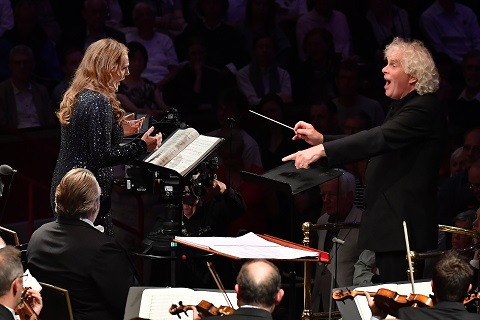 Sir Simon Rattle conducts Eva-Maria Westbroek with the London Symphony Orchestra. Photo credit: Chris Christodoulou.
Sir Simon Rattle conducts Eva-Maria Westbroek with the London Symphony Orchestra. Photo credit: Chris Christodoulou.
Schoenberg was only twenty-six when he wrote what was to become the First Part of Gurrelieder, but in the interim, he developed a highly original identity. In Part Two, the harps still sing, but the sweeping strings are broken by fearsome chords which replicate the word "Herrgott! Herrgott!" which O'Neill sang with intense flourish. Note the text, carefully. Waldemar accepts his fate, but frames it as a creative destiny. He chides God. "Das heisst Tyran, nicht Herrscher sein!". Like any earthly king, God needs Fools to keep him in order. Thus the significance of Klaus-Narr and of the Narrator, both figures who can see beyond events and guess significance. In the years between the time Schoenberg began writing Gurrelieder and completing it, he developed a distinct creative identity. The true artist, as innovator, will often be alone, even vilified, but artistic integrity is paramount. thus "Lass mich, Herr, die Kappe deines Hofnarrn tragen!".
The peasant (Christopher Purves) is horrified by the sight of Waldemar's Ghost Riders in the sky (complete with echoes of hunting horn). His response is to hide, pray and bolt his door "noch Stahl und Stein, so kann mir nichts Böses zum Haus Herein!" "Holla!" to all that. The men's voices in the choirs sing a wild, rhythmic chorus, alternating explosive force with singing of hushed subtlety. O'Neill sang Waldemar's "Mit Toves Stimme" so it rang out as an anthem: the love that keeps Waldemar singing is like the inspiration an artists needs to create.
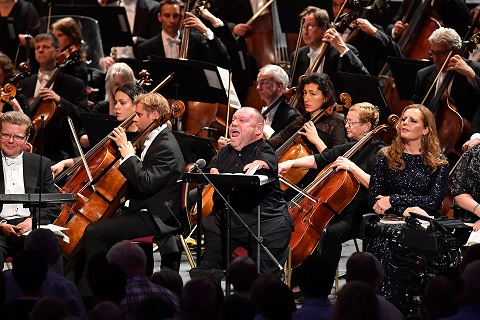 Thomas Quasthoff performs in Schoenberg’s Gurrelieder with the London Symphony Orchestra conducted by Sir Simon Rattle. Photo credit: Chris Christodoulou.
Thomas Quasthoff performs in Schoenberg’s Gurrelieder with the London Symphony Orchestra conducted by Sir Simon Rattle. Photo credit: Chris Christodoulou.
The music that introduces Klaus-Narr is quirky but pointed, The Fool (Peter Hoare) is himself a ghost, serving his dead King in the same way that his king serves the God who doomed him. Hoare let the lines curl round his tongue, spitting them out in line with the odd angular rhythms in the music. Waldemar will not be cowed. Trumpets call, and hunting horns. Waldemar's still a huntsman and fighter who will barge his way into Heaven. The huge chords in the orchestra return, but fade away, for dawn is about to break. The Men's voices sang in dramatic hush as Waldemar's men sank back into the grave. Rattle and the LSO created a haunting orchestral Prelude, settingb the tone for the entry of the Narrator (Thomas Quasthoff). Brooding somnolemce, eddies of quirky sound, like will o' the wisps illuminating darkness. In many ways, the part is the heart and soul of the piece, for it's written as Sprechstimme, neither song nor speech, a device which Schoenberg was to make distinctively his own. This section is extraordinary, so unusual and so powerful that it leaves the listener stunned. Quasthoff did the Narrator (and the Peasant) with Rattle in Berlin in 2000. Though he's long ceased singing, he can still act, and speak the part with a singer's ear for song. It's quite a part. I will never forget hearing Hans Hotter do it way back in 1994, when he was already in his eighties. And then the chorus exploded in that glorious "Seht die Sonne!"
This Prom was recorded for repeat online broadcast, and filmed for TV broadcast on September 3rd (BBC TV 4).
Anne Ozorio
image= http://www.operatoday.com/Rattle%20Prom%2046.jpg
image_description=Prom 46: Sir Simon Rattle conducts the LSO Symphony Orchestra and Chorus in Schoenberg’s Gurrelieder
product=yes
product_title=Prom 46: Sir Simon Rattle conducts the LSO Symphony Orchestra and Chorus in Schoenberg’s Gurrelieder
product_by=A review by Anne Ozorio
product_id=Above: Sir Simon Rattle conducts the massed forces of the CBSO Chorus, the London Symphony Chorus, Orfeó Català and the London Symphony Orchestra, in Schoenberg’s Gurrelieder at the BBC Proms
Photo credit: Chris Christodoulou
Le Siège de Corinthe in Pesaro
We were all eager participants, harangued lengthily and forcibly by a high priest of the Greeks to accept martyrdom. Some of us were actually absorbed into the crowds of the condemned citizens of Corinth transfixed by the priest’s ecstatic vision of freedom.
Uncompromising in its pursuit of the purest Rossini, this Italian high-art Festival provided supertitles only in French for this new, hyper-researched critical edition of Rossini’s first “grand” opera for France, said to musically recreate its original performance on October 9, 1826.
Thus Rossini’s five second act ballet divertissements were reduced to the three that the Paris Opera allowed at the premiere — though in Pesaro there was not a dancer in sight. Mahomet II, transported by his love for Pamyra wandered amidst the plastic bottles during the first divertissement, Lord Byron’s verses (in four languages) were projected line by line for the second, and members of the theater collective, La Fura dels Baus, fought over a bottle of water for the third.
After a few moments of indecision the audience booed its disapproval, but only half-heartedly.
This famed theater collective had envisioned the production of this musical reproduction of the 1826 event with deft, intellectual whimsy, finding in the plastic water bottle metaphor sufficient depth to intrigue if not enlighten the audience for the nearly five hour duration of the performance. That the massive walls of bottles sparkled brilliantly in the lights, and collapsed magnificently and elegantly (yet quietly enough not to cover Rossini’s magnificent music) more than adequately fulfilled French grand opera’s requirement for spectacle. Not to mention several important, enigmatically-imaged banner filled parades through the audience.
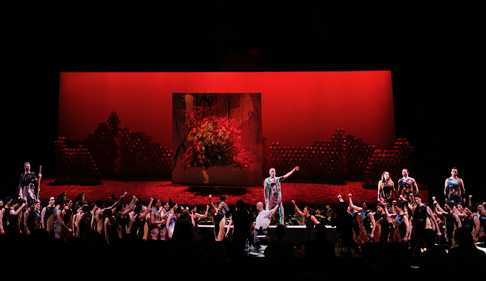 The high priest Hiéros leading the Corinthians (chorus mixed with some spectators) to martyrdom, Corinth in flames.
The high priest Hiéros leading the Corinthians (chorus mixed with some spectators) to martyrdom, Corinth in flames.
This flashy, beautifully staged and very successful production surely atones for the festival’s lackluster 2008 production of Maometto II, Rossini’s original 1820 Naples version of this Paris re-write (though the young general Calbo was memorably etched in Pesaro by Daniella Barcelona). The French had long forbade castrati (evidently trouser roles as well) thus this same young general now named Néoclès was sung just now by Russian tenor Sergey Romanovsky.
Rossini had broken new ground in Maometto II, thinking in larger and more complex dramatic blocks. But he allowed himself one huge aria scene and it was for Néoclès — the Russian tenor soared in impeccable fioratura to a high “C” (at least) praying to God to save the Greeks. This magnificent aria earned the one huge ovation of the evening. Note that Rossini’s advanced style precludes pauses for applause.
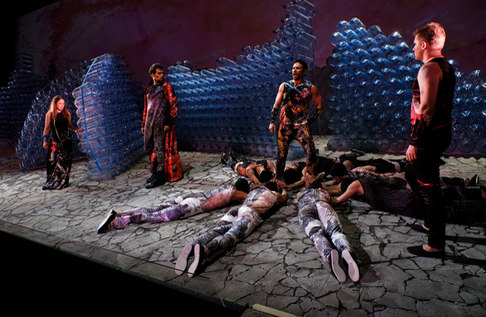 Left to right: Pamyra, Mahomet II, Néoclès, Omar
Left to right: Pamyra, Mahomet II, Néoclès, Omar
The overwhelming conflict of the evening was love versus duty. The Greek princess Pamyra loves the Turkish sultan Mahomet but her responsibility is to her father and to her homeland, and to her Greek fiancé Néoclès. Georgian bel canto diva Nino Machaidze suffered as only great Rossini divas may. This remarkable artist brought a musical intelligence that informed every phrase, suffusing the complex vocal lines with a unique expressive gravitas in richly colored voice.
It was indeed a brutal conflict of love and duty, all the more so because Mahomet, Luca Pisaroni, was very handsome in his red regalia, imposing in stance, and convincing in voice (Mr. Pisaroni is a well-known Neapolitan Maometto II as well). Rossini proved the enlightenment of this Muslim general who conquered Corinth by giving him an aria in which, stating his love of the arts, he declares he will not destroy Corinthian monuments. There was some applause.
To the festival’s good fortune Torino’s RAI Orchestra Sinfonica Nazionale found its way into the pit of Pesaro’s Adriatic Arena (changing regional financial structures have destroyed the festival's long time association with Bologna’s Teatro Comunale). As expected from a symphony orchestra there was elegance of tone, limpidity of texture, and an easy virtuosity, attributes that responded to the transparency and clarity of score imposed by conductor Roberto Abbado.
With such resources Mo. Abbado uncovered instrumental sonorities new to Rossini’s advanced style, and clarified the dramatic and musical intelligence of the expanded structures of the numbers that included combinations of arias, duets, trios and ensembles. The maestro achieved the rare and ephemeral plateaux of sustained lyricism that create absolute opera.
Each August we Rossinians make our pilgrimage to Pesaro, his birthplace, in search of such transcendental evenings.
The casting of Le Siège de Corinthe was uniformly effective. British tenor John Irwin sang Pamyra’s father King Cléomène, adding additional tenorial splendor to this evening. The high priest Hiéros was lustily intoned by Italian bass Carlo Cigni. The Greeks and the Turks, and there were a lot of them, were energetically enacted by the fine chorus of Teatro Ventidio Basso (the opera house of Ascoli Piceno, a small city in Le Marche, the same province as Pesaro).
Michael Milenski
Cast and production information:
Mahomet II: Luca Pisaroni; Cléomène: John Irvin; Pamyra: Nino Machaidze; Néoclès: Sergey Romanovsky; Hiéros: Carlo Cigni; Adraste: Xabier Anduaga; Omar: Iurii Samoilov; Ismène: Cecilia Molinari. Coro del Teatro Ventidio Basso. Orchestra Sinfonica Nazionale della RAI. Conductor: Roberto Abbado; Production: La Fura dels Baus; Stage director and set designer: Carlus Padrissa; Costumes and video: Lita Gabellut; Lights: Fabio Rossi. Adriatic Arena, Pesaro, August 16, 2017.
image=http://www.operatoday.com/Siege_Pesaro1.png
product=yes
product_title=The Siege of Corinth at Pesaro's Rossini Opera Festival
product_by=A review by Michael Milenski
product_id=Above: Luca Pisaroni as Mahomet II, Nino Machaidze as Pamyra [All photos courtesy of the Rossini Opera Festival, Pesaro]
Dunedin Consort perform Bach's St John Passion at the Proms
For the climax of the BBC Proms celebration of the 500th anniversary of the Reformation, Butt and the Dunedin Consort performed Bach's St John Passion at the Royal Albert Hall in the context of Lutheran Vespers, with organist Stephen Farr performing chorale preludes by Bach and Buxtehude on the Royal Albert Hall Organ, and the audience being encouraged to join in the congregational chorales. The passion was performed by Nicholas Mulroy (Evangelist), Matthew Brook (Jesus), with Sophie Bevan, Tim Mead, Andrew Tortise, Konstantin Wolff and Robert Davies.
But if we were expecting the same stripped down approach to the passion that John Butt uses on the recording, then we were in for a bit disappointment. Part of Butt's ethos when recording Bach is not only textual fidelity, but research into the original performance traditions. This meant that the CD re-created the Lutheran liturgy for Good Friday Vespers, and used a total of ten singers to perform all the solos and the choruses, with a similarly small instrumental ensemble. At the Royal Albert Hall, Butt had a professional choir of 36 and an orchestra with based around 33 strings.
Thankfully, the performance from Nicholas Mulroy as the Evangelist showed that you did not need large forces to fill the Royal Albert Hall. Mulroy was riveting, easily communicating music and text, and singing largely from memory, this was spine-tingling narration. Mulroy is a highly involved and vivid performer, bringing out the extremes of the passion story, and imbuing the music with a remarkable range of colour. But, as with every good Evangelist, it was the text which really counted and Mulroy's level of involvement and projection made a gripping evening.
Mulroy was matched by the dignified Jesus of Matthew Brook, who similarly used the words to devastating effect and somehow conveyed that he really did mean it. He sang with a trenchant firmness of line, and rather than being other-worldly was wonderfully human.
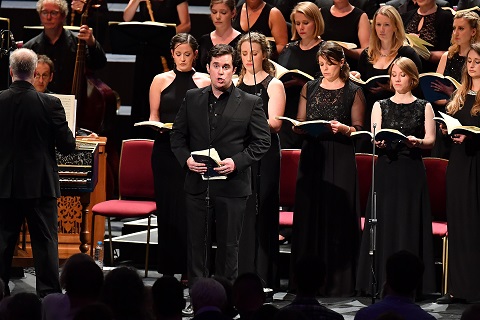 Nicholas Mulroy performs the role of the Evangelist in J.S. Bach’s St John Passion. Photo credit: Chris Christodoulou.
Nicholas Mulroy performs the role of the Evangelist in J.S. Bach’s St John Passion. Photo credit: Chris Christodoulou.
The other soloists did not always achieve the same degree of communicability, though it has to be admitted that singing Baroque music in the wide open spaces of the Royal Albert Hall is rather a fine art. Sophie Bevan was a beautifully focussed soprano soloist. ‘Ich folge dir gleichfalls’ was sung with a lovely sense of joy, and some fine passagework, whilst Bevan was partnered by the magical sound of four baroque flutes. In ‘Zerfliesse, mein Herze’ she found a real vein of expressive purity.
Tim Mead was poised and expressive in ‘Von den Stricken meiner Sünden’, though perhaps a little too controlled, and he was partnered by some very fine oboe playing indeed. In ‘Es is vollbracht’ he was movingly expressive, and in contrast to many of the fleet speeds in other movements here John Butt allowed the movement to unfold in its own time, with vivid contrasts in the middle section.
Andrew Tortise made ‘Ach, mein Sinn’ quite dramatic and rather vivid. ‘Erwäge, wie sein blutgefärbeter Rücken’ was beautifully considered and expressive, but seemed to lack the ultimate emotional punch needed. Here Tortise was partnered by the lovely sound of a pair of muted violins, whilst in ‘Mein Herz, indem die ganze Welt’, Tortise's fine performance was somewhat overshadowed by the vivid playing of the orchestral violins
Bass soloist Konstantin Wolff was nicely correct in his arias, singing with fine control and nice sense of line but he seemed not to be able to project the underlying emotions across the Albert Hall's large spaces, this was a rather more intimate performance. In ‘Mein teurer Heiland’ the balance with the chorus was not always ideal. Baritone Robert Davies sang Pilate with fine musicality but with a rather muted sense of the drama.
The chorus might, perhaps, have been larger than I was hoping for but musically they certainly did not disappoint. Butt's speeds throughout were often fleet, and his singers followed him admirably and produced a series of vivid and moving performances. The great opening and closing choruses were both kept moving, yet without skating over the surface so that the deep emotions of the music was conveyed too. In the turbae, the singing was fast, furious and wonderfully vivid.
The large orchestra was similarly impressive, not just in the myriad solo moments that Bach provides, but in the degree of expressivity found in the general run of the music.
The soloists sang in the opening and closing choruses and chorales, which is just as it should be and made the piece feel much more like a communal expression. The extracts of the vespers service provided a remarkable piece of context. The reconstruction is, to a certain extent, speculative but informative nonetheless. The way the Bach and Buxtehude organ chorale preludes flowed seamless from the chorales on which they were based, sung lustily in unaccompanied unison by the Prom audience, gave a vivid impression of the importance of context in this work. After the end of the passion, we flowed directly in Jacob Handl's funeral motet, and then on to the blessing, and a final pairing of chorale prelude and chorale.
In the programme booklet, John Butt talked about the important hierarchy of the different levels of singing in the church in Bach's day, from the congregation's chorales through the more sophisticated Renaissance-style motet singing (done with several singers to a part) to the more soloistic performance of Bach's own music, performed by very few singers. But this was something we rather missed in this performance which allied itself to modern choral traditions of performance. In terms of balance there was the usual problem of 'can you hear the oboes?'. In the livelier choral moments, we heard very much a choir and strings with both the oboes and the chamber organ rather disappearing into the texture.
It is unfair of a listener to expect a performance to re-create exactly the effect of a particular recording, but I could not help feeling that this performance of the St John Passion was a missed opportunity in a number of ways. The long running time (nearly three hours) and late start time meant that audience members were leaving before the end, and you wished that an afternoon slot could have been found for the event. That someone did not believe that a stripped down performance with just 10 singers could fill the Royal Albert Hall was a shame, Nicholas Mulroy showed how it could be done.
The performance is available on BBC iPlayer for 30 days.
Robert Hugill
J.S. Bach: St John Passion (performed within a reconstruction of the Leipzig liturgy for Good Friday Vespers)
Evangelist - Nicholas Mulroy (tenor), Jesus - Matthew Brook (bass), Sophie Bevan (soprano), Tim Mead (alto), Andrew Tortise (tenor), Konstantin Wolff (bass), Dunedin Consort, John Butt (director)
BBC Proms at the Royal Albert Hall, London; Sunday 20th August 2017.
image=http://www.operatoday.com/John%20Butt%20directs%20the%20Dunedin%20Consort%20in%20a%20liturgical%20reconstruction%20of%20J.S.%20Bach%E2%80%99s%20St%20John%20Passion.jpg image_description=Prom 49: Dunedin Consort - J.S. Bach’s St John Passion product=yes product_title= Prom 49: Dunedin Consort - J.S. Bach’s St John Passion product_by=A review by Robert Hugill product_id=Above: John Butt directs the Dunedin Consort in a liturgical reconstruction of J.S. Bach’s St John PassionPhoto credit: Chris Christodoulou
August 19, 2017
Collision: Spectra Ensemble at the Arcola Theatre
The conspiracy theorists are ever vigilant for signs of impending apocalypse. Only a few days ago, a NASA tweet about a solar eclipse due to occur later this month triggered declarations from evangelical Christians that humanity will be wiped out by the event. Given that terrorist atrocities and nuclear stand-offs currently seem to be every-day fare, one might be forgiven for occasionally feeling as if the end of the world is indeed nigh.
These are dark days and such times are ripe for exploitation by both doomsday-sayers and artists. Jack Stanley’s new play, Catastrophists asks us to reflect upon how we would behave if the social order collapsed, alienation and conflict ensued, and we had to fight to survive. But German avant-gardist Kurt Schwitters (1887-1948) was posing the same question 90 years ago, in his ‘grotesque opera in 10 pictures’, Collision (Der Zusammenstoss).
Paradoxically, montage seems to have been the underlying principle uniting Schwitters’ fragmentary art. He engaged with every artistic current of his day: German Expressionism, Cubism, Dadaism, Surrealism, Constructivism and Bauhaus. His art work included dramatic large-scale assemblages, installations, sculptures, paintings, drawings and advertising designs, but today he is best known for his collages - of tram tickets, newspaper shreds, scraps of cloth, and other ‘remnants’ of everyday life.
Schwitters and his collaborator, the German-American artist and art historian Kate Trauman Steinitz, seem to have applied the same montage approach to the opera libretto upon which they embarked in April 1927.
Based on one of Schwitters’ own short stories, Collision was to be a sort of ‘multi-media’ opera - a blend of play, cabaret and opera which mixed words, music and rhythm in new ways. The ‘plot’ juxtaposed different social types, switching rapidly between place - an observatory, an airport, a broadcasting station - and character, and charted the responses of his bizarre medley of dramatis personae to the news that the end of the world was looming.
When astronomer Virmula espies a new ‘Green Globe’, the euphoria of his planetary discovery is tempered by the realisation that it is heading straight for the Potsdamerplatz in Berlin. The media spread word of the imminent apocalypse, but rather than fear and frenzy the news incites opportunism and exploitation. Virmula sees not catastrophe but fame and fortune on the horizon, while his lover, Alma, exults in the projected honour he will earn. The High Commissioner of Order, aptly named Masterly, dons his uniform and attempts to assert his authority - over the city and the comet - by organising the preparations for the final sunset. Big Business sees the chance to make a quick buck, as journalists and radio presenters use hyperbole to stoke hysteria and sell another newspaper or song. Led by the janitor, Rommel, the homeless rehearse for Revolution, while the rich, such as the concert singer Paulsen, are indifferent to the threat to their lives of luxury and leisure.
This ‘Science-Fiction Opera Libretto in Banalities’ won second prize (300 reichsmarks) in a competition in Vienna in August 1928, but the score remained uncompleted. The project fell victim to the fiscal crisis triggered by the Wall Street Crash and ultimately the Director of the Berliners Staatsoper, who had considered staging the work, declared it ‘too ultramodern and much too comic’. Ironically, the opera-that-never-was embodies both the context which informed it and the very question that it asks: after the collapse of the Dream and amid the ruins of the glorious roaring Twenties, how will the world survive?
In collaboration with director Cecilia Stinton and the other members of Spectra Ensemble, composer Lewis Coenen-Rowe has rescued Schwitters’ music-drama from oblivion by composing a new score which he describes as ‘heavily influenced by the music of Kurt Schwitters’ 1920s Germany, combining elements of contemporary art music, popular song, jazz and cabaret’. That’s a bit misleading, as Collision is not really a ‘cabaret opera’, and there’s not really any ‘popular song’; but, Coenen-Rowe has crafted strong vocal lines and evocative instrumental moods which capture the darkness and bitterness of so much of the music of the Weimar era, with its experimental intermingling of the ‘popular’ and the ‘classical’. And, the through-sung structure does have some aria and ensemble ‘moments’, including an intense paean to ‘Organisation’, mankind’s last hope in the face of the imminent cosmic crash.
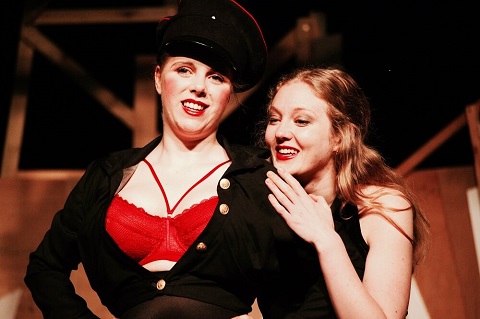 Juliet Wallace (Masterly) and Bethany Horak-Hallett (Taa).
Juliet Wallace (Masterly) and Bethany Horak-Hallett (Taa).
The score’s distortions - tremors, thunderings, twisting swoops and screeches - are an effective aural embodiment of a chaos in which panic is juxtaposed with partying. And, the music is adeptly played by the band of five musicians - pianist Erchao Gu, violinist Carlos Yeung, cellist Harvey Gibbons, saxophonist Claudia Baum and clarinettist Robert Winup - who are conducted efficiently by musical director Sean Morris.
In the small Studio 2 at the Arcola Theatre, however, the music overwhelms the singers, further exacerbating the uneven diction and the lack of directorial clarity. Schwitters’ story is both wry and sly, humorous and bitter; but, it’s also fragmented and Stinton - admittedly hampered by the limitations of space - hasn’t found a way to show how the parts of the collage ‘cohere’. Schwitters’ discontinuities convey the social upheaval of the time, but here the ‘gaps’ don’t reflect such confusion, they aggravate it. Even though the action was ‘up close’, much of the text was inaudible and apart from the fact that Barnaby Beer’s Virmula had spotted an earth-bound solar body, it was impossible to discern what was happening other than that, whatever events were unfolding, they were taking place at fever pitch.
This was a pity, as the young cast are talented and committed, and one senses that the more detailed set, staging and choreography that would be possible in a larger venue would enable the singers to develop their characterisations beyond the grotesque.
Beer’s focused baritone communicates Virmula’s zeal while as his girlfriend, Alma, Olivia Sjöberg uses her soft-edged mezzo to convey her affection and adulation. Made to prance about in black hot-pants, suspenders and cut-away velvet waist-coast, Bethany Horak-Hallett has strong presence as Taa, Mastery’s girlfriend, infusing her mezzo with both sultriness and shine. Alexander Gebhard’s attractive lyric tenor emphasised Paulsen’s smug complacency. Juliet Wallace had all the high notes for Masterly’s stratosphere-surfing but unfortunately the volume was as unremittingly high as the register, and the charm of the unrelenting petulant posing and saucy posturing quickly wore off.
Schwitters’ artistic credo was the equality of all the elements in the collage - word, music, movement, sets, costume, lighting. But, with the acting space accommodating barely a couple of chairs and a broom, the music inevitably dominated, at the expense of dramatic coherence and interest, and theatrical breadth and depth. Moreover, the through-composed score actually negates Schwitters’ aim for parity of all the ‘available materials’ which are combined ‘for artistic purposes’. Perhaps balancing instrumental and sung episodes with spoken dialogue would have created a more dramatically engaging and communicative idiom?
At the close, when the collision - by this point, both feared and craved - fails to materialise, the bated breaths give way to the bathos of survival. ‘What if it’s not the end, what if it’s pretend?’ they have sung. Well, if it’s not the end of the world after all, then life will go on as usual, the contradictions of human nature unchanged.
Claire Seymour
Collision: a cabaret opera - by Kurt Schwitters and Lewis Coenen-Rowe
Spectra Ensemble
Barnaby Beer (Virmula, and astronomer/Jailbird), Olivia Sjöberg (Alma/Paperboy/Saleslady/School Principal), Henry George Page (Rommel, a janitor/Schmitt, a radio announcer), Juliet Wallace (Masterly, High Commissioner of Order), Bethany Horak-Hallett (Taa, a dancer, Masterly’s girlfriend), Alexander Gebhard (Paulsen, a concert singer); director - Cecilia Stinton, musical director - Sean Morris, designer - Holly Muir, lighting designer - John Pham.
Studio 2, Arcola Theatre, London; Friday 18th July 2017.
image=http://www.operatoday.com/Bethany%20Horak-Hallett%2C%20Alexander%20Gebhard%2C%20Henry%20George%20Page%20and%20Juliet%20Wallace%20in%20Collision.%20Credit%20Ro.jpg image_description=Collision, Spectra Ensemble at the Arcola Theatre product=yes product_title=Collision, Spectra Ensemble at the Arcola Theatre product_by=A review by Claire Seymour product_id=Bethany Horak-Hallett, Alexander Gebhard, Henry George Page and Juliet Wallace in Collision.August 18, 2017
Joshua Bell offers Hispanic headiness at the Proms
But, the ‘Spain’ of Debussy’s Iberia or Ravel’s Rapsodie espagnole and L'Heure espagnole was essentially an ‘exoticised’ musical land. Ravel’s mother may have been of Basque origin but Debussy’s experience of the country amounted to a brief day-trip to San Sebastian, although this didn’t stop Spanish composer Manuel de Falla remarking of Debussy’s piano work La Soirée dans Grenade, ‘There is not even one measure of this music borrowed from thee Spanish folklore, and yet the entire composition in its most minute details, conveys admirably Spain’.
De Falla moved to Paris in 1907 where he was welcomed and supported by Ravel, Debussy (with whom he had previously corresponded) and Dukas, and the music that he composed during his Parisian sojourn - such as thePièces Espagnoles for piano solo and the concerto, Noches en los jardines de España - reveals the influence of the Impressionist composers with whom he associated. But the outbreak of war in 1914 forced Falla to return to Spain where he attempted to establish himself as a composer in his native land, his music blending the modernist influences that he had absorbed during his travels in northern Europe with authentic Spanish idioms.
In his one-act ballet with chorus, El amor brujo (usually translated as ‘Love, the Magician’, though brujo literally means ‘male witch’, suggesting more demonic forces) Falla strived to combine art music with genuine gypsy song and dance, but though the composer conceived the work as a gitanería and it was written for Pastora Rojas Monje - the daughter of the famous flamenco dancer Rosario la Mejorana - when the work was premiered in 1915, contemporary critics complained that the music was too ‘French’.
The ballet scenario by Gregorio Martínez Sierra was based upon an Andalusian folktale in which a beautiful gypsy girl, Candelas, is haunted by her dead lover - a wicked, jealous reprobate whom she nevertheless both still loves with a morbid intensity and fears may return, a fierce spectre demanding her devotion. When she is courted by the gallant Carmelo, Candelas is unable to cast off her obsession with the past. Carmelo coaxes pretty Lucia to help him set a trap for the ghost and Carmelo and Candelas are able to exchange the ‘perfect kiss’: their love defeats the evils of the past.
Falla subsequently revised the ballet in the form of an orchestral suite in which four of the twelve movements present songs in which Candelas sings of her heartbreak, of her dead lover’s hypnotic unearthly power and, finally, of her release from the spell by Carmelo’s kiss. And, it was this orchestral suite which opened this Franco-Hispanic Prom presented by Charles Dutoit and the Royal Philharmonic Orchestra.
For all its pictorial realism and folk authenticity, El amor brujo is also notable for its beautifully detailed orchestration and this was a performance that was more refined than sensuous, as Dutoit focused on instrumental detail and variety of colour at the expense of the score’s earthy vitality and rhythmic fickleness. The Hispanic inflections were somewhat watered down - the woodwind’s flamenco flourishes in the opening bars might have had more kick and éclat for example - and the tempi sometimes felt sluggish, the ostinato rhythms too inflexible and mechanical. The ‘spells’ of ‘Midnight’ (‘A medianoche’) were more stately than sorcerous, heralding a ‘refined’ ‘Ritual Fire Dance’ which sizzled rather than scorched: such elegance and polish would not have frightened the horses, let alone driven out the evil spirits.
But, if Dutoit wasn’t the most transfixing story-teller he proved a vivid scene painter in the score’s descriptive passages. The opening cave scene was appropriately dark and murky, tinged with the menacing crescendos of the tremolando strings and the oboe’s eerie cries against the twinkling of the harp. In ‘El aparecido’ (The ghost), the harp glissandi wailed like a banshee, initiating a lurching ‘Dance of terror’ in which the snatching woodwind and sharply plucking strings taunted each other like whirling spirits. There was some lovely tender string playing in ‘El círculo mágico’ (The magic circle) and the tunefulness of ‘Pantomima’ (Pantomime) was beguiling, though the folk inflections of the latter were muted.
Mezzo-soprano Stéphanie d’Oustrac made a strong impression last year at Glyndebourne, in Laurent Pelly’s Béatrice and Bénédict but her voice is quite light-weight and in this much larger auditorium she struggled to project the love-crazed gypsy’s songs of obsession and bewitchment. She was also rather too score-bound; a little more eye-contact would have helped but, at least from where I was sitting in the Hall, the text seemed to disappear into the score which she held in front of her. In the ‘Canción del amor dolido’ (Song of the broken heart), D’Oustrac attempted some gitanesque mannerisms - ‘deforming’ some of the syllables, fiercely rolling the ‘r’s, reaching for occasional guttural hardness - but her chest voice isn’t sufficiently dark and sultry to make such gestures feel entirely true. The opening ‘ay!’ needed more raw emotion, the melismas more vibrancy and the phrases more colour modulation, to convey the mourning girl’s rapid fluctuations from sadness to anger, through anxiety to bitterness, and finally from delirium to madness.
D’Oustrac fared better in the ‘Canción del fuego fatuo’ (Song of the Will-o’-the-Wisp) as the sparser orchestral texture allowed her to imbue the melody with a gentler warmth which contrasted effectively with the fiercely enunciated snarls. But, her characterisation wasn’t helped by Dutoit, as the ‘Danza del juego de amor’ (Dance of the Game of Love) lacked an erotic pulse and the ‘bells of dawn’ rang without lustre.
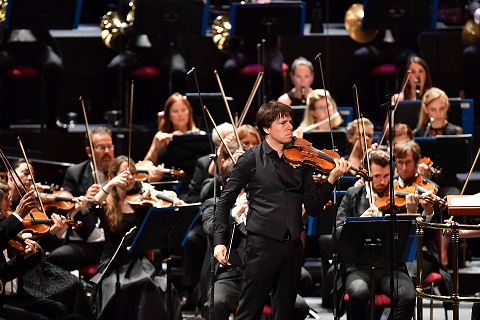 Joshua Bell plays Symphonie espagnole. Photo credit: Chris Christodoulou.
Joshua Bell plays Symphonie espagnole. Photo credit: Chris Christodoulou.
If passion and intensity were missing from El amor brujo then Joshua Bell more than compensated in a performance of Lalo’s Symphonie espagnole - a concerto too seldom performed - which was punchy, grandiose, impish and silkily lyrical, by turn. As he chased Lalo’s melodies up the violin’s G-string, Bell’s sound was never gritty, always soft-edged though well-defined, and beautifully nuanced with judicious portamento, vibrato and rubato. Similarly, the stratospheric passages shone crystalline and pure. The second movement’s seguidilla sparkled and together with the habanera bestowed the scents and sultriness of Iberia that were absent from the preceding Falla suite. The fiendish Rondo flew by with stunning nimbleness but it was the exquisite melodism of the close of the Intermezzo which really took one’s breath away. Massenet’s ‘Méditation’ from Thaïs kept happy those punters eager for further opportunity to relish Bell’s beautiful tone, but I couldn’t help thinking that the high spirits of a dance miniature by Falla or Sarasate - to whom Lalo’s concerto was dedicated - might have stirred the passions more.
Organist Cameron Carpenter joined Dutoit and the RPO for a fittingly thunderous rendition of Saint-Saën’s Third Symphony (the ‘Organ’ Symphony). As in the Lalo, Dutoit drew disciplined, expressive playing from his instrumentalists - the richness of the brass was particularly eloquent - and the structure was underpinned by persuasive rhythmic and temporal fluency. Saint-Saëns’ symphony was commissioned by the Philharmonic Society and first performed in 1886. It was thus a fitting conclusion to a concert during which Dutoit - the RPO’s Artistic Director and Principal Conductor, who made his debut at the Proms 36 years ago in 1981 - was presented with a Royal Philharmonic Society Gold Medal by John Gilhooly, the Chairman of the RPS, thus becoming the 103rd recipient of the illustrious award.
Claire Seymour
BBC Prom 43: Manuel de Falla - El amor brujo; Édouard Lalo - Symphonie espagnole Op.21; Camille Saint‐Saëns - Symphony No.3 in C minor (Organ)
Stéphanie d’Oustrac (mezzo-soprano), Joshua Bell (violin), Cameron Carpenter (organ), Charles Dutoit (conductor), Royal Philharmonic Orchestra.
Royal Albert Hall, London; Thursday 17th August 2017.
image=http://www.operatoday.com/Mezzo-soprano%20St%C3%A9phanie%20d%27Oustrac%20performs%20Manuel%20de%20Falla%E2%80%99s%20El%20amor%20brujo.jpg image_description=Prom 43: Charles Dutoit and the Royal Philharmonic Orchestra product=yes product_title= Prom 43: Charles Dutoit and the Royal Philharmonic Orchestra product_id= Mezzo-soprano Stéphanie d'Oustrac performs Manuel de Falla’s El amor brujoPhoto credit: Chris Christodoulou
August 17, 2017
John Joubert's Jane Eyre
Composers tend to steer clear of sprawling nineteenth-century tomes, with their vast casts of characters and complex engagement with contemporary social concerns. As far as I know, no-one has yet been brave, or foolhardy, enough to turn Vanity Fair or À la recherche du temps perdu into an opera, although Prokofiev didn’t let the 1500 page-count of War and Peace put him off.
Moreover, Jake Heggie’s 2011 opera Moby Dick used computer graphics and elaborate staging to condense Melville’s mighty novel into a streamlined form, while just this spring Charlottesville Opera presented a chamber opera adaptation of Middlemarch by composer Allen Shearer and librettist Claudia Stevens, which George Eliot scholar Delia Da Sousa Correa described as ‘a concentrated expression of more of George Eliot’s novel than one might think possible in a brief, two-act opera’.
Composer John Joubert, who celebrated his 90th birthday this spring, is best known for Christmas carols such as ‘Torches’ (1951) and ‘There is no rose of such virtue’ (1954) which have become staples of the festival season. But, Joubert’s oeuvre is in fact extensive and wide-ranging, comprising over 180 opus numbers: from operas - including adaptations of George Eliot’s Silas Marner and Joseph Conrad’s Under Western Eyes - to orchestral works, concertos, chamber music, instrumental works, and both small- and large-scale choral pieces.
The South Africa-born, UK-domiciled composer has - according to David Wordsworth’s account of Joubert’s achievements in the March/April issue ofChoir & Organ magazine, which is reproduced on the composer’s website - long found literature a stimulus to his musical creativity: ‘The long and varied list of writers he has drawn on (some notoriously hard to set to music) includes Emily Brontë, Donne, Lawrence, Shakespeare, Yeats, Hopkins, Hardy, Rossetti, Mandelstam, Ruth Dallas, Chesterton, and Crashaw, as well as Psalm settings and numerous medieval texts.’
For ten years of his 70-year composing career, Joubert worked on an opera adapted from Charlotte Brontë’s Gothic romance, Jane Eyre. An adapted version was mounted by Opera Mint in 2005 but it was not until October 2016 that the opera - which Joubert had revised further into a two-act structure - received its official ‘world premiere’ at the Ruddock Performing Arts Centre in Birmingham. That concert performance, by the English Symphony Orchestra under the baton of Kenneth Woods, was recorded and released by SOMM in January this year.
Librettist Kenneth Birkin has focused on Jane’s adult life, which deprives us of the first stages, at Gateshead and Lowood, of Jane’s progress through Brontë’s Bildungsroman but which sensibly makes Jane’s romantic trials with Rochester and St John Rivers the central concern. Each act is divided into three scenes. Act 1 begins on the eve of Jane’s departure from Lowood and journey to Thornfield, where she takes up her position of governess. Scenes two and three juxtapose Bertha Mason’s attempt to murder Rochester by setting his bed alight, with a garden scene in which Rochester and Jane declare their love for each other. Act 2 begins with the disruption of their wedding ceremony by Bertha’s brother, before the action shifts forward one year and presents Jane in the parlour of the Rivers’ cottage at Whitecross where she has been given refuge. When St John attempts to persuade Jane to join him, as his wife, as he departs for missionary work in India, she desists and, haunted by Rochester’s anguished cries, ‘Jane! Jane! Jane!’, returns to Thornfield where the final scene sees her reunited with the now blind Rochester, who is at last free to marry her.
We learn less about the physical and emotional abuse that Jane experiences at the hands of the Reed family, Mr Brocklehurst and Blanche Ingram, and we lose some of Brontë’s cast of characters, including Jane’s childhood friend, Helen, and the secretive, sinister Grace Poole. But, though the red room episode would surely have made for a terrific set-piece, there are several other scenes and passages which provide vivid theatre, including the instrumental interlude which evokes Bertha’s midnight progress towards Rochester’s bed and the interruption of Jane’s wedding by Bertha’s brother before a morally outraged congregation.
Indeed, the latter scene breaks the opera’s prevailing pattern of duets and short monologues. The scene begins with orchestral bustle, the brass and timpani suggesting preparations for a public nuptial ceremony as well as sounding a more ambiguous and ominous note. The declamatory lines in this scene are Britten-esque: they brought to mind the trial scene at the start of Peter Grimes, when Swallow summons Grimes into the dock, and the censorious condemnations of the massed voices - ‘Bigamy!’, ‘It’s little short of sacrilege!’, ‘In God’s house too’ - are no so far from the Borough’s hypocritical denunciation of Grimes.
However, so much of the power of the novel depends on the strong first-person narrative, through which the reader seems almost to connect with Jane’s inner consciousness. As Jane, April Fredrick sings the opera’s first words, joins with Rochester in a transcendent union at the close, and is pretty much a constant participant in the action. And, both Fredrick’s gleaming, focused soprano - which soars through Joubert’s lyrical lines - and her vocal stamina are admirable.
The opening scene reminds me of the Governess’s first utterances in Britten’s The Turn of the Screw, for the sweetness of Fredrick’s sound suggests Jane’s eagerness and lack of worldly experience, though as her soprano swells powerfully, the strength of Jane’s inner spirit is also conveyed. As the opera unfolds, Fredrick’s communicates the full range of Jane’s rapidly changing and diverse emotions. She is not intimidated by Brocklehurst when he insists that she remain at Lowood, resisting his overbearing menace as intimated by the orchestral surges and stabs, and by the dark tone colours of low brass, strings and timpani. During her early exchanges with Rochester, one senses Fredrick’s voice growing in focus and presence as Jane matures and becomes conscious of her burgeoning love.
The garden meeting in which they voice their true feelings is tender, the static harmonies and woodwind murmurings evoking both the tranquillity and expectancy of the summer evening. Later in the scene, the more sensuous colours and harmonies, the lilting rhythms and the horn’s mellifluousness imbue their overlapping lines - ‘lay your head upon my breast’ - with quasi-erotic emotion, which strengthens further as the two voices come together in wonder, ‘Is it a waking dream?’ Jane’s duets with St John Rivers are no less captivating: Fredrick is eloquent in resisting his domineering insistence that she must join him in India, and when Jane hears Rochester’s distant voice, calling her name, she finds the strength to retain her integrity as the horn sings a gentle reminiscence of their former love.
The characterisation of the entire cast is strong and communicative. David Stout’s firm baritone suggests Rochester’s masculine confidence and authority, though shades of darkness intimate inner troubles which sometimes find expression in outbursts of Claggart-like self-pity and frustration: ‘Fate has brought me home’, he despairs when reflecting on the ‘demon from pit of hell itself’ which separates him from his beloved Jane. But, the snarling rasp, ‘hell’s gate’, is quelled by images of Jane’s ‘sweetness - innocence’, and Stout’s voice softens tenderly. Later, blinded by the Thornfield fire and alone in the overgrown garden, Stout shapes his low utterances to suggest Rochester’s sad resignation and exhaustion, though as he recounts the tale of Thornfield’s destruction his baritone burns with yearning - ‘Jane, where are you now? I miss you so.’ - and then angry misery: ‘Am I forgotten then?’ The joyful warmth of the impassioned reunion scene leads to a transcendent closing duet.
Gwion Thomas’s Brocklehurst is imperious and domineering, his enunciation crisp and commanding; one can easily picture a nineteenth-century autocrat accustomed to seeing women and children cower in response to his bullying decrees. St John Rivers is sung by Mark Milhofer, whose penetrating tenor suggests a man driven by missionary zeal and contrasts strikingly with the delicate adorations of his sisters Diana and Mary. The diction is uniformly excellent and the singers are never overwhelmed by the orchestral fabric, the textures of which are lucid, allowing the many evocative instrumental details to be remarked.
A forty-page booklet contains both synopsis and complete libretto, as well as essays by Joubert, Kenneth Woods and Christopher Morley; the latter’s interview with Joubert is included at the end of CD2 and provides an intriguing supplement. The recording is bright and clear, and there are no ‘intrusions’ from the live audience.
Joubert has remarked, ‘The criterion I use for the selection of operatic subjects is that they should comment in some way on basic human issues, thus bringing them into line with the Enlightenment idea of theatre as a ‘School of Morals’’. Indeed, some might argue that Brontë’s novel verges on the didactic, with the characters experiencing a series of ethical crises in a world where morality and romantic love seem to be mutually exclusive. However, at the close, though it’s perhaps not clear whether Jane’s decision to return to Rochester is driven by her morals or her emotions, the final scene of Joubert’s opera sees the beloveds’ souls ‘joined as one … before God’s throne’. But, if there is peace and reconciliation at the close, then Joubert’s opera certainly makes tangible what Virginia Woolf described as Jane’s very modern sense of ‘self’, as she ‘resist[s] all the way’. In so doing, Joubert’s Jane Eyre communicates much about the particularities of individual human experience.
Claire Seymour
John Joubert (b.1927): Jane Eyre - opera in two Acts Op.134
Jane Eyre - April Fredrick, Edward Rochester - David Stout, Mrs Fairfax/Hannah - Clare McCaldin, Revd. St John Rivers/Richard Mason - Mark Milhofer, Mr Brocklehurst - Gwion Thomas, Sarah/Diana Rivers - Lesley-Jane Rogers, Leah/,Mary Rivers - Lorraine Payne, Rector’s Clerk - Joseph Bolger, Revd. Wood/John - Alan Fairs Samuel Oram - A servant, Verger - Andrew Randall, Briggs - Andrew Mayor; Conductor - Kenneth Woods/English Symphony Orchestra.
rec. live, 25 October 2016, Ruddock Arts Centre Birmingham (premiere)
SOMMCD263-2 [58:19 + 48:26/17.30 (Christopher Morley in interview with John Joubert)]
image=http://www.operatoday.com/Somm%20Jane%20Eyre.jpg image_description=John Joubert’s Jane Eyre product=yes product_title=John Joubert’s Jane Eyre product_by=A review by Claire Seymour product_id=August 15, 2017
Hibiki: a European premiere by Mark-Anthony Turnage at the Proms
At this Proms performance, the first outside Japan, soloists soprano Sally Matthews and mezzo-soprano Mihoko Fujimura were joined by the BBC Symphony Orchestra, Finchley Children’s Music Group and the New London Children’s Choir under the baton of Kazushi Ozo, who conducted the premiere in November 2016.
Ozo drew fine and committed performances from all involved but I found this work ‘of commemoration, consolation and contemplation’ rather unengaging and unaffecting. This is partly, I think, because Turnage’s seven movements place assorted contexts and circumstances side by side - a natural disaster, a WWII bombing raid, the deaths of innocent children, the tragic culmination of a love-suicide Bunraku play - without convincingly making such moments cohere, and without really penetrating through the cultural surface. What does a tsunami have to do with an incendiary raid on Tokyo? How can a chain of six musical ‘threnodies’ offer any real consolation for such terrible loss of life of an almost unimageable scale? And, what are we to make of the ‘Suntory’ Dance which they frame - is it a celebration, a dramatization, a ritual?
Moreover, what sort of musical language and form should any such ‘consolation’ assume? Turnage’s orchestral score is characteristically lively, with syncopations vying with jazzy grooves, and the large orchestra - especially the percussion and brass - is exploited to kaleidoscopic effect. There are also meditative vocal passages which offer contrast. But there’s a disjuncture between Turnage’s orchestral vernacular and the texts presented in four of the movements, which range from English translations of various Japanese texts - Sō Sakon’s ‘Hashitte iru’ (Running) and an excerpt from Chikamatsu Monzaemon’s The Love Suicides at Sonezaki - to, conversely, the Japanese variant of the nursery rhyme, ‘Twinkle, twinkle, little star’ - ‘Kira, kira hikaru’.
The first two movements are orchestral though, and depict two prefectures - Iwate and Miyagi - which were hit by the 2011 tsunami. ‘Iwate’ starts with a repetitive, fragmented pattern which, picked up by the brass and percussion, rapidly escalates into a dynamic whirl of high woodwind and trumpet contrasted with swelling strings. Dove-tailed blocks of sound provide unceasing variety of texture, until the ominous pounding of the timpani threatens disintegration, and spaces open up with low growling trombone juxtaposed with piercing piccolo. A jazzy syncopation suggests a grotesque dance of death which spins into oblivion. ‘Miyagi’ opens quietly; eerie moans creak and float over the sound string lines, presaging the disturbing, violent orchestral stabs which fracture the silence.
The two soloists are introduced in the third movement and present Sō Sakon’s poem, from his collection Mother Burning, which describes his experience as a child of trying to escape - ‘running through the sea of fire a road of fire’ - after the death of his mother in an incendiary raid in 1945. The dancing trumpet heralds a siren, marking the two soloists’ anxious repetitions of ‘running’ and ‘mother’ which build to a panicking climax. Both Matthews and Fujimura projected their short intertwining phrases with power and focus against the brass outbursts - suggestive of roaring, surging flames - until subsumed by a clamouring orchestral wave.
The solo clarinet coaxed the children’s chorus into a sweet-toned rendition of the nursery rhyme, the brightness of the vocal colour and the sparseness of the orchestration serving to cleanse away the violence of the preceding movement, as the celestial body offers assurance to star-gazers and guidance to night-time travellers. The unfolding stanzas were accompanied by increasingly animated textures, culminating with Matthews’ glowing statement of wonder at the nature and significance of the bright and tiny spark.
The ‘Suntory Dance’ followed, starting darkly but gradually stirring up primal energies and skipping exchanges between percussion, low strings and horns. Both Turnage and the BBCSO players showed their rhythmic precision and virtuosity in this inventive dance which, even when full brass shone forth and the violins soared high, never quite assumed a celebratory air. (An incidental side-note: Hibiki, or ‘Japanese Harmony’ is a brand name of a blended Suntory Whisky, which the renowned distiller remarks ‘was launched in 1989 to commemorate Suntory’s 90th anniversary, and has ever since been embraced as the paragon of The Art of Japanese Whisky, the very product of Japanese nature and her people’ - which if nothing else demonstrates the potential for cultural misappropriate and disjuncture.)
Fujimura sang ‘On the Water’s Surface’ with beautifully shaped phrasing which captured the melancholic rapture of the text, enhanced by sensitive clarinet solos and underpinned by nudging bass gestures. There is a coolness about the instrumental timbre, fittingly so, for this time the stars lead to the ‘joy beyond extinction’. The elegiac mood was sustained in the final section, ‘Fukushima’, in which the children’s chorus spun melismatic repetitions of the name of nuclear power plant which, following the tsunami, experienced three nuclear meltdowns and hydrogen-air explosions resulting in the release of radioactive material second in quantity only to the Chernobyl disaster of 1986. It certainly made for a meditative end, but the children could really have been repeating any single word to produce the same effect.
In the first half of the Prom, we heard two French impressionist masterpieces, but neither quite made their full mark. Debussy’s Prélude à l'après-midi d’un faune was beautifully played - delicate, precious, silkily assuaging - but conveyed little of the emotional highs and lows of the narrative of the faun’s insouciant pan-pipe gambolling, rapturous arousal by the passing nymphs and naiads, and exhausted abandonment to vision-fuelled sleep. It’s almost impossible for Ravel’s G major Piano Concerto not to win over an audience and, making his Proms debut, Israeli pianist Inon Barnatan gave a refined performance of effortless virtuosity, skipping lightly through the fancy passagework. But, while Barnatan’s technique may be flawless, Ozo needed to draw a dash more jazzy vitality from the BBCSO to balance the lyrical wistfulness. The ‘Classical’ simplicity of the slow movement worked its unaffected charm, and the cor anglais provided the requisite nostalgic tints, but the whip-crack buzz was missing from the finale. It took an encore - Mendelssohn’s Rondo capriccioso in E major Op.14 - for us to have opportunity to enjoy Barnatan’s full expressive range and depth, from elegance to bombast, from majesty to impishness.
One other small observation to conclude: the expressive narrative and unity of both Ravel’s concerto and Turnage’s Hibiki were disrupted by the Prommers’ habit of applauding every movement. Concentration and coherence are both aided by silence.
Claire Seymour
Prom 39: Debussy - Prélude à l'après-midi d’un faune; Ravel - Piano Concerto in G major; Mark-Anthony Turnage - Hibiki (European première)
Inon Barnatan (piano), Sally Matthews (soprano), Mihoko Fujimura (mezzo-soprano), Kazushi Ono (conductor), BBC Symphony Orchestra, Finchley Children’s Music Group, New London Children’s Choir .
Royal Albert Hall, London; Monday 14th August 2017.
image=http://www.operatoday.com/Composer%20Mark%20Anthony-Turnage%2C%20soprano%20Sally%20Matthews%2C%20mezzo-soprano%20Mihoko%20Fujimura%20and%20conductor%20Kazushi%20Ono.jpg
image_description=BBC Prom 39
product=yes
product_title=BBC Prom 39
product_by=A review by Claire Seymour
product_id=Above: Sally Matthews, Kazushi Ozo, Mark-Anthony Turnage and Mihoko Fujimura
Photo credit: Chris Christodoulou,
August 11, 2017
Through Life and Love: Louise Alder sings Strauss
As well as acclaimed performances as Sophie von Faninel in WNO’s Der Rosenkavalier (which OT reviewers admired in Cardiff and Birmingham ), Alder has sung Marzelline in the BBC Philharmonic’s Fidelio at the BBC Proms , performed with the Academy of Ancient Music in Monteverdi’s Vespers at the Barbican Hall in June, and contributed to the Wigmore Hall’s ambitious project, ‘Schubert: The Complete Songs’, participating in an unusual programme of songs for female vocal ensemble, ‘Schubert and Women's Voices’.
Despite this hectic schedule, Alder even managed to find the time and energy to step into the breach at the Wigmore Hall, when travel problems scuppered baritone Andrei Bondarenko’s planned recital at the end of July, and presented at short notice a concert of songs by Hahn, Debussy, Liszt, Poulenc, R. Strauss and Britten. Interestingly, a performance by Alder of the latter’s On this Island, which closed this Wigmore Hall programme, had previously impressed me on the occasion when I first heard the soprano sing at the Hall in April 2014 , leading me to declare that the ‘demanding programme indisputably marked soprano Louise Alder as a name to watch’.
Both that 2014 recital and this July’s concert with pianist Gary Matthewman included songs by Richard Strauss, some of which have found their way onto Alder’s debut album, Through Life and Love , which was released last month on the Orchid Classics label. The disc presents a life’s progress through song - from Youth (Das Mädchen), through Longing (Sehnsucht), Passions (Leidenschaft), Partnership (Liebe), Motherhood (Mutterschaft) and Loss (Verlust), to Release (Befreiung). And, although the songs in each section do not represent a chronology of Strauss’s career, the recording is in effect a survey in miniature of a life’s work, for Strauss composed over 200 songs, from the early ‘Weihnachtslied’ written when he was just six-years-old to the Four Last Songs which were his final musical utterance, published posthumously by his friend Ernst Roth in 1950.
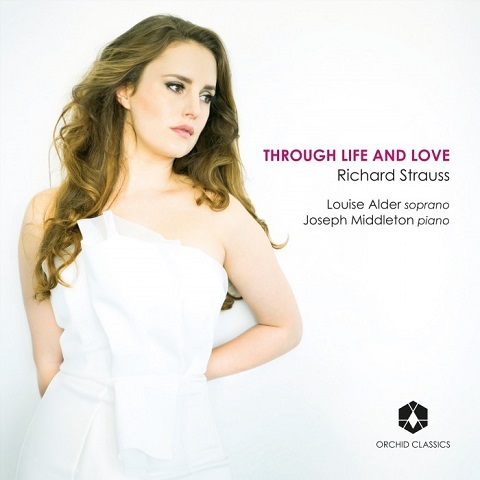
Alder’s soprano is crystalline and has a thrilling shine. Although the colour palette is not extensive, the purity of sound is startlingly beautiful, and Alder can make the sparkle still brighter, or diminish the fullness to a fine thread, at will and with discernment. The German is well-enunciated - her experience with Frankfurt Opera no doubt informs her excellent diction - though I am less enamoured of her tendency to heavily roll the ‘r’s, sometimes quite markedly (particularly in the middle of words, which can disrupt the sweet sound). It’s a pity, too, that the song texts are not included in the accompanying booklet. Pianist Joseph Middleton plays with an elegance that can be stylishly urbane or delicately reflective, and communicates the narratives of these songs with sensitivity and insight.
There are two settings of poems by the expressionist poet Richard Dehmel. Alder negotiates the uncertainty and economy of ‘Leises Lied’ (Soft Song, Op.39 No.1) with lyricism and focus: the vocal leaps are flawlessly executed and tuned, and ‘Glänzt mir im Herzen immer’ really does ‘shine’ with radiant youthful ardour. Middleton’s upper register quavers hover inscrutably, finally ‘resolving’ onto an ambiguous second-inversion triad. In contrast, the harmonic saturation and flowing melodism of ‘Befreit’ (from the same Opus and included in the section entitled ‘Loss’), allow us to enjoy the glowing bloom of Alder’s soaring lines as she floats through the extended arcs. Strauss wrote in his diary on 1 June 1898, ‘Composed song Befreit by Dehmel very beautifully’; one feels he would add, ‘and sung with exquisite and subtle beauty it was on this occasion’. Alder and Middleton - who ensures every detail is heard but remains in a hinter-world between reality and dreams - adeptly suggest that the emotional intensity is contained within the singer’s heart: what we hear is the imagined embodiment of a soul’s bliss.
The piano’s restless rippling in ‘Ständchen’ (Serenade, Op.17 No.2), first scintillatingly glittering then dipping down into darker realms, perfectly captures the youthful excitement in Alder’s voice as she urges her beloved to creep softly from his bed and join her amid the twilight magic of the flowers, lindens and nightingales. The harmonic shift of the final stanza, ‘Sitz nieder, hier dämmert's geheimnisvoll’ (Sit, here it darkens mysteriously), is accompanied by an enchanting retreat to a hushed pianissimo, the deepening harmonic colours suggesting incipient true passion beneath the adolescent eagerness. ‘Breit’ über mein Haupt dein schwarzes Haar’ (Spread over my head your black hair, Op.19 No.2) - like ‘Ständchen’ a setting of the poetry of Adolf Friedrich von Schack - showcases the plush gleam of Alder’s soaring soprano, as rich and flowing as the imagined streaming black locks, which shines still brighter against the deeper hues of Middleton’s noble chords.
The latter is the last song in the ‘Longing’ section which opens, appropriately, with ‘Sehnsucht’ (Op.32 No.2). Like so many of Strauss’s lieder, this song was dedicated to his wife Pauline, and it was also the composer’s first setting of the poet Detlev von Liliencron. Here, Alder shapes the enigmatic fragments thoughtfully: her low voice is even and poised, but surges with colour when the vision of the road ahead appears before the protagonist. The fierceness of the avowal ‘If you directed your eye to me coldly, I would resist, my maiden’ (Und richtest du dein Auge kalt auf mich,/Ich trotze Mädchen dir) is startling, but short-lived, as the image of the beloved’s eye - ‘Wie eine Sonne mir in schwerer Nacht’ (like a sun to me in the heavenly night) - weakens the resistance. Alder floats to a heavenly top A which captures the soul-piercing beauty of the burning sun and lover’s gaze. No phrase so purely demonstrates the sheer beauty of Alder’s soprano, and her technical control, than the final, sustained declaration, ‘Ich liebe dich’.
The two songs of ‘Motherhood’ form an effective, complementary pair. Alder’s soprano slips lightly through the confident exuberance of the adoring mother’s praise for her infant’s golden curly locks, blue eyes and rosy cheeks in ‘Muttertänderlei’ (Mother-chatter, Op.43. No.2), Middleton’s accompaniment wryly thickening as she admires his perfect plumpness - ‘fatter than a fat snail’! There is pride, awe and joy in Alder’s voice as she captures the mother’s unconditional love, as embodied in the smoothly descending melisma, ‘so lieben’. In contrast, ‘Meinem Kinde’ (Op.37 No.3) is redolent with soft tenderness as the mother leans over her sleeping child’s crib, Middleton’s swaying cross-rhythms conveying the lilt of the rocking cradle.
Songs from Strauss’s first published collection, ‘8 Gedichte aus Letzte Blätter’ Op.10 (1885, settings of poems by the Austrian Hermann von Gilm), both open and close the 23-song sequence. The first song of ‘Youth’, ‘Nichts’ (Nothing), opens with a playfully leaping accompaniment - Strauss instructs the pianist to play ‘mit Laune’ (with humour) - and Alder’s crisp vocal line has a conversational ease. However, the broadening of the phrasing and the irresistible ascent of the vocal melody for the question, ‘Ist die Sonne nicht die Quelle/Alles Lebens, alles Lichts? (Is not the sun the source of all life and all light?), takes us into the reflective sentiment of the operas. In ‘Die Nacht’ (The Night) Middleton’s skill in evoking - through the piano’s unceasing, gradually enriching, pulsing quavers - the unstoppable shadow of the night which creeps from the woods and extinguishes all the lights of the land, is matched by the tinge of awe which Alder introduces into her vibrato-light melody. The sense of disturbing transformation is wonderfully captured through the change of harmonic colour with the line ‘Alles nimmt sie, was nur hold’ (It takes everything that is dear), while the growing strength of Alder’s vocal climbing vocal line suggest both fear and wonder at the night’s power to take the silver from the stream and the gold from the cathedral roof, dismissive both of nature and of man’s gods.
‘Zeuignung’ (Devotion), placed at the start of ‘Release’, confirms Alder’s and Middleton’s ability to encompass both delicate tenderness and blissful exultation within a song lasting less than two minutes. Middleton, in particular, seems able to discern the precise moment in the song where Strauss infuses the flowing triplet accompaniment with an over-spilling joy, leading into the final stanza with a finely shaped rubato then enriching the dense chords with power and passion. The disc ends with the final song in the Op.10 set, ‘Allerseelen’ (All Soul’s Day), in which Middleton’s sensuous syncopations suggest the underlying emotional tumult of the recently bereaved protagonist as she strives to relive past moments of joy. The woman’s delusion is intimated by the harmonic chasm which opens when she imagines that she is reunited with her beloved, ‘Gib mir nur einen deiner süßen Blicke,/ Wie einst im Mai (Just give me your sweet gaze, as once you did in May), and Alder and Middleton push on compellingly, making the climactic Ab declaration that she holds him close to her again even more tragic and ephemeral. Then, the mask skips: arpeggiations and rhythmic doubt infiltrate the accompaniment once more, and the self-assurance of Alder’s final ‘Wie einst im Mai’ is undermined by the falling seventh and by the overly earnest weight of the soprano’s low register.
Alder will resume her engagement with Frankfurt Oper later this autumn where she will sing Despina, Sophie (Werther) and, in March 2018, Clorinda (La Cenerentola). Before that, there are plenty of opportunities to enjoy Alder’s performances in the UK, when she helps Classical Opera launch their new venture, 'The Mozartists’ at the Wigmore Hall in September, travels to Scotland to join the BBC Scottish Symphony Orchestra in performances of Beethoven’s Ninth Symphony in Glasgow and Perth in September, returns to the Barbican in early October for a semi-staged performance of Purcell’s King Arthur with the Academy of Ancient Music under Richard Egarr, and then heads north again to Newcastle for a performance of Mendelssohn’s Second Symphony with Paul McCreesh and the Royal Northern Sinfonia at the Sage Gateshead . Clearly, Alder has no intention of resting on her laurels: her star remains surely and brightly in the firmament.
Claire Seymour
image=http://www.operatoday.com/Louise%20Alder%281%29.jpg image_description=Through Life and Love, Louise Alder sings lieder by Richard Strauss product=yes product_title=Through Life and Love, Louise Alder sings lieder by Richard Strauss product_by=A review by Claire Seymour product_id=Above: Louise AlderPhotograph, courtesy of Askonas Holt
August 9, 2017
Janáček: The Diary of One Who Disappeared, Grimeborn
Janáček wrote this 35-minute work during the final years of the First World War, and its over-riding theme of cross-cultural love, displaced family values and separation are emotionally symbolic of the political and historical times in which they are set. This was a period of constrained social mobility, of racial and class prejudice, of political turmoil and largely because of this the cycle is quite easy to take out of its historical roots and place in a contemporary time and setting. Janáček himself seems to have been undecided by the presentation of this work - should it be completely staged, or simply presented without any kind of dramatization. Deborah Warner’s production for the National Theatre many years ago didn’t make a convincing job of this, and it should be said that Jack Furness’s production recalls that one in many details (down to the use of video projection and simulated sex). But by placing it in a modern-day asylum centre Shadwell Opera and Jack Furness could be saying this is anywhere and everywhere - identity and indecision of themselves cross borders and nationalities, time and space, love is welded to bureaucracy to be rubber stamped at will. Where Warner had over-indulged the setting, Furness has kept it to a bare minimum without interference from the direction placing the composer’s libretto in a social petri dish.
For such a short work, it has surprising psychological depth though the desolation of Janáček’s piano writing lays much of the foundation for this too: more than half of the stated tempi for the score indicates music which is played slowly, although that is not to say there isn’t angularity or impressionistic weight to phrasing elsewhere. Much of the writing recalls Janáček’s 1905 Sonata in its rumbling bass lines, the massive chords that sound stricken with terror, the phrases that erupt elliptically and the sounds of tolling bells. The bleakness of the score is undeniable, but set against the meltingly tender phrasing of Sam Furness the contrast between hope and despair was beguiling. The mezzo-soprano Angharad Lyddon also sang her role powerfully, and hers is a very rich voice. She was entirely convincing.
I’ve never been absolutely convinced by Seamus Heaney’s translation of Janáček’s cycle - it never lacks poetry, and it’s rhythmically well written, but the language can be earthy sometimes, though perhaps this is because Heaney is trying a little too hard to replicate the Czech folktale narrative that inspired Janáček in the first place. Nevertheless, Sam Furness sang his part with magnificently clear diction (this was one of those rare examples when literally every word was crystal clear) and one was often spellbound by his ability to float phrases. His is a powerful, yet fully emotive voice, and the stamina was formidable. Janáček doesn’t make Heldentenor demands in this cycle but he expects his tenor to sing at sotto voce (which Furness did) and he had no difficulty whatsoever reaching his two high notes at the close of the cycle. Matthew Fletcher played the score with effortless brilliance.
This may well have a been very short evening but it was hugely impressive.
Marc Bridle
Sam Furness (tenor), Angharad Lyddon (mezzo-soprano), Matthew Fletcher (piano), Jack Furness (direction)
Shadwell Opera, Arcola Theatre, Studio 2, London E8; 4th August 2017.
image=http://www.operatoday.com/Sam%20Furness.jpg image_description=The Diary of One Who Disappeared, Grimeborn product=yes product_title=The Diary of One Who Disappeared, Grimeborn product_by=A review by Marc Bridle product_id=Above: Sam FurnessPhoto credit: Maximillian von London
August 7, 2017
Khovanshchina: Mussorgsky at the Proms
The problem here was that the translation used for the surtitles was most assuredly not that in the programme, which could conceivably lead to confusion. It certainly added an extra layer of interest, albeit an unnecessary one.
Perhaps describing this performance as “semi-staged” is pushing it. There was some lighting for the culminatory pyre skittering across the RAH’s ceiling and elsewhere, although it was as a gesture rather underwhelming (the ending is a cross between the closing moments of Götterdämmerung and Dialogues des Carmelites). George Gagnidze’s sparkly bowtie was frankly more memorable than the light show. And yet, the performance itself was magnificent, guided impeccably by Semyon Bychkov, who previously led a Khovanshcina at the Vienna State Opera in 2014. The score operates across a huge canvas. Requiring large chorus (the BBC Singers here cannily augmented by the Slovak Philharmonic Choir, darkening the sound), equally large orchestra and a great long list of soloists, Mussorgsky’s epic pulls no punches. The same is true emotionally, as the political events unfold (the Streltsy revolts led by Ivan Khovansky, religious conservatism in the shape of the Old Believers, events around the beginning of Tsar Peter I’s reign). The characters Dosifey - Ain Anger sporting a prominent cross - and Marfa - who had previous romantic links to Koslovsky sung by the astonishing Elena Maximova - represent the old ways. In his excellent programme note, Simon Morrison of Princeton University suggests that Marfa is the character that reflects Mussorgsky’s own beliefs the best - and as such, she has some of the finest music.
Mussorgsky’s characteristically earthy writing (some might say unsophisticated) is there openly and unapologetically in this score, linking aurally to the original version of Boris Godunov and the piano original of Pictures. As with Boris (done at last year’s Proms under Pappano), also, the chorus is a palpable protagonist, no mere commentator. All credit to the multiple choirs on this occasion for providing such a powerful experience. Both Rimsky-Korsakov and Stravinsky offered solutions to Mussorgsky’s incomplete score (and indeed orchestration), but on this occasion it was the Shostakovich 1959 edition that was used.
Bychkov can be a variable conductor, but on this occasion he was on (pardon the pun, given the opera’s conclusion) blazing form. The choruses followed him impeccably; he paced the action and the individual lines so once could clearly here not only the words but also that the words flowed at a believable speed of delivery. His way with the opening “Dawn on the Moscow River” (the most excerpted part of the score) was radiant and loving. Thank goodness Khovanshchina is no Pearl Fishers, wherein everyone knows the big duet near the opening and the score becomes ever more variable from that point. Mussorgsky’s opera, while not at white heat of inspiration throughout, is an incredibly impressive animal. The way the momentum just stopped dead at the entry of the Musocvites in Act I was remarkable, for example (as was the way no-one could miss the folkish tinge to the Musicovites’ melodies later). The suddenly radiant textures in the final act, when Marfa nostalgically refers to the love previously shared between herself and Khohvansky, was another such moment of revelation, stunningly done by Bychkov and his forces.
Choral contributions, whether of revolt or prayer, were always perfectly judged; just occasionally, perhaps, the higher voices struggled with some of Mussorgsky’s demands.
The singers assembled for this performance, too, were generally of the highest calibre. As Prince Ivan Khovansky, the Croatian Ante Jerkinica’s deep voice meant that even high in his register the sound was burnished; he exuded confidence and command. His son in the opera, Prince Andrey Khovansky, was taken by Heldentenor Christopher Ventris, known to many through his Parsifal and Lohengrin. Not quite given that opportunity to shine on this occasion, he remains a strong character and, indeed, voice; his sound perfectly complemented that of the Emma when the two were juxtaposed, that role taken by the excellent, fresh Anush Hovhannisyan. Georgian George Gagnidze was a dark-voiced Shaklovity in the Russian tradition - his prolonged lamentation for Russia in act three was exceptional.
A dignified and strong Dosifey, Estonian bass Ain Anger reveled in his character’s unshakable faith in Russia’s church. Often, his lines are prefaced by the direction “with mystical emotion” or the suchlike, and so it was in execution; his interactions with Marfa in the third act were one of the evening’s highlights. He reached the heights of his portrayal in the ultra-beautiful and heartfelt moonlit soliloquy that opens the fifth and final act. As Golitsy, Vsevolod Grivnov revealed a beautifully baritonal tenor voice.
In a strong cast, it was the young Elena Maximova’s Marfa that shone brightest of all. A voice of huge resonance in its lower registers, she made each note count. Her stage presence, too, is riveting while her sense of line, particularly in evidence in the second act, revealed the most perfect legato; yet her invocation of “mysterious forces” before she skries the future in a bowl of water held all the depth of a Russian Cunning Woman. When Mussorgsky writes for the upper reaches of her voice (in the fourth act), Maximova revealed a glistening, steely top.
Norbert Ernst was a brilliant, characterful Scribe, whose music sometimes veers very much towards the Fool’s music from Boris. This role requires much stamina, and Ernst never seemed to tire at all. A shame Jennifer Rhys-Davis’ Susanna, one of the Old Believers, was so saturated in vibrato. Smaller roles were uniformly well-taken, Colin Judson as Kuzka making the most of his act three song; a special mention also for Thomas Raskin’s Streshnev, whose few lines were delivered with impeccable diction.
Chorally this was a triumph, the assembled choruses carrying real heft. The Streltsy were a force to be reckoned with, while the Peasant Girls of the fourth act conjured just the right amount of folksy lilt. The orchestra was the best I have heard it for literally years, possibly decades (going back to the era of Günter Wand) - on an individual level. the cor anglais solo in the fourth act “Dance of the Persian Slave Girls” was meltingly done by Alison Teale. This is the moment when Mussorgsky seems to prefigure Rimsky’s Sheherazade.
A superb performance; and to hear the BBC Symphony Orchestra on such form was both a joy and a privilege.
Colin Clarke
Mussorgsky: Khovanshchina (orch. Shostakovich, concert performance sung in Russian)
Ante Jerkunica - Ivan Khovansky, Christopher Ventris - Andrey Khovansky, Vsevolod Grivnov - Golitsin, Elena Maximova - Marfa,Ain Anger - Dosifey, George Gagnidze - Shaklovity, Jennifer Rhys-Davies - Susanna, Norbert Ernst - Scribe, Anush Hovhannisyan - Emma, Colin Judson - Kuzka, Philip Tebb, Charles Gibbs - Soldiers, Jamie W. Hall - Varsonofiev, Christopher Bowen - Servant to Golitsyn, Thomas Raskin - Streshnev; conductor - Semyon Bychkov. Paul Curran - stage director, Peter Weigold - assistant conductor, Alexandra Golubitskaya - repetiteur, Alexandre Naoumenko - Russian coach, BBC Symphony Orchestra, Schola Cantorum of The Cardinal Vaughan Memorial School, Tiffin Boys’ Choir, BBC Singers, Slovak Philharmonic Choir.
Royal Albert Hall, London; Sunday 6th August 2017.
image=http://www.operatoday.com/Elena%20Maximova%20plays%20Marfa%20Prom%2029.jpg image_description=Khovanshchina, Prom 29 product=yes product_title=Khovanshchina, Prom 29 product_by=A review by Colin Clarke product_id= Elena Maximova (Marfa)Photo credit: Chris Christodoulou
August 6, 2017
Santa Fe: Entertaining If Not Exactly (R)evolutionary
I love how it captured the public imagination. I love how SFO’s dynamic Marketing and Press teams created a palpable sense of an “event.” I love that ticket demand was so high that an additional performance had to be scheduled. And this for a brand new piece of lyric theatre! This was not a sure fire Carmen or Butterfly. Audiences were clamoring to attend an opera they did not yet know. Kudos to all concerned for developing and creating a public for this exciting new composition.
Librettist Mark Campbell is on the credit line of so many new operas that I sometimes think there are two of him. With Jobs he once again crafts a witty, lean and mean script that presents the life of one of the most influential personages in recent history in a narrative that is more mosaic than linear progression. Mr. Campbell’s words are an effective springboard for composer Mason Bates to create some richly varied musical impressions.
Mr. Bates seems to have learned from Bernstein, Glass, Adams, Corigliano and Boulez (among others) and distilled those influences to find his own distinctive voice to inform this wonderfully accessible opus. The orchestral writing is especially apt, and I liked the (rather gentle) nod to electronic, synthesized sound palettes. Mason’s vocal writing was always competent, often memorable, if not quite as distinctive as his orchestral achievements. That said, there are a couple of arias that are bound to make their way on the concert and audition platform, and several instrumental bridges are calling out to be knit into a flavorful orchestral suite.
It was Bates’ (and our) great good fortune to have Michael Christie on the podium to make such a potent case for this important creation. Maestro Christie is a champion of new works, and he led his forces in a taut, sometimes fierce reading that found dramatic excitement in sharp, layered rhythmic effects and brass stings. He segued seamlessly into floated lyrical moments of serene repose, as well as facilitated sweeping statements building to a satisfying climax. He also maintained a carefully calculated arc to the 90-minute, 20-scene performance, investing the whole with a sustained theatrical energy.
I wish the singers had not been amplified. Or since they were, I wish that Rick Jacobsohn and Brian Loach’s sound design had had more brilliance. When opera singers perform acoustically, there is a visceral connection with the audience, a need to create a vocal “presence” that rings out in the house. On this evening, I felt the amplification proved an impediment to Jobs making its full effect.
No one was hindered more by this than Edward Parks in the title role. Mr. Parks has such excellent credentials, and he is possessed of such a charming presence, that it seems clear that he must “have the goods.” His pleasant baritone offered some moments of urgent (amplified) beauty but too often he seemed too conversational, too underpowered, as if a boy had been sent to do a Jobs man. This should have been a star-making part. Taking his microphone away might be a start to liberating Edward to re-energize his delivery.
It takes the show about 65 minutes to give the resplendent Sasha Cooke something meaningful to sing as Laurene Powell Jobs, his second wife. But once we get to her big scenes, Ms. Cooke scores with a sensitive and passionate contribution; her sensitive, limpid mezzo caressing phrases with a haunting beauty. Wei Wu’s gentle, sympathetic baritone and sweet demeanor proved a winning match for Steve’s spiritual mentor Kobun Chino Otogawa. The role of partner Steve Wozniak (Woz) has many of the more animated passages in the piece, and Garrett Sorenson’s laser-focused, substantial tenor was up to the highflying demands as he blusters and fumes with brio. Apprentice Jessica E. Jones portrayed the girlfriend Chrisann Brennan with an engaging characterization which she gifted with a gleaming, poised soprano. Kelly Margraf intoned his few lines as Steve’s father with an assured baritone.
The direction and design are so interdependent it is hard to know which might have come first. Victoria “Vita” Tzykun has devised an imminently useful modular set of eight white moving walls upon which 59 Productions projected a constantly morphing kaleidoscope of colorful images. Tellingly, such computer-generated scenery would not have been possible without the technology advances by Mr. Jobs and the like. Completing the high tech look, Japhy Weideman’s magical lighting design commendably augments the projections without interfering with them. Changeable colored “rods” of light hover in rows above the setting and frame the sides of the action, completing the look.
Giving the flexibility of these components, director Kevin Newbury and choreographer Chloe Treat have staged the action within an inch of its life. Susanne Sheston’s excellent chorus not only sang with gusto and precision, but also moved furniture and set pieces about with practiced precision. I wish that the composer had found a way to include a big choral number that befitted this highly talented ensemble.
I deliberately did not research the title character’s life beyond the big chunks I already knew. Word on the street is that Jobs was a difficult taskmaster and unrelenting jerk. Messrs. Campbell and Bates arguably present a more measured and balanced operatic hero who, despite a complicated, contentious career, begins and ends with the promise of a higher purpose. Whether this is a wholly accurate interpretation or dramatic fabrication, the boys didn’t set out to do a documentary. They have succeeded in crafting a captivating piece of lyric theatre that resulted in a popular and energizing “informance” about a fascinating, iconic genius.
James Sohre
Cast and production information:
Paul Jobs: Kelly Markgraf; Steve Jobs: Edward Parks; Laurene Powell Jobs: Sasha Cooke; Kobun Chino Otogawa: Wei Wu; Teacher: Mariya Kaganskaya; Steve Wozniak (“Woz”): Garrett Sorenson; Chrisann Brennan: Jessica E. Jones; Young Steve Jobs: Asher Corbin; Conductor: Michael Christie; Director: Kevin Newbury; Set Design: Victoria “Vita” Tzykun; Costume Design: Paul Carey; Lighting Design: Japhy Weideman; Projection Design: 59 Productions; Sound Design: Rick Jacobsohn, Brian Loach; Choreography: Chloe Treat; Chorus Master: Susanne Sheston
image=http://www.operatoday.com/Jobs_SantaFe1.png
product=yes
product_title=Alcina at the Santa Fe Opera
product_by=A review by James Sohre
product_id=Above: Edward Parks as Steve Jobs, Sasha Cooke as Laurene Powell Jobs [All photos copyright Ken Howard]
Longborough Young Artists in London: Gluck's Orfeo ed Euridice
And, the practice of following performances at Longborough with a trip to London (and in 2015 to Hastings too) has become instituted, to give the young singers the opportunity to gain greater visibility and experience in how to adapt to different performance venues.
At the 450-seater Greenwood Theatre near London Bridge - built and owned by the Charitable Foundation of Guy’s Hospital following donations from Sir James Mantle Greenwood in 1975, and now leased by King’s College London for lectures, student productions and external clients - to which LFO’s production of Gluck’s Orfeo ed Euridice travelled this year, such adaptability was necessary. The absence of a pit to accommodate a fairly large orchestra, meant that obstructed sight-lines put the first few rows of seats out-of-action; in addition, and more importantly, the size of the venue seemed to require greater reduction in orchestra forces than was undertaken (some instrumentalists exited after the overture).
Then, though I cannot be sure as I did not attend the preceding performances in Longborough, the stage dimensions seemed to impose some restrictions on the performers’ movement and interactions - quite crucially so in an opera whose well-known narrative is not particularly ‘busy’ but which balances Classical restraint with genuine, intense human passion. Moreover, this particular production foregrounded Gluck’s formal innovations - specifically, the integration of music and dance - which underpin the composer’s ‘revolutionary’ approach to the seria genre: thus, fluidity of movement as the chorus/dancers interacted with the protagonists was crucial.
Designer Richard Studer sought, he says, a design which represented a portal between ‘states in flux’: life and death, heaven and earth, ascent and descent. A circle within a granite square - a void that represents both ‘entombment and release’ - was dramatized by taut lyre-string ribbons stretching up and outwards, reminiscent of the inherent classicism of a Barbara Hepworth sculpture, aspiring to abstract beauty.
The stark, or in Gluck’s words, ‘beautiful simplicity’ of director Maria Jagusz’s concept was undoubtedly both apposite and economically prudent. The transitional portal, raised on two right-angled staircases, foregrounded the minimal props: a Grecian funerary urn and Orfeo’s lyre, the strings of which became voluminous ribbons whose undulating waves wafted an intangible music. Dan Saggars’ lighting was generally effective, although the prevailing gloom made little distinction between the Stygian darkness and the wonderful illumination of the Elysian Fields.
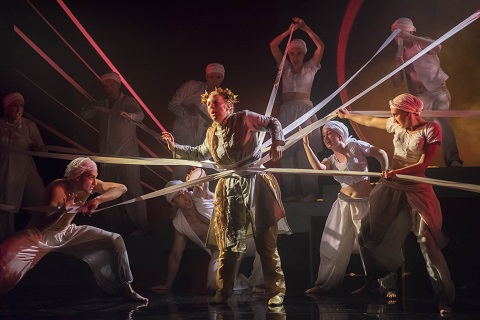 Hanna-Liisa Kirchin (Orfeo) and Chorus/Dancers. Photo credit: Matthew Williams-Ellis.
Hanna-Liisa Kirchin (Orfeo) and Chorus/Dancers. Photo credit: Matthew Williams-Ellis.
One of the disarming novelties of Gluck’s opera, first seen in Vienna in 1762, was that it broke down musical divisions, integrating recitatives, arias, choruses and dances in organic scenic episodes to create true music drama. Jagusz stays true to this ideal, her twelve-strong chorus adopting a movement vocabulary of archaic ritualism. However, while the principals are associated with Greco-Roman emblems - ‘For Orfeo, his golden lyre; for Amore, the bow; and for Euridice a headdress of golden leaves symbolising her position as oak nymph and daughter of Apollo, as told in the Greek rendering of the tale’ - the chorus’s costumes and narrative sign-language are decidedly Bollywood in derivation.
Moreover, these choric gestures were not only sometimes sloppily executed but also seemed to distract the singers from their primary responsibility - that is, singing. Some of the entries were scruffy and their responses to Orfeo’s desperate questions - ‘Where is Euridice?’ - were somewhat hesitant, lacking conviction: less, ‘Euridice is coming!’ and more ‘She’s on the way, perhaps …’
Conductor Jeremy Silver has impressed me in the past, but if he has an instinct for Donizetti then melodrama of the Gluckian kind eluded him on this occasion. There was little grace or serenity about the orchestral playing and if things did improve after the interval that was largely because the woodwinds and horns are less frequently deployed in the latter scenes and the intonation improved markedly. That said, there was some fine harpsichord playing by Julian Perkins and the strings did settle as the performance proceeded.
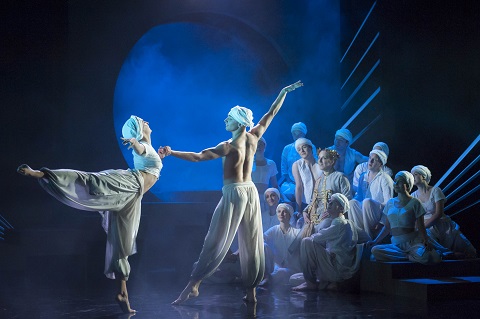 Jordan Scrase and Emily Smith (Blessed Spirits). Photo credit: Matthew Williams-Ellis.
Jordan Scrase and Emily Smith (Blessed Spirits). Photo credit: Matthew Williams-Ellis.
As the mythic quester, Hanna-Liisa Kirchin displayed a mezzo which is not huge but which is sweet-toned and expressive. Interestingly, my guest remarked that at first he was uncertain whether Orfeo was being sung by a countertenor or a mezzo, for Kirchin’s voice does have an unusual colour - one which was most effective in a role initially taken by the castrato Gaetano Guadagni, modified by Gluck for haute-contre tenor when the opera was seen in Paris, and which has since been sung by every voice type from soprano to baritone (Dietrich Fischer-Dieskau recorded the role for Deutsche Grammophon in 1982). Kirchin worked hard in ‘Che farò senza Euridice’: her voicing of loss was dignified and imbued with wrenching pain, although sometimes at the expense of seamless, expansive phrasing.
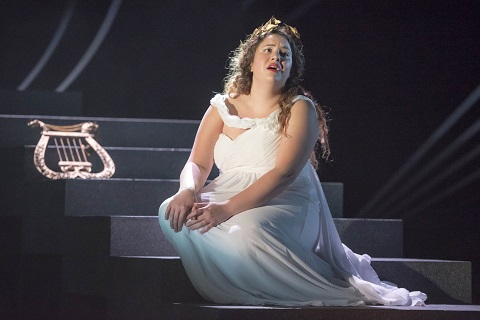 Nazan Fikret (Euridice). Photo credit: Matthew Williams-Ellis.
Nazan Fikret (Euridice). Photo credit: Matthew Williams-Ellis.
If the ritual formality of the production limited the opportunities for interaction, then Kirchin’s duet with Nazan Fikret’s Euridice was a highlight. Fikret’s soprano may not have captured all of Euridice’s graciousness but her voice has a brilliance which was vivifying. More touching still, though, was the Hamlet-like dance-mime during the ‘Dance of the Blessed Spirits’ by Jordan Scrase and Emily Smith, which relived the opera’s narrative of tragic loss and restoration.
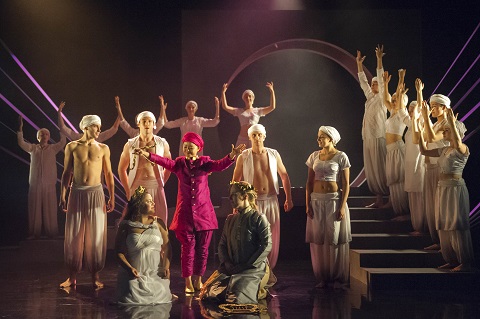 He Wu (Amore). Photo credit: Matthew Williams-Ellis.
He Wu (Amore). Photo credit: Matthew Williams-Ellis.
As a crimson-suited Amore, soprano He Wu brought brightness to the drama, visually and vocally, though occasionally she exhibited a slight tremor in the voice. Diminutive of stature, Amore was easily hoisted onto the shoulders of Jack Holton’s statuesque Spirit, Wu’s golden wings unnecessary.
Jagusz’s production certainly confirmed the artistic power of economy, and the young singers acquitted themselves well.
Claire Seymour
Gluck: Orfeo ed Euridice
Orfeo - Hanna-Liisa Kirchin, Euridice - Nazan Fikrit, Amore - He Wu, Charon/Spirit - Jack Holton, Blessed Spirits - Jordan Scrase and Emily Smith, Director - Maria Jagusz, Conductor - Jeremy Silver, Designer - Richard Studer, Lighting Designer - Dan Saggars, Assistant Director - Ralf Higgins, Choreographer - Mark Smith, Orchestra and Chorus of Longborough Young Artists (Shepherds, Nymphs, Furies, Demons of the Underworld, Heroes and Heroines of Elysium, Companions of Orfeo),
Greenwood Theatre, King’s College London; 4th August 2017.
image=http://www.operatoday.com/Hanna-Liisa%20Kirchin%20%28Orfeo%29%20cr%20Matthew%20Williams-Ellis%20%281%29.jpg image_description=Orfeo ed Euridice, Longborough Festival Opera Young Artists product=yes product_title=Orfeo ed Euridice, Longborough Festival Opera Young Artists product_by=A review by Claire Seymour product_id=Above: Hanna-Liisa Kirchin (Orfeo)Photo credit: Matthew Williams-Ellis
August 5, 2017
A Master Baritone in Recital: Sesto Bruscantini, 1981
This is one of the latest releases in an extensive CD series on the Bongiovanni label entitled “Il Mito dell’Opera,” a phrase that can be freely translated as “Legends in the Opera World.” The CD consists mainly of a recital that Bruscantini and pianist Fabio Maestri gave in Ancona (Italy) in 1981. Some collectors may own the original LP release.
The recital offers, in very good sound, verbally alert and musically smooth readings of baritone arias—usually the most famous ones—from seven Italian operas (by Cimarosa, Mozart, Donizetti, plus Ford's aria from Verdi's Falstaff), as well as two well-known songs by Tosti. The hall seems to have been a small one, and the singer, though 62 years old, does not force his voice, which in fact sounds quite well preserved.
These recordings offer model lessons for any young singer—and of course especially a baritone—on how to handle Italian and comic inflection. The only unusual bit of repertoire turns out to be a charmer: a tuneful “Le figliole che so' de vent’anni” from Cimarosa's Le astuzie femminili.
The recording ends with what the jewel case calls a bonus section, presumably not included on the LP: excerpts from live operatic performances of Renato's two arias from Un ballo in maschera and of three excerpts from Puccini's Tosca. Two of the latter fade out disconcertingly, but the concluding section of Act 1 (“Tre sbirri, una carozza” and the subsequent “Te Deum”) stands very well on its own. These opera-house excerpts were recorded in “1973-1978” (i.e., when the singer was 54 and 59 respectively). The voice, engaged at full volume, sounds more worn than in the recital of a few years later, and is sometimes not fully captured by the microphones (whereas the orchestra comes through clearly).
Even in these somewhat problematic bonus tracks, though, we gain a fine sense of how a smart singer was able to husband his resources through a long and distinguished career. Lovers of Italian opera and good Italian-style singing will take much pleasure in this engaging and gratifying CD and may be happy to learn, or be reminded, of Bongiovanni’s valuable “Mito” series.
Ralph P. Locke
The above review is a lightly revised version of one that first appeared in American Record Guide and appears here by kind permission.
Ralph P. Locke is emeritus professor of musicology at the University of Rochester’s Eastman School of Music. His most recent two books are Musical Exoticism: Images and Reflections and Music and the Exotic from the Renaissance to Mozart (both Cambridge University Press). Six of his articles have won the ASCAP-Deems Taylor Award for excellence in writing about music. He edits Eastman Studies in Music, a book series published by University of Rochester Press.
image=http://www.operatoday.com/Sesto%20Bruscantini.png image_description=Il mito dell’opera: Sesto Bruscantini product=yes product_title=Il mito dell’opera: Sesto Bruscantini product_by=Sesto Bruscantini and others product_id=Bongiovanni 1236 [CD] price=$14.99 product_url=http://www.arkivmusic.com/classical/album.jsp?album_id=2178687
Emalie Savoy: A Portrait
Here we have the first CD to be released in the series. It features the American soprano Emalie Savoy, first-prize winner in the vocal category during the 2015 competition. Over the course of the CD, Savoy demonstrates great vocal artistry and an ability to handle a wide range of roles and song literature, both with orchestra and with piano. The CD is a bit short (53 minutes), but the five pieces that it includes are undoubtedly meaty: Ravel’s Shéhérazade; one aria each from Tchaikovsky’s Iolanta, Dvořak’s Rusalka, and Weber’s Der Freischütz; and a complete performance of Barber’s Hermit Songs, a cycle of ten short but trenchant settings, for voice and piano, of poems by medieval Irish monks. (Click here to hear Savoy sing the famous “Song to the Moon,” from Rusalka.)
Savoy, from Schenectady NY, has a full and generally firm voice which is lustrous when soft and becomes exciting, yet not edgy, on full-throttle high notes. She was well trained at Juilliard (Bachelor’s and Master’s) and has completed the Lindemann Young Artists Program at the Met. I am impressed that a large voice can handle the melismatic passages in the Weber cabaletta so well. In that same cabaletta, Savoy also shows that she is well informed about how to resolve appoggiaturas. (Click here to hear her do the Weber aria.)
Savoy has sung secondary roles at major houses such as the Met and the renowned Grand Théâtre in Geneva, Switzerland (e.g., Sylviane in The Merry Widow and the First Lady in Die Zauberflöte), and leading roles at Juilliard and regional venues (e.g., Mozart’s Countess at the Castleton Festival in Virginia). From what I hear on this CD, her voice would easily fill a big hall. Savoy sings with evident understanding in all the selections. (Click here for the first song in the Ravel.) The Brandenburg State Orchestra plays wonderfully here, as does pianist Jonathan Ware in the Barber songs. (The orchestra’s home is in Frankfurt an der Oder—a smallish city about 300km to the southeast of Berlin, just across the river from Poland.)
I must also report some weaknesses. Though Savoy rarely if ever mispronounces words in any of the five languages on display here (or at least in the three languages that I know well enough to judge), she does not always enunciate clearly. I had trouble catching about half of the text in the Barber, even in certain songs that I have heard many times before. Perhaps the very richness of Savoy’s voice is an impediment. Some long notes also show a slow vibrato that, at least at this point in her development, is not wide but might become an obtrusive wobble over time. I hope I am wrong.
The orchestra is sometimes recorded too far in the background, making the singer an almost overbearing presence. A few times I had to replay a passage in order to hear fully what the orchestra had just contributed. There is at times, in the Weber, a loud and long echo that can compete with the singer’s next notes. In the Hermit Songs, the cavernous echo makes the piano clattery. (Click here for the third song from the cycle, “St. Ita’s Vision.”) On the 1954 studio recording of that cycle with Leontyne Price and the composer (monophonic, still available on Sony), voice and piano are perfectly balanced, and Price conveys the words beautifully. Alas, the RCA Victor recording that preserves the work’s premiere performance at the Library of Congress (likewise with Price and Barber) was recorded wanly, though I have read that its re-release on Bridge is somewhat improved. (That world-premiere performance by Price and the composer can be sampled by clicking here: again, Song no. 3: “St. Ita’s Vision.”)
In short, this is an excellent introduction to a gifted new singer, who could potentially be singing major roles at major houses. She reminds me of another big-voiced soprano, Angela Meade, who jumped, directly and successfully, from the Met Auditions to singing the main female role in Verdi’s Ernani at the Met. Savoy handles well very different kinds of music from across the nineteenth century and into the mid-twentieth. The CD gave me much pleasure, though, almost inevitably, from a collector’s point of view, many of the items on it are performed at least as well elsewhere. I would not want to live without Régine Crespin’s classic recording of Shéhérazade (conducted by Ernest Ansermet).
Full texts in the original languages and in English. The program notes interestingly point out how the five works here all treat the theme of loneliness. Unfortunately, the English translations throughout the booklet are sometimes unidiomatic or even wrong: “principal” becomes “principle,” and the song title “L’Indifférent” gets translated as “The Different One” instead of “The Indifferent One.”
Ralph P. Locke
The above review is a lightly revised version of one that first appeared in American Record Guide and appears here by kind permission.
Ralph P. Locke is emeritus professor of musicology at the University of Rochester’s Eastman School of Music. His most recent two books are Musical Exoticism: Images and Reflections and Music and the Exotic from the Renaissance to Mozart (both Cambridge University Press). Six of his articles have won the ASCAP-Deems Taylor Award for excellence in writing about music. He edits Eastman Studies in Music, a book series published by University of Rochester Press.
image=http://www.operatoday.com/Emalie_Savoy.png image_description=Emalie Savoy: A Portrait product=yes product_title=Emalie Savoy: A Portrait product_by=Emalie Savoy, Sopran; Brandenburgisches Staatsorchester Frankfurt; Matthias Foremny, Dirigent; Jonathan Ware, Klavier. product_id=GEN 16436 [CD] price=$18.99 product_url=http://www.arkivmusic.com/classical/Name/Emalie-Savoy/Performer/293701-2
Full-throated Cockerel at Santa Fe
The answer is a scintillating version of Rimsky-Korsakov’s rarely performed The Golden Cockerel as lustrously presented by Santa Fe Opera, of course. To succeed with this sometimes knotty and often naughty piece you really need two stars that can carry the evening and boy, did SFO have them in spades.
The remarkable baritone Tim Mix sings and fidgets up a storm in a tireless vocal and physical tour de force as Tsar Dodon. His was just the right ‘Mix’ of buffoonery and bravado, and he skillfully used his sizeable instrument to create an indelible vocal characterization. But Mr. Mix is also capable of important moments that are not larger-than-life, namely, beautiful phrases that bring some humanity to the bumbling monarch. Later in the show, as power has corrupted him, Tim limns his rock solid pontifications with an arrogant cynicism. This is a beautifully schooled voice, a very musical performer, and a committed, inventive actor.
There cannot be a lovelier Queen of Shemakha on this planet, or any planet anywhere, than the delectable Venera Gimadieva. She is a petite, poised, beautiful woman with an alluring physical presence. Is there any other soprano who could pull off (pun intended) a striptease, ending up looking ravishing in a brief two-piece harem get up? And she sings, too!!
Ms. Gimadieva has a sparkling lyric soprano that falls very warmly on the ear on a cool desert mountain night. She has a splendid sense of line and soars above the staff ‘with’ ease, and ‘to’ E’s. Her coloratura is faultless, and her playful way with comic phrases infuses her singing with obvious joy. Moreover she immerses herself into the drama with gusto.
Her shameless, uninhibited vamping of the Tsar was a sensual laff riot. As she invited him over to “her place,” she lustily extolled her tight tent that would enfold him, and promoted the comforts of her furry rug. Guilty (musical) pleasures, indeed. But there was far more to her Queen than shimmies and breast jokes. Venera could turn deadly serious and downright sadistic when called for, whence she successfully weighted her generous soprano with ominous shadings. With this starry match of two stars made in heaven, we truly were in a land of enchantment.
Barry Banks was born to play the Astrologer. The extremely high tessitura of the part holds no terrors for him, and Mr. Banks sang the stratospheric declamations with assured beauty of tone. Coming down from the heavens as Amelfa, Meredith Arwady reveled in vocalizing in the basement. Hers is a nonpareil contralto voice, which is as big as all outdoors: She could be probably be heard in Albuquerque. Happily, Ms. Arwaday is a superb musician, and she weaves her registers and phrases together seamlessly. As the earthy housekeeper, Meredith immerses herself into a bawdy interchange with the Tsar that finds no erogenous zone unmentioned and untouched, all the while singing with potent beauty.
Kevin Burdette can always be counted on to bring his secure bass singing and complete dramatic investment to the proceedings. His assertive, doomsday spouting General Polkan captured just the right combination of wiry physicality and solidly voiced predictions. Apprentice Singers Richard Smagur (Prince Guidon) and Jorge Espino (Prince Afron), more than held their own, imbuing these roles with far more than the usual comprimario natterings. Mr. Smagur has an attractive lyric tenor with a vivid presence, and Mr. Espino sports a virile, ringing baritone. Another Apprentice, Kasia Borowiec, heard but not seen, offered assertive, secure soprano pronouncements as the Golden Cockerel.
Conductor Emmanuel Villaume worked wonders in the pit. The composer was, of course, a master orchestrator and Maestro Villaume mined every ounce of color and excitement out of this diverse score. The ensemble work was ravishing, with the solo work also notable for its characterful flair. The first chair winds were especially exceptional, and their zesty licks added much to the evening’s exotic charms. Villaume led an expansive romp of a reading, sensitive to his soloists and skillful in his handling of the amassed forces, including Susanne Shelton’s suave chorus.
Past successfully met present in the design concept, with Gary McCann’s set a metallic stylized playing space that was a handsome sculpture. A raked square extended and swept up toward the loft stage right, suggesting a high-toned skateboard ramp. For Act II, a massive series of rings and girders was placed upstage suggesting a vertical stacking of roller coaster loops interpreting a rooster’s tail. Smart, eye-catching and effective.
McCann the costume designer created Russian folk (and royalty) wear that provided a riot of color and Old World Atmosphere. The Queen’s afore-mentioned peacock blue diaphanous gown with gold accents, peeled away in layers to reveal a flattering two-piece nod to orientalism. The Tsar was presented as the emperor that has no clothes, caped but beer-bellied in his red BVD’s, an inspired touch. There is a clever costume reveal near the very end with a complete change in tone and period, which I can commend without giving away.
Paul Hackenmueller has provided the premiere lighting design of the festival, with changeable color washes, dramatic use of down and side lighting, discreet deployment of spotlights, and excellent sensitivity to the variable moods. Driscoll Otto devised remarkably apt projections that were really the glue that holds all the elements together. One moment witty and cartoonish, the next lavish folk patterns, the next a swirling galaxy, Mr. Otto’s sterling work was critical to the evening’s impact. But inherent in the skewed placement of the sweeping stage-within-a-stage is the difficulty that the projections requiring the upright “screen” of the stage right “skateboard” to function, are unable to be seen by the 20% of the patrons fanning out house left. Pity that such tremendous work imposed that limitation on itself.
Director Paul Curran has dreamt up a plethora of exhilarating stage business. The Tsar, in BVD’s, is first revealed rising up from a trap, legs splayed sitting on an oversized red velvet and gold throne. If you’re old enough, think Edith Ann on the rocking chair on Laugh In. Nutty, nutty stuff. The King, his doltish sons, General Polkan, and even housekeeper Amelfa scampered on and off this huge piece, ducking under armrests, standing on the seat, jumping to the floor, and climbing back up on the rungs of the braces over and over again. I think the cast must have had to pass a physical exam at a climbing gym. It was as constantly entertaining as it must have been exhausting.
The Queen of Shemakha was announced and accompanied by a bevy of white clad showgirls brandishing white ostrich plume fans, a visual occurring twice in the week’s festival line-up (Fledermaus was the other). What are the odds of two shows in a five opera festival utilizing copious ostrich plume fans? Wish I had had the ostrich plume fan concession. Mr. Curran not only used the chorus creatively to fill longer orchestral passages with meaningful visualization, but also devised lively interplay between the principals that became more sedate as the stakes were raised.
The abundant delights of The Golden Cockerel were such that I didn’t want the noisy bird to wake me up from a production that was a true midsummer night’s dream.
James Sohre
Cast and production information:
Astrologer: Barry Banks; Tsar Dodon: Tim Mix; Prince Guidon: Richard Smagur; General Polkan: Kevin Burdette; Prince Afron: Jorge Espino; First Boyer: Adam Bonanni; Second Boyer: Simon Dyer; Golden Cockerel: Kasia Borowiec; Amelfa: Meredith Arwady; Queen of Shemakha: Venera Gimadieva; Conductor: Emmanuel Villaume; Director: Paul Curran; Set and Costume Design: Gary McCann; Lighting Design: Paul Hackenmueller; Projection Design: Driscoll Otto; Chorus Master: Susanne Sheston
image=http://www.operatoday.comCockerel_SantaFe1.png
product=yes
product_title=The Golden Cockerel at the Santa Fe Opera
product_by=A review by James Sohre
product_id=Above: Brenda Rae as Lucia [All photos copyright Ken Howard, courtesy of Santa Fe Opera
August 3, 2017
Santa Fe’s Trippy Handel
One unwavering element in this long (3-1/2 hour) evening was the excellence of the musical execution. Chief Conductor Harry Bicket led a magnificent instrumental ensemble who responded with a richly detailed reading that was as diverse in its colorful effects as it was supple in its rhythmic propulsion. Maestro Bicket is justifiably renowned for his way with this genre of course, and his baton inspired all concerned to music making of the highest order. The cast of singers was also decidedly first tier.
In the title role, the elegant soprano Elza van den Heever has conquered another Everest role in her growing reputation and repertoire. Her well-modulated voice has just a hint of steel in it that serves her well in the sorceress’s furious outbursts. Sometimes though, her dramatic immersion turns otherwise creamy tone a tad shrill. Her soft singing was wonderfully controlled and she could skillfully draw us in with a messa di voce that scaled down to a near whisper, even if in the process of these melting piano phrases she did sometimes dispense with consonants. Ms. van den Heever’s phrasing and breath control, her meticulous passage work, her passionate dramatic investment, and her fluid physical movement, all combined to create an impactful musical characterization.
Daniela Mack was a dynamo (dynama?) as the conflicted Bradamante. Ms. Mack is a major talent with a luminous mezzo that easily encompasses the divergent demands of this challenging part. Her astonishing, fearless coloratura fireworks threaten to out-Cecelia the great Bartoli. Her melting laments pierce the heart. Her dramatic commitment informs her distinctive vocalizing to create a memorable role traversal.
Paula Murrihy, a witty Orlovsky in Fledermaus, turned on a stylistic dime to offer a superlative account of another trouser role, Ruggiero. Her splendid phrasing, enchanting timbre, and meticulous technique proved a bewitching combination, allowing her to spin out wondrously sustained vocal lines, and toss off beautifully calculated melismas, peppered with florid ornamentations and even surprising staccato effects. Ms. Murrihy’s plush, vibrant treatment of her arias was rewarded with some of the evening’s most sustained ovations.
As expected, soprano Anna Christy was once again her delightful self as Morgana, animated in her stage presence, and singing with soaring lyricism and absolute precision. Ms. Christy has to be one of operadom’s most endearing soubrettes, possessed of an impeccable technique and a vocal quality characterized by an agreeable silvery glow. Anna seems to be having the time of her life and is happy to take us along for the ride.
Handel does not give Melisso a great deal to do, but we were grateful that Christian Van Horn was on hand to do it. Mr. Van Horn’s solid, individualized bass was a welcome occasional balance to all the higher voices, and his accusatory aria was fluidly and powerfully delivered. Alek Schrader’s characterful tenor was deployed to create a distinctive Oronte. Past roles have proven Mr. Shrader can be an inspired physical comedian, and his proclivity for pratfalls and manic movement was on ample display here. He must also be the only tenor in history who, in one performance, is required to sing beautifully while a) holding a cigarette in his mouth; b) executing a repetitive dance step recalling “The Pony;” and c) jumping up and down in an ape suit. The role of the boy Oberto seems almost an after thought, but Jacquelyn Stucker performed it most charmingly, showing off a winsome demeanor and a honeyed soprano.
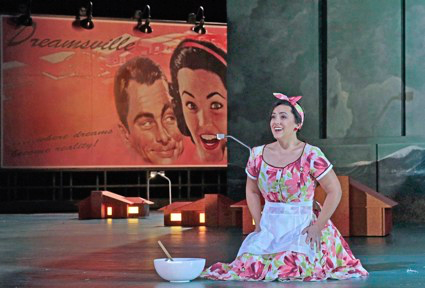 Anna Christy as Morgana
Anna Christy as Morgana
I eschewed LSD in the 60’s, preferring clearheaded operatic studies to an acid trip. Thanks to stage director David Alden, I may have now made up for missed hallucinogenic experiences. Mr. Alden is well known for his post-modernist takes on opera, and he seems to delight in raising more questions than he answers. Together with his design team (set and costumes, Gideon Davey; lighting, Malcolm Rippeth), he has redefined “sensory overload” with a cornucopia of images that would cross Hieronymus Bosch’s eyes. I suppose a magical island can be anything it wants to be, but does it have to be anything and everything? In this case, we are supposedly “in an abandoned theatre.” (Sort of presaging the Crosby Theatre after the second intermission.)
Sure enough, there is a small, ornate white proscenium frame and platform down right, and a long wall of doors the width of the stage just above it. Soon after the downbeat, a few Roxy-like ushers appear (one of them will be Morgana), bizarre Night-of-the-Living-Dead acrobats start clambering over the house walls, and Bradamante (in brown business suits and fedora) and Melisso (as flash camera wielding paparazzo) stroll from the back of the house down the left aisle to the pit railing. All of this was very difficult to see, and impossible to figure out. It did establish the level of clarity for the evening! Not to say that there were not many entertaining moments. Many.
The row of doors came and went, often amusingly deployed with a Keystone Kops chase effect. A performer would disappear through the far left door during an instrumental break, a befuddled character would be left to ponder the colleague’s exit, then the character would re-enter in time to sing again through the far right door, “surprising” the befuddled colleague. You get the drift. This running gag was actually well used, and some of Mr. Rippeth’s trapezoidal lighting effects were wondrously moody.
Once the wall of doors retreated off right, we got into more problematic collages of imagery. It seemed we were now perhaps trapped at A Night in the Museum. Primal artifacts like dinosaur skeletons, fossilized remains, primate extras in ape suits and the like dotted the expansive stage. A “chandelier” suspended over center stage consists of a spinal column culminating in a bony claw from which a bare bulb ghost light is hung. Just try and get that image out of your head now.
And wait a minute, there is a diagonal wall running from down left to up center, on which is reproduced Hokusai’s The Great Wave off Kanagawa. Adding to the confusion, panels soon part in this mural to reveal another stage, with green grand drape, on which action will be played. So we are in an abandoned theatre that “may” be a museum that has a stage of its own, but hold on, let’s throw in an oceanic image to suggest the original island setting, and add a whole lot of evolution-of-the-species implications. And let’s sing Handel while doing it! Too bad George didn’t write Lucy in the Sky with Diamonds. Oh wait, one George was involved in that. . .
Designer Davey also had a field day with his costumes. Yes, Oronte is in and out of a Planet of the Apes suit. Bradamante trades in “his” well-tailored business drag for a handsome cocktail dress and later, in Act III, wears a multi-colored 50’s sitcom ‘mom frock’ with bandana. Morgana is a bespectacled usher, before a wannabe siren, before a Vegas showgirl, before . . .well, how can I be expected to remember? Alcina is most usually in a becoming, slinky black gown, with her “magic wand” signified by her right hand sporting a long neon pink satin glove. This is oddly (and I am sure intentionally) phallic. During Alcina’s tour de force aria closing Act II, Mr. Alden has extras poke pink gloved hands out of the cracked doors in choreographed precision, then they appear over the wall of doors, and then pink gloves begin to trickle from the flies, before raining down on the poor dear, pelting her into a mad cackle at aria’s end.
Did I mention the frequent, tightly performed choreography devised by Beate Vollack? I have to concede this whole lengthy evening was extremely well rehearsed, no more so than Ms. Vollack’s eclectic dances which ranged from Steve Martin “Happy Feet” pattering, to line dancing, to ballroom pairings, to Ms. Christy’s lavish peacock-fanned parody of All I Care About is Love.
Along this Magical Mystery Tour, we were at one point in a science laboratory, with the upstage “stage” backdrop now covered with cave paintings as might have been created by Keith Haring. Aluminum appointments included a sink, which I would like to believe is the “everything-but-the-kitchen-sink” that was now not missing in the eclectic mix after all. Favorite goof of the night found a gorilla-suited extra as Atlas bearing a disco ball “globe.”
Surprisingly, very little of this (mostly) inspired lunacy was a distraction to the musical excellence, and the game performers found a way to commit to the physical staging demands while still singing very effectively. Too, there were several still moments that were arresting in their simplicity. In fact, there may have arguably been a few too many slow, wispy, introspective passages. In a long evening, a bit more pace and presence might have improved what is already quite a good thing.
Of future consideration for producers should be the length of productions, especially one with repetitive arias like these. The parking lot was notably emptier after the second intermission. Perhaps some judicious pruning, and combining the evening into two acts (as is often done in Europe) is an answer to not only keep audiences engaged in the performance at hand, but also to keep them coming back for similar offerings. This Alcina was an entertaining, musically rewarding, and thought provoking evening, which for many reasons will be recounted for years to come.
James Sohre
Cast and production information:
Bradamante: Daniela Mack; Melisso: Christian Van Horn; Morgana: Anna Christy; Oronte: Alek Schrader; Alcina: Elza van den Heever; Oberto: Jacquelyn Stucker; Ruggiero: Paula Murrihy; Conductor: Harry Bicket; Director: David Alden; Set and Costume Design: Gideon Davey; Lighting Design: Malcolm Rippeth; Choreograpy: Beate Vollack
image=http://www.operatoday.com/Alcina_SantaFe1.png
product=yes
product_title=Alcina at the Santa Fe Opera
product_by=A review by James Sohre
product_id=Above: Daniela Mack as Bradamante, Elza van den Heever as Alcina [All photos copyright Ken Howard]
August 2, 2017
Santa Fe’s Crowd-Pleasing Strauss
Never mind that the nose-tickling sensation of champagne had been shunted for the foam mustache on your upper lip from a freshly drawn Pilsener. Or, that instead of savoring caviar, the performers were gleefully nibbling scenery. Or, that elegant Straussian effervescence had been supplanted by Offenbachian bacchanalia by way of The Producers.
An artistic decision was made, and the talented Team Fledermaus jumped in with both meticulously choreographed feet and, hell bent on having a party, succeeded in creating one. And we willingly went along for the ride.
Allen Moyer’s witty set design couldn’t help but remind me (happily) of Edward Gorey’s 1970’s Dracula. A large cartoonish bat hangs above the action, looming over the proceedings. Rows of bat silhouettes dot the receding sidewalls, elegant door units and richly evocative furniture dot the stage, and playful Upper Society outfits are provided for our visual delight by costumer Zack Brown assisted by Christianne Myers.
Duane Schuler’s brightly colored lighting design highlights the upbeat approach, and occasional comic thunder-and-lightning illumination of the ominous bat were a terrific running gag. Yes, it looks and walks like a standard issue Strauss operetta. But it quacks like a musical farce.
And when it comes to “quacking jokes,” no one embraces this approach more winningly than Dimitri Pittas, who not only sings Alfred with a leading tenor’s sheen, but also acts him with inspired lunacy. The over-the-top, trilled-Rrrrrr accent was consistently engaging, and his shameless, self-aggrandizing interpolation of snippets of famous tenor arias won some of the evening’s best laughs. Mr. Pittas has distilled his approach from other successful appearances in the part, and he completely knows his way around the character, as evidenced by a definitive portrayal.
Devon Guthrie was a lovely Rosalinda and she is no slouch in the comic delivery area, especially when effecting a hilariously bogus Hungarian ekk-sent. Her beautifully modulated soprano found all the lyricism in the role, as well as the effortless lilt and luster required. If the Czardas did not quite ignite, in spite of being richly vocalized, it may be owing to some clumsiness in the English translation.
The venerable Kurt Streit was a multi-faceted Eisenstein. Although his well-seasoned tenor started the evening accurate but a bit dry, Mr. Streit soon progressed into the familiar warm, suave singing we have come to expect. I am a huge Jane Archibald fan, a singer who has dazzled me on numerous occasions. Adele should have been a natural fit for her demeanor and awesome technique. Ms. Archibald sang with all her customary flexibility and crystalline tone, but her insouciance seemed a little vulgarized in this interpretation. Her party aria was excellently sung and conscientiously enacted but curiously muted.
As Dr. Falke, Joshua Hopkins was the finest vocal accomplishment of the night. Mr. Hopkins has a glistening, malleable baritone of exceptional beauty, and he has the technique to exploit its full range of expressive possibilities from comic bluster to melting beauty. Joshua also cuts a dashing figure, can nail a punch line, and is quite a hoofer.
Paula Murrihy was quite the androgynous, gender-bending Prince Orlovsky. Ms. Murrihy’s silken mezzo was almost upstaged by her oh-so-carefully enunciated, goofily accented dialogue. Her total immersion into the decadent ennui of this spoiled playboy was richly entertaining. Stephen Carroll’s resonant tenor and easy demeanor made for a pleasing turn as Dr. Blind. David Govertsen brought his impactful bass-baritone to bear as a fine Frank. Adelaide Boedecker was the spunky, chirpy Ida, and Kevin Burdette scores his laughs as Frosch.
To my taste, or perhaps from my vantage point under the balcony overhang, conductor Nicholas Carter narrowly missed the heady, soaring bounce of this masterpiece. The first, rising chords seemed muted, and talented as they are, the band just didn’t seemed to ignite a Viennese point of view. Mr. Carter’s assured baton was firm and accommodating, and he managed the evening skillfully. But while his spirit may have been willing, the Lust seemed weak.
Director Ned Canty, abetted by inventive choreographer Seán Curran chose to pace the evening as a rather relentless farce. There were enough good ideas for three productions of Spamalot, and a couple of misfires that even Young Frankenstein might have rejected. But small matter, when Die Fledermaus is this well sung, and the commitment to having fun is so total, I confess I laughed too. (Even if I sometimes hated myself for it.)
James Sohre
Cast and production information:
Alfred: Dimitri Pittas; Adele: Jane Archibald; Rosalinda: Devon Guthrie; Gabriel von Eisenstin: Kurt Streit; Dr. Blind: Stephen Carroll; Dr. Falke: Joshua Hopkins; Frank: David Govertsen; Ida: Adelaide Boedecker; Prince Orlovsky: Paula Murrihy; Frosch: Kevin Burdette; Conductor: Nicholas Carter; Director: Ned Canty; Set Design: Allen Moyer; Costume Design: Zack Brown; Co-Costume Design: Christianne Myers; Lighting Design: Duane Schuler; Choreographer: Seán Curran; Chorus Master: Susanne Sheston
image=http://www.operatoday.com/Fledermaus_SantaFe1.png
product=yes
product_title=Die Fledermaus at the Santa Fe Opera
product_by=A review by James Sohre
product_id=Above: Paula Murrihy as Prince Orlovsky [All photos copyright Ken Howard]
Santa Fe: Mad for Lucia
Ms. Rae not only has all the fireworks in her arsenal to effortlessly negotiate the roulades, trills, arpeggios, embellishments and melismas, but also has a poised, polished, bell-like soprano, freely produced and serenely secure. While hers is not an overly large lyric instrument, the clarity of her technique gives it great impact in the house.
Her attractive physical presence lends for a totally believable, love torn young woman, and she can suggest a tortured victimization and highly affecting fragility. Brenda finds every dramatic nuance in a generous, musically faultless realization, in short, a wholly winning traversal of one of the repertoire’s “gold standard” roles. Having scored successes in Frankfurt, Munich and now, Berlin, Brenda Rae seems to be on a career trajectory that echoes, without mimicking Diana Damrau. Ms. Rae offered exceptional singing.
Offering even more in the way of an individualized, characterful role assumption, bass Christian Van Horn gave his finest performance that has reached my ears to date as Raimondo Bidebent. Just as Mr. Van Horn physically towers over the other performers, his rolling, eloquent bass asserts itself with an imposing, visceral presence. His every appearance was a cause for bel canto celebration.
Zachary Nelson finds a very happy fit for his gleaming Italianate baritone as the manipulative brother Enrico Ashton. Mr. Taylor offers ear and eye candy in his second, um, appearance, as a comforter is turned down on his bed, revealing his reclining buff upper torso, prompting much raising of binoculars. Zachary’s potent stage presence was wedded to mellifluous singing deployed with focused dramatic intent.
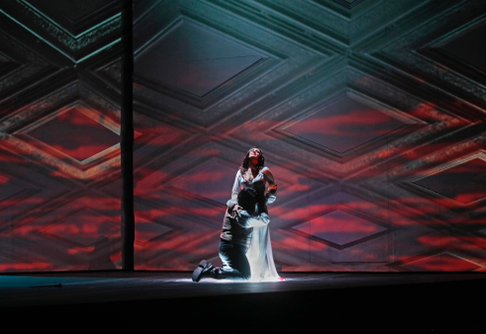 Brenda Rae as Lucia,
Brenda Rae as Lucia,
Mario Chang as Edgardo
I quite liked Mario Chang’s Edgardo, which featured a warm, pointed lyric sound, and a good sense of line and phrasing. If Mr. Chang pressed a little hard at times, or lumbered a bit through the occasional high lying passage, this was nonetheless a commendable take on a treacherously difficult role. I encourage Mario to take a lesson from other tenors of similar physical type, and cultivate a more engaging vocal charm that will elevate the romantic exchanges into more meaningful theatre.
Three Apprentice Artists covered themselves in glory: Sara Coit’s warm, solid mezzo and Carlos Santelli’s gleaming tenor shone in solo lines and added immeasurable depth to the famous sextet. The role of Normanno was well-served by tenor Stephen Martin’s poised singing. Chorus Master Susanne Sheston’s chorus was musically pleasing and dramatically engaged.
Conductor Corrado Rovaris led an incisive, propulsive interpretation. At first, I thought it might be a little too restless and driving, but the Maestro knew exactly how to balance the evening’s set pieces. Rovaris flawlessly partnered with his soloists to relax and indulge the romantic revelry and reflective solos, even as he turned up the heat again for some riveting dramatic confrontations. The orchestra played with stylistic acumen. Worthy of special mention is Friedrich Heinrich Kern’s atmospheric playing of the glass harmonica, a rare treat in the Mad Scene.
The design seemed to straddle two worlds. Riccardo Hernandez has crafted a rather simple, 21st Century set design consisting of two large side walls creating a V-shape that can retract to reveal another wall up stage center. They are imbedded with well-concealed rows of large doors that occasionally open to create a colonnade effect. Alas, in an attempt to make them into a seamless wall when desired, the doors seem to have been tightly fitted, producing recurring scrunching sounds that get unwanted titters from the audience.
There are cockeyed images of wooden ceiling panels on these walls, suggesting the oppressive, skewed atmosphere of rigid Scottish political intrigues. Peter Nigrini has designed some effective projections overlaid on these panels, evoking greenery, blood, graveyard and more, all of which augmented Christopher Akerlind’s effective lighting, which featured moody washes and meaningful specials. The walls provided excellent reflective surfaces to give the singers even more presence.
With the addition of a clear modern acrylic fountain in Scene Two, and with the look beginning to suggest a B&B Italia showroom, costumer Emily Rebholz kept the piece grounded in tradition with a sumptuous interpretation of palace attire. You had to squint a bit for any touches of plaid (they were there) but, oh my, what a visual feast. The women’s gowns were especially eye-catching and the color palette was suitably luxuriant.
Ron Daniels provided clear, efficient direction. While there were no jarring innovations, neither were there any startling revelations. Mr. Daniels trusted the piece and the luxury of helming some of today’s top interpreters, and kept it simply effective. Lucia’s brandishing of the bloody bed sheet, and her appearance to Edgardo as a bridal spirit after his suicide were nice touches.
Santa Fe Opera seemed to embrace the concept of “yesterday’s opera today.” Traditional elements and stellar performances were married to inventive 21st design components that made for a smoothly integrated, highly engaging rendition of this Donizetti masterpiece.
James Sohre
Cast and production information:
Normanno: Stephen Martin; Enrico Ashton: Zachary Nelson; Raimondo Bidebent: Christian Van Horn; Lucia, Brenda Rae; Alisa: Sara Coit; Edgardo, Mario Chang; Arturo: Carlos Santelli; Condctor: Corrado Rovaris; Director: Ron Daniels; Set Design: Riccardo Hernandez; Costume Design: Emily Rebholz; Lighting Design: Christopher Akerlind; Projection Design: Peter Nigrini; Chorus Master: Susanne Sheston
image=http://www.operatoday.com/Lucia_SantaFe2.png
product=yes
product_title=Lucia di Lammermoor at the Santa Fe Opera
product_by=A review by James Sohre
product_id=Above: Brenda Rae as Lucia [All photos copyright Ken Howard, courtesy of Santa Fe Opera
Janáček's The Cunning Little Vixen at Grimeborn
But a narrow miss doesn’t lead to a triumph of a production, I’m afraid. There is some irony in the fact that the somewhat threadbare and ragged forest in which this production was set mirrored the paucity of magic and fantasy one craves for in this opera. I couldn’t really understand why the woman sat two seats to my left seemed to be helpless with laughter for much of this production when I found it to be largely oppressive, heavy-handed and lugubrious. Some rather clumsy on-stage set changes exaggerated this feeling.
If there was a strength to The Opera Company’s production then it rested in Janáček’s more experimental concepts, such as ballet and mime. These weren’t ideally synchronised - but then neither is nature. Two flies shadowing one another appeared barely symmetrical but were all-the-more realistic for it. The clever, quasi-puppetry of the hens was genuinely very imaginative, and in one of the few instances of light used beyond the glare of headlight white (in this case a muted red) to imitate death and blood-letting it seemed momentarily chilling; red ribbon hanging from severed hen’s heads rippled like streamers of blood. At its worst this opera can seem very fragmented with its very short scenes and at times the production really didn’t know what to make of these minimal pieces of action. It sometimes seemed chaotic, and some entrances felt so brief as to be almost meaningless. It felt like a little more direction, or just magical imagination, was all that was needed to lift the values up a notch.
As is so often the case with this opera, the Act II duet between the vixen and the fox is something of a tour de force. Perhaps the drama and the tension of the scene, which was really rather splendidly sung by Alison Rose (Vixen) and Beth Taylor (Fox) risked being undermined by the sheer cutesiness of their offspring (Janáček really does move this scene along at a frenetic pace). This was by some measure amongst the most assured singing of the evening - it had a nuanced balance of warmth and affection between the two principals that was largely missing elsewhere. Diction was very fine, something which had been a nagging problem with other singers most of the evening, despite the libretto having been sung in English and the cosiness of the venue itself. Olive Gibbs’s Forrester, too, was largely a resonant and clean performance.
The most controversial, and certainly problematic, part of this production was the orchestration. Arranged for a piano quintet Janáček’s score largely felt uncomfortably outside the decade in which it was written - the 1920s. It’s often alluded to how close this particular score is to some of the more Romantic late-Strauss operas but the effect here was to quash notions of Romanticism and instead highlight somewhat darker, more jagged motifs. Janáček uses woodwind in his full score to captivating effect but a piano simply doesn’t replicate this. Nor, it should be said, was colour really highlighted (something that was also emphasised by singers taking on multiple singing roles). This was a mahogany-hued scoring that was psychologically dark and sometimes menacing. The reduction did have the advantage of highlighting the brutalist ostinatos which reflect the less sentimental approach the composer took over his subject but perceptions of the opera were largely changed beyond all recognition.
The Opera Company took a major risk in presenting this particular work as their very first production and in many respects it didn’t quite come off.
Marc Bridle
Alison Rose (Vixen), Camilla Farrant (Cricket, Frog, Hen, Forrester’s Wife, Fly, Fox Cub), Beth Taylor (Dog, Hen, Fly, Fox), Tim Langstone (Mosquito, Rooster, Schoolmaster, Jay), Oliver Gibbs (Forrester), Ashley Mercer (Badger, Priest, Harasta), Abigail Atttard Monalto and Jade Brider (Dancers).
Guido Martin-Brandis (Direction), Oliver Till (Music Direction), Nina von Der Werth (Choreography), Alexander McPherson (Set Design).
1st August, Arcola Theatre, London E8.
image=http://www.operatoday.com/vixen-arcola-001.jpg
image_description=The Cunning Little Vixen, Grimeborn at the Arcola Theatre
product=yes
product_title=The Cunning Little Vixen, Grimeborn at the Arcola Theatre
product_by=A review by Marc Bridle
product_id=
Photo credit: Robert Workman
Handel's Israel in Egypt at the Proms: William Christie and the OAE
Christie conducted the Choir of the Enlightenment and the Orchestra of the Age of Enlightenment in Handel’s original 1739 version of the oratorio, which includes the rarely performed Part One which is essentially ‘The Ways of Zion do mourn’, his Funeral Anthem for Queen Caroline, with new words, and the soloists were all drawn from the ranks of the professional singers in the choir (in Handel’s day the soloists also sang in the choral movements), here they were Zoe Brookshaw, Rowan Pierce, Christopher Lowrey, Jeremy Budd, Dingle Yandell and Callum Thorpe.
Whilst today we think of the chorus as the mainstay of Handelian oratorio, in Handel’s day this was not so and his audience rather expected a dramatic work with lots of solos. This meant that both Israel in Egypt and Messiah failed to please when first presented to the London audience. Messiah eventually did take, but Handel adapted Israel in Egypt very early on by dropping the original part one and adding lots of extra solos. The original Part One (now 'The Lamentation of the Israelites for the death of Joseph') does indeed make a tricky opening to the work as the piece has such a sober intensity about it, and it is a profoundly satisfying work in its own right.
William Christie used rather larger forces than usual, reflecting the wide open spaces of the Royal Albert Hall, with a choir of 49 and an orchestra of 42.
Part One started with a drum beat before the sober symphony. The whole was a remarkable piece of concentrated and intense choral drama. The singers giving us fine sculptural phrases and lovely control. There were moments of drama, and some of quietly hushed intensity, but the overall feel was of the sober sweep of the piece. This was supported by the fine singing, and characterful support from the orchestra. In whatever guise, this is remarkable music and Christie and his performers ensured that it made the maximum effect.
As Handel probably intended, Part Two was a complete change in mood. The choral singers clearly enjoyed the various challenges which Handel gave them in depicting the different plagues. Choruses like 'He spake the word' were not only full of vivid contrasts, but the singers really relished the words like 'flies' and 'lice', whilst 'He sent thick darkness' as very atmospheric, all ending with a wonderfully expansive 'And Israel saw'. Whilst Christie's speed were not excessive, some passages went a quite a pace so that we had some vividly virtuoso choral singing. The solos were similarly characterful with Christopher Lowrey singing with lovely tone, and again relishing the 'frogs', 'blotches and blains'. We also had one of Handel's extra solos which he introduced, 'Through the and so lovely blooming', which was originally from ‘Athalia’. This was rather pastoral and though finely sung by Rowan Pierce, with a lovely clear focussed soprano, it did rather sit oddly in amongst the plagues.
In Part Three, grandeur and rich choral sound gradually gave way to some vivid word-painting, as the chorus described the vicissitudes of Pharaoh's army, with choruses like 'Thy right hand' full of colour. The final chorus was taken at quite a pace, so that the Lord's triumph was not only glorious but full of virtuoso choral singing. The solos and duets were similarly characterful, with Zoe Brookshaw and Rowan Pierce providing to lovely clear firm, yet contrasting voices, in 'The Lord is my strength', whilst Dingle Yandell and Callum Thorpe were similarly terrific in 'The Lord is a man of war' giving us two admirably firm and lithe voices. Jeremy Budd made the various recitatives count, whilst giving us a vivid account of 'The enemy said, I will pursue', taken at quite a tempo. Budd and Lowery provided to lovely intertwining voices in the duet 'Thou in thy mercy'.
I am not sure that the original version of Israel in Egypt will ever become common currency. Though tastes have changed since Handel's day, the large scale, sober lamentation of Part One seems to unbalance the whole. But this was a wonderful opportunity to hear it, with some of the finest choral singing I have heard in a long time, supported by strongly characterful playing, full of crisp detail and elegant line.
The concert is available for 30 days on the BBC iPlayer.
Robert Hugill
Handel: Israel in Egypt (original three-part 1739 version)
Zoe Brookshaw, Rowan Pierce, Christopher Lowrey, Jeremy Budd, Dingle Yandell, Callum Thorpe, Choir of the Enlightenment, Orchestra of the Age of the Enlightenment, William Christie (conductor)
BBC Proms at the Royal Albert Hall; Prom 2
image=http://www.operatoday.com/Prom%2023_CR_BBC%20Chris%20Christodoulou_%203.jpg image_description=Prom 23: Handel’s Israel in Egypt product=yes product_title=Prom 23: Handel’s Israel in Egypt product_by=A review by Robert Hugill product_id=Above: William Christie conducts the Choir and Orchestra of the Age of Enlightenment in a performance of Handel’s Israel in Egypt at the BBC Proms at the Royal Albert HallPhoto credit: Chris Christodoulou